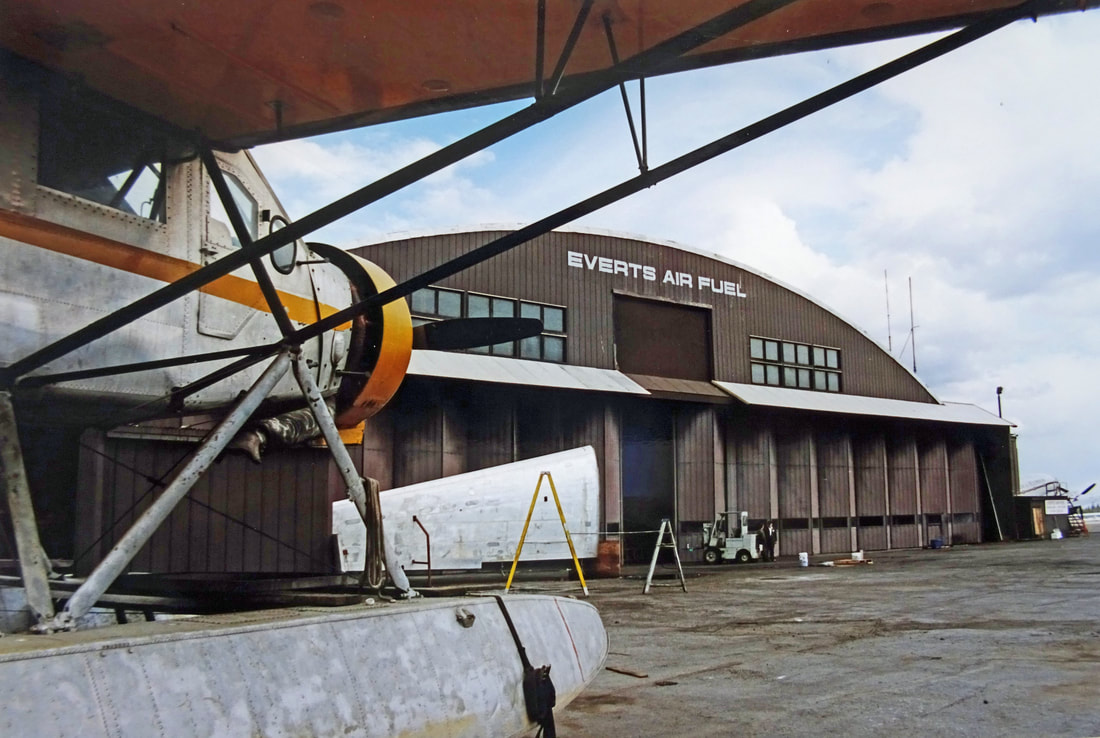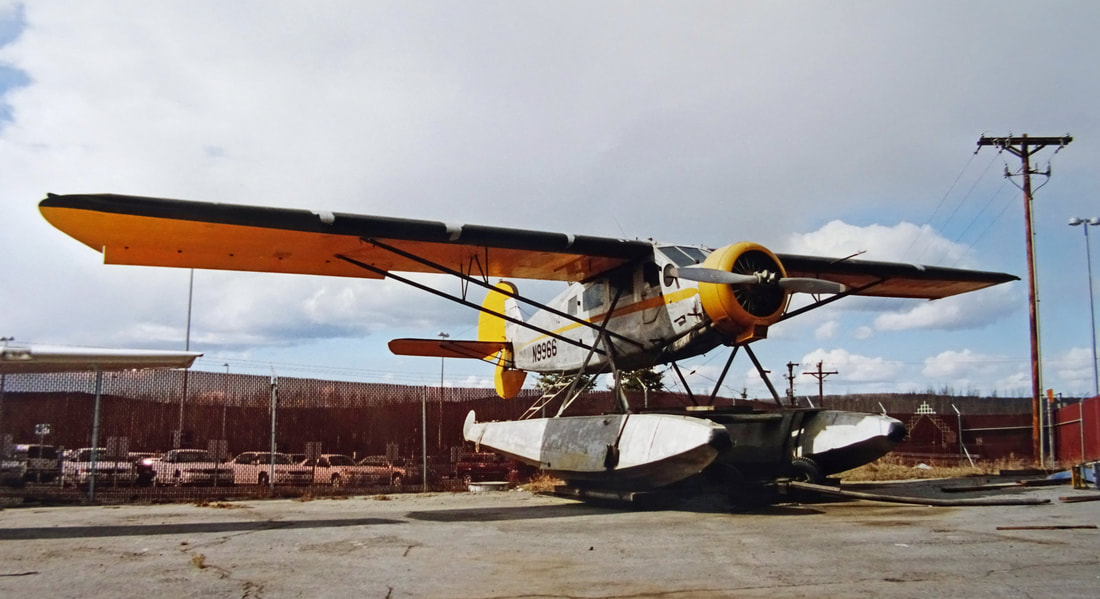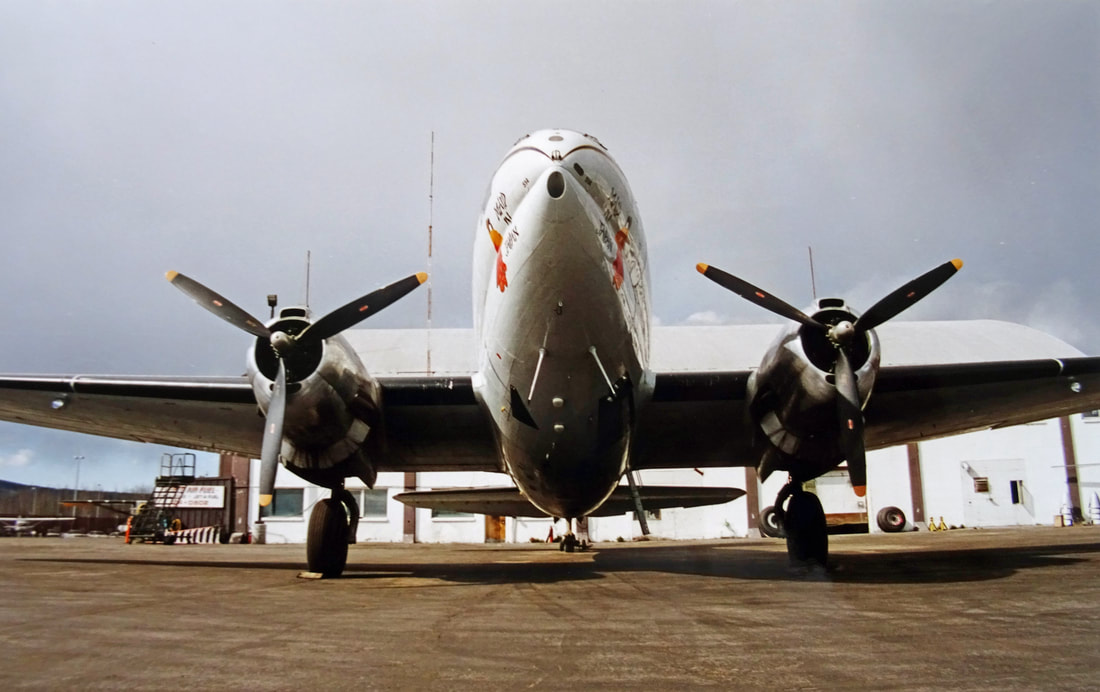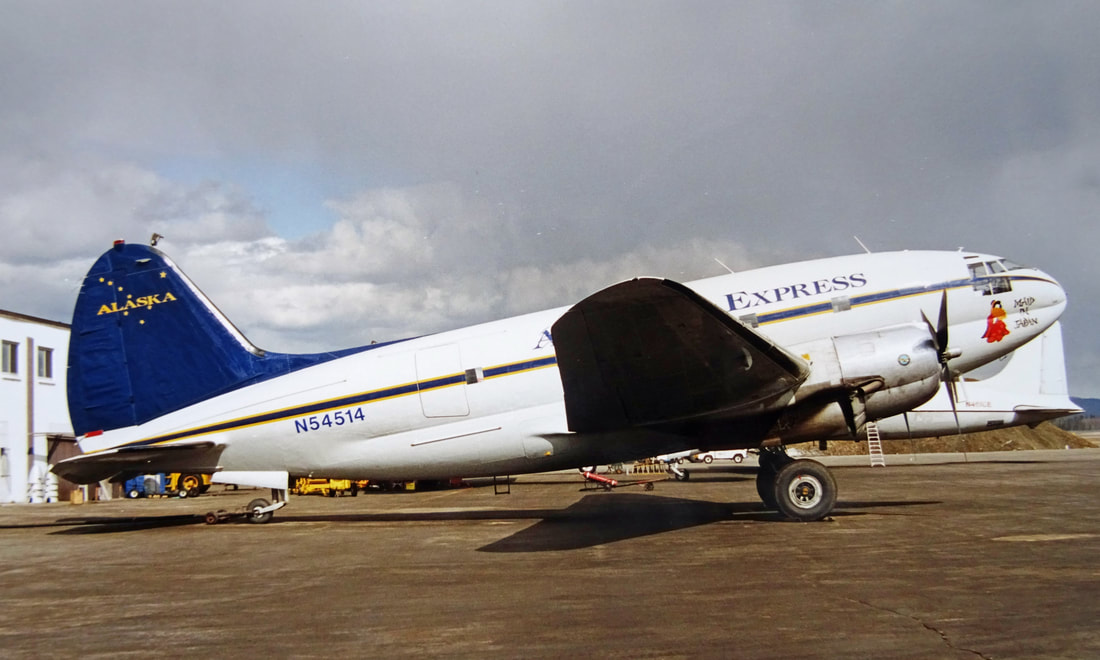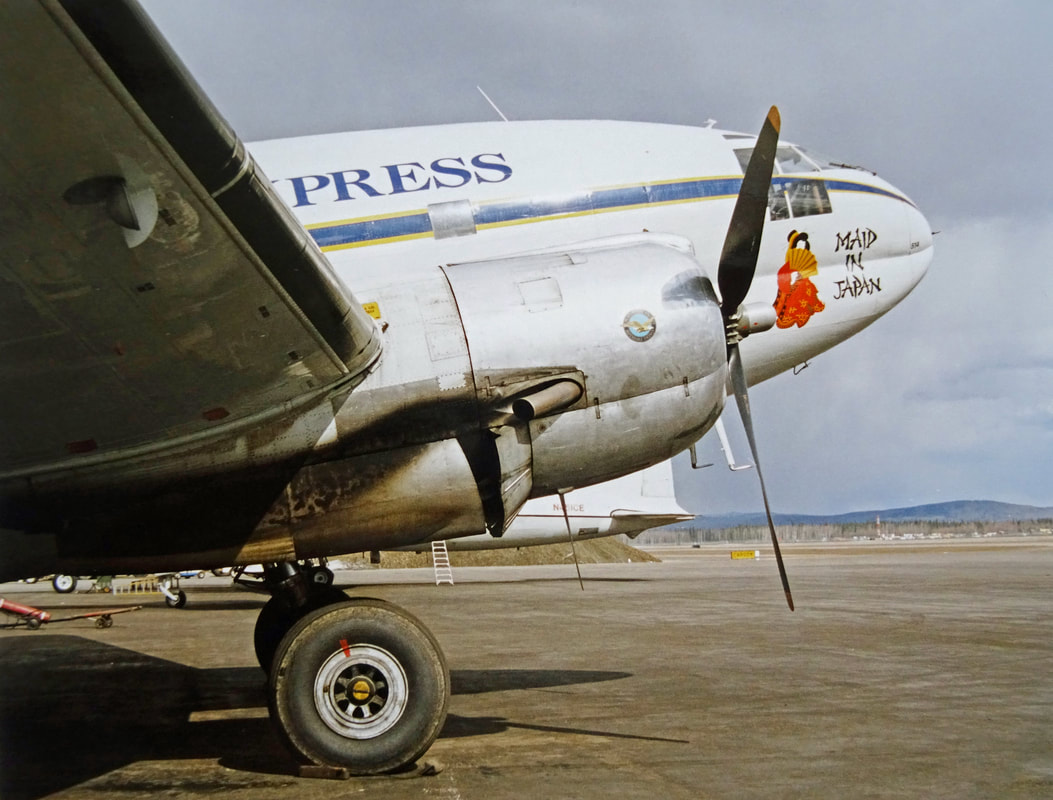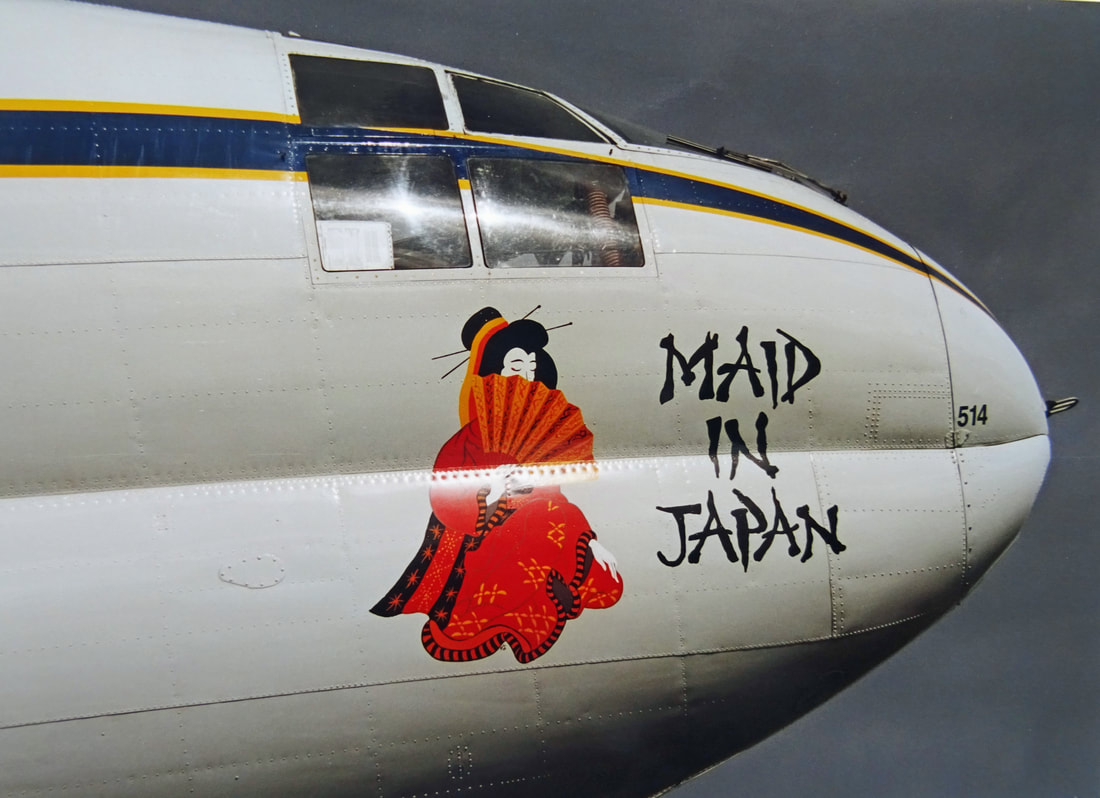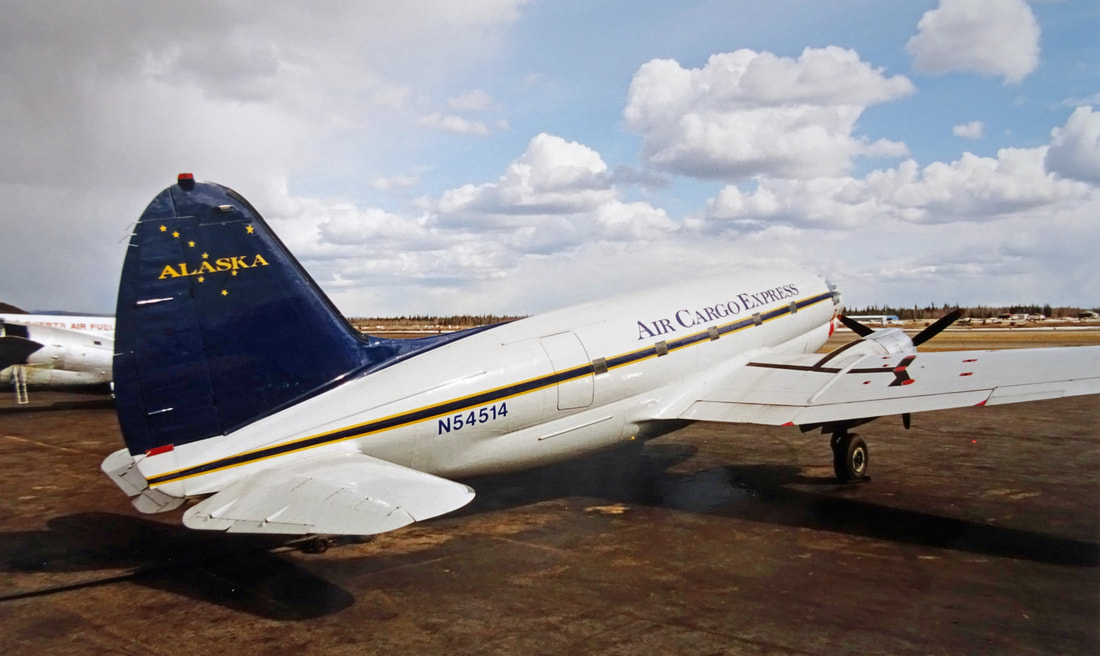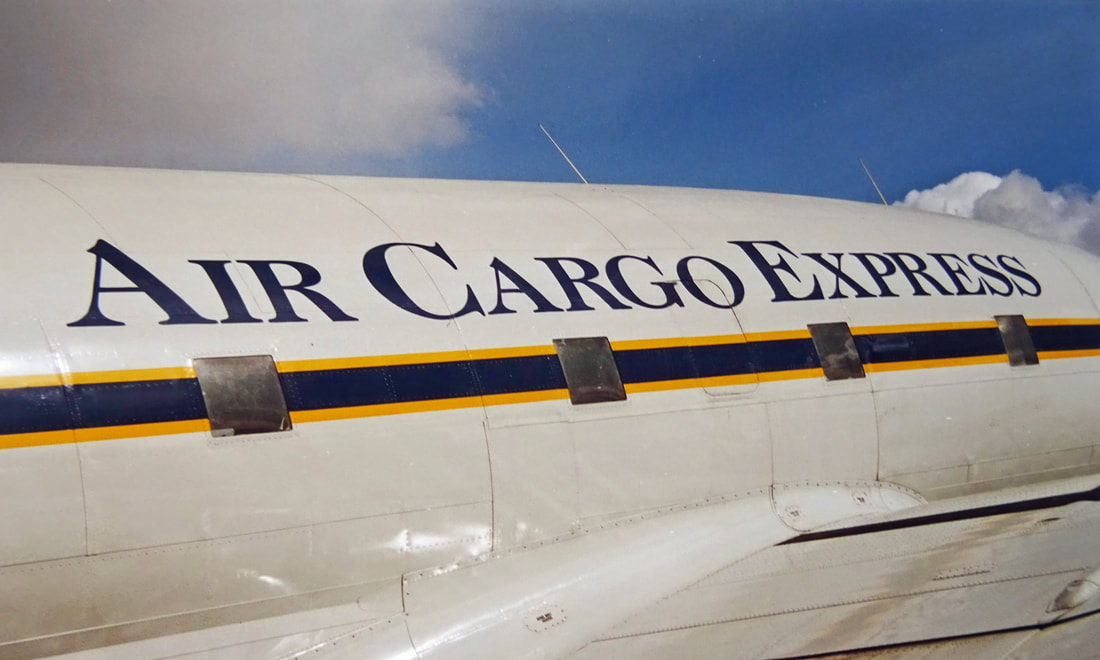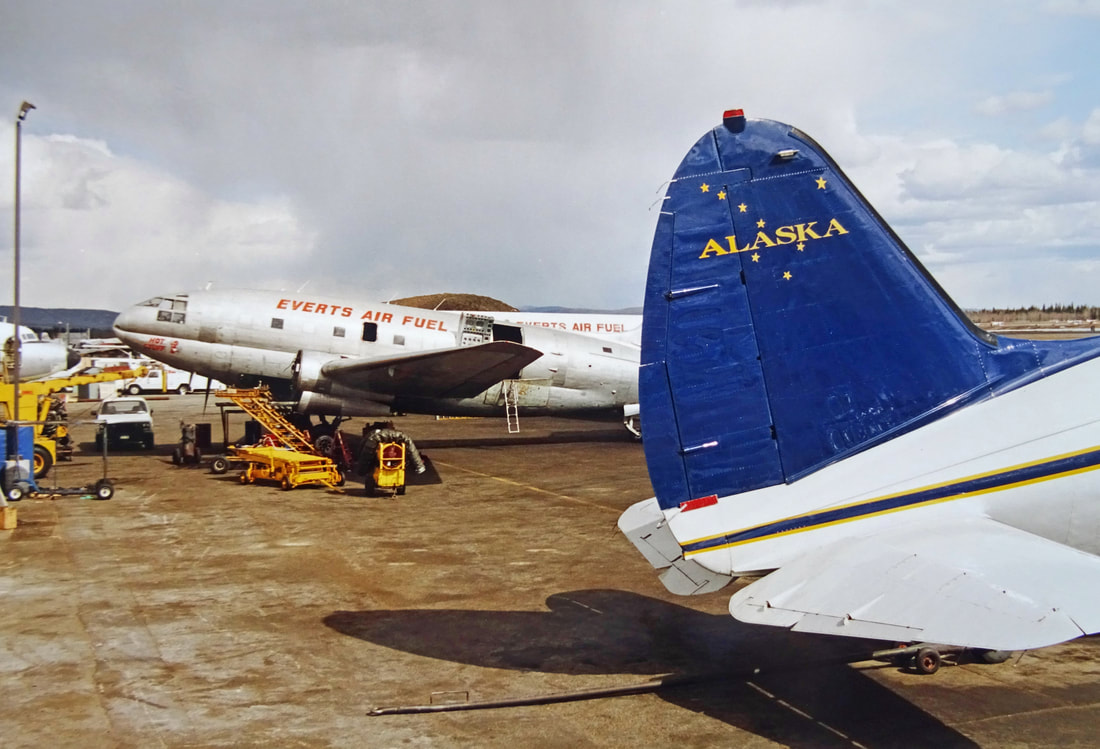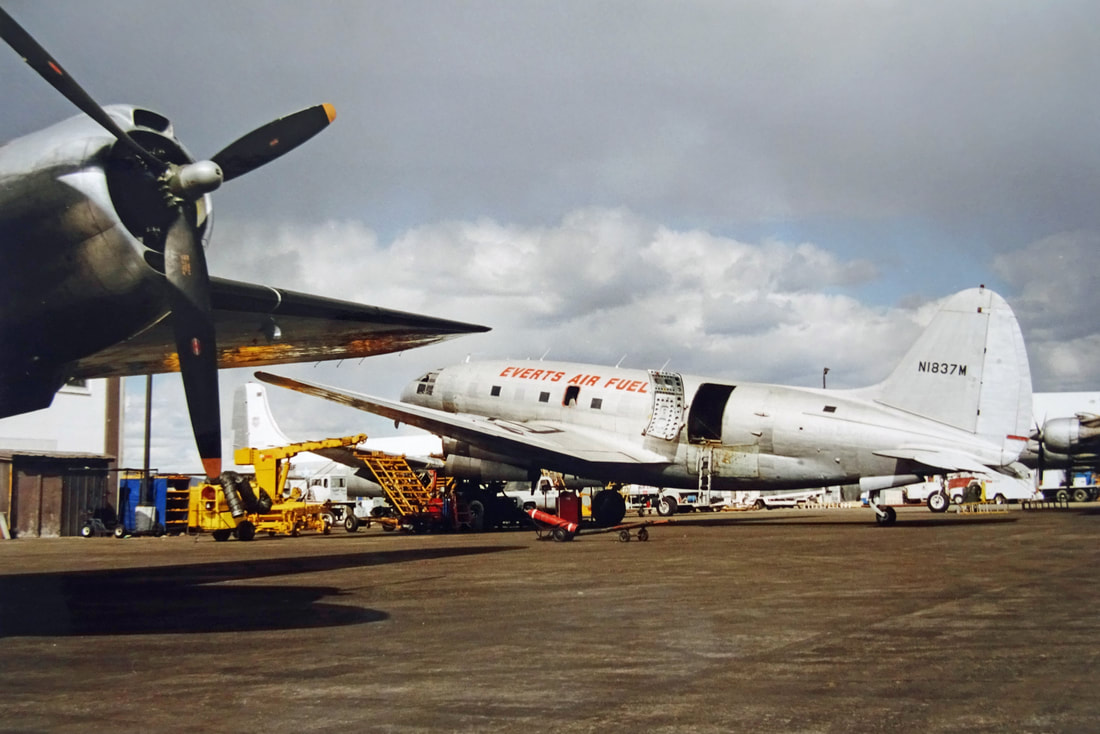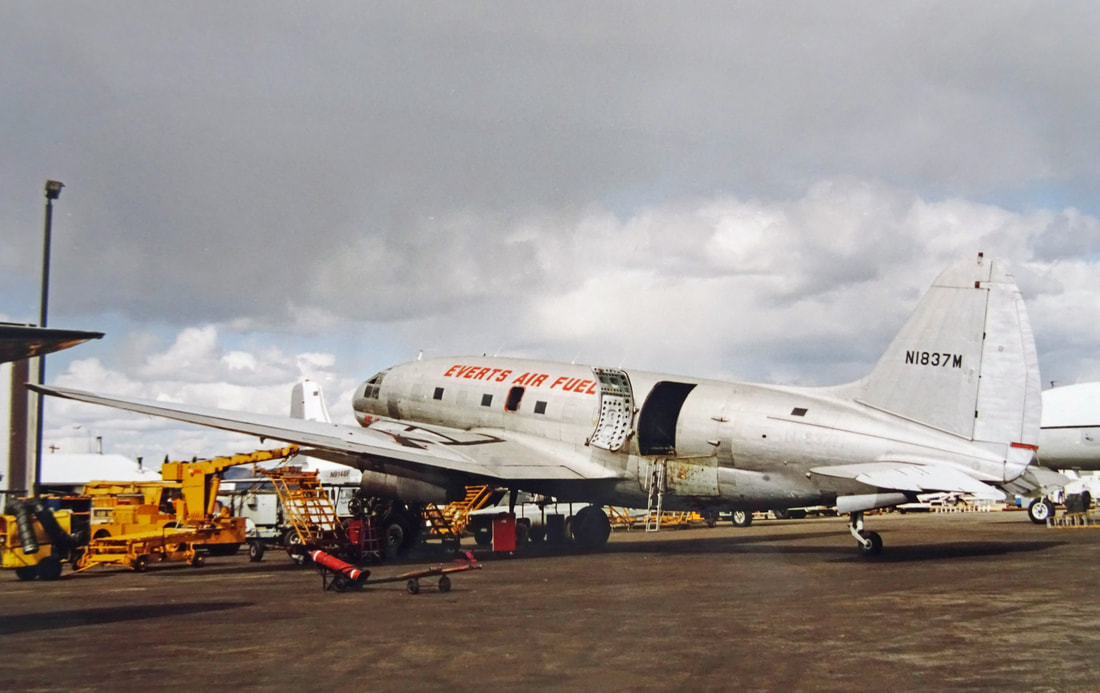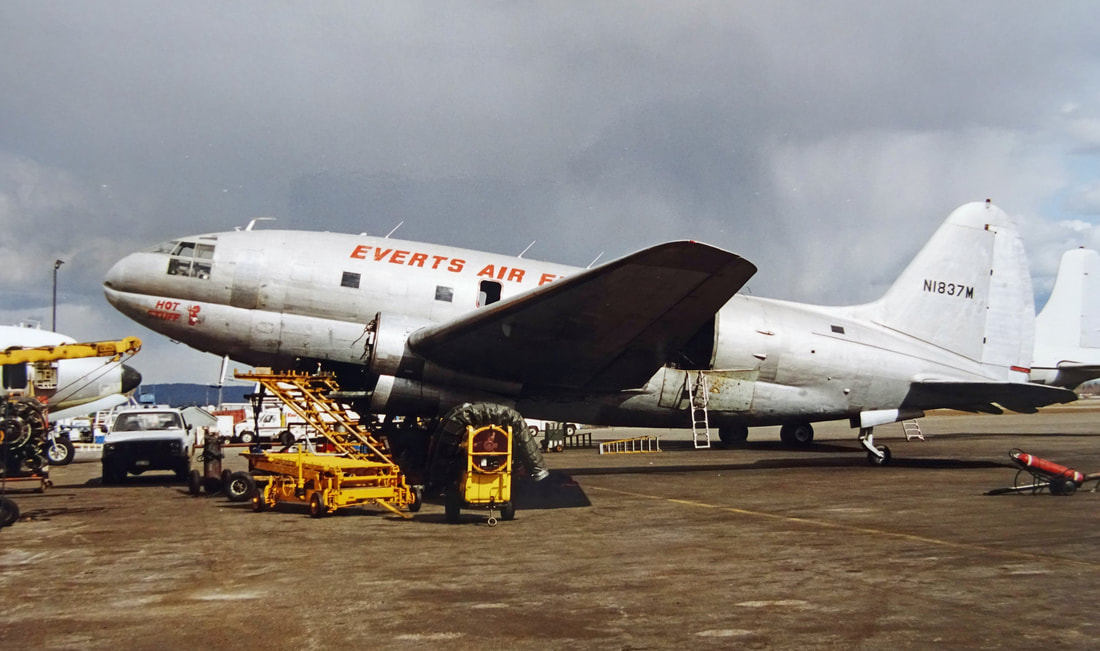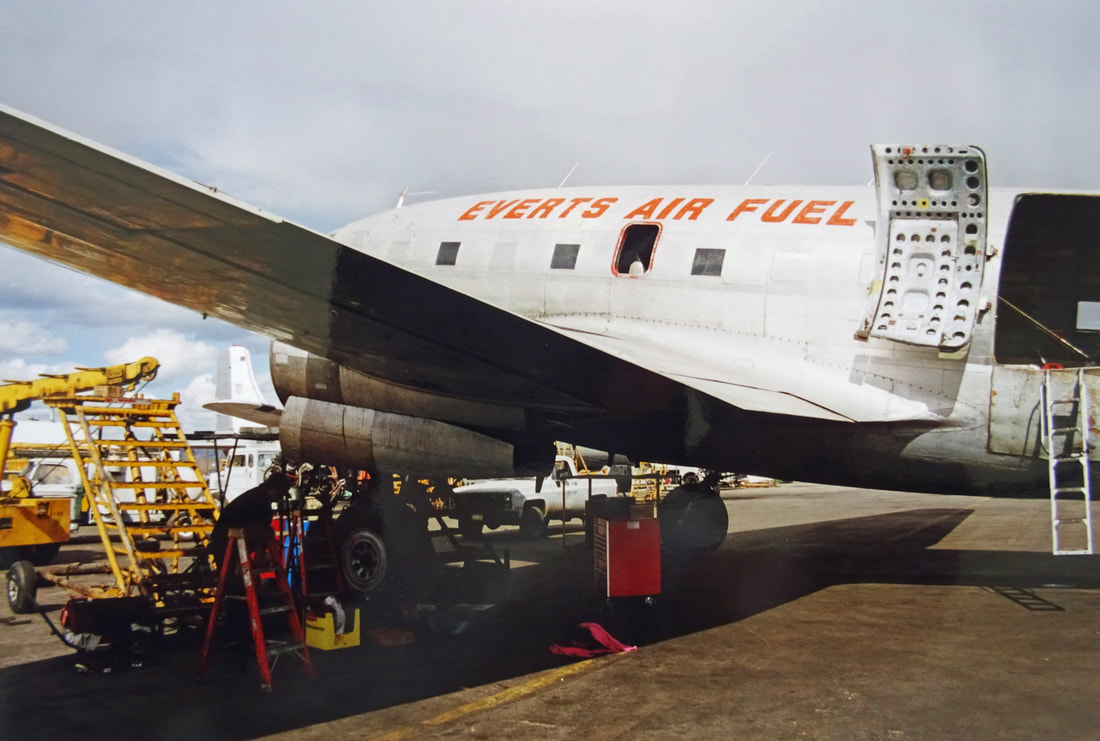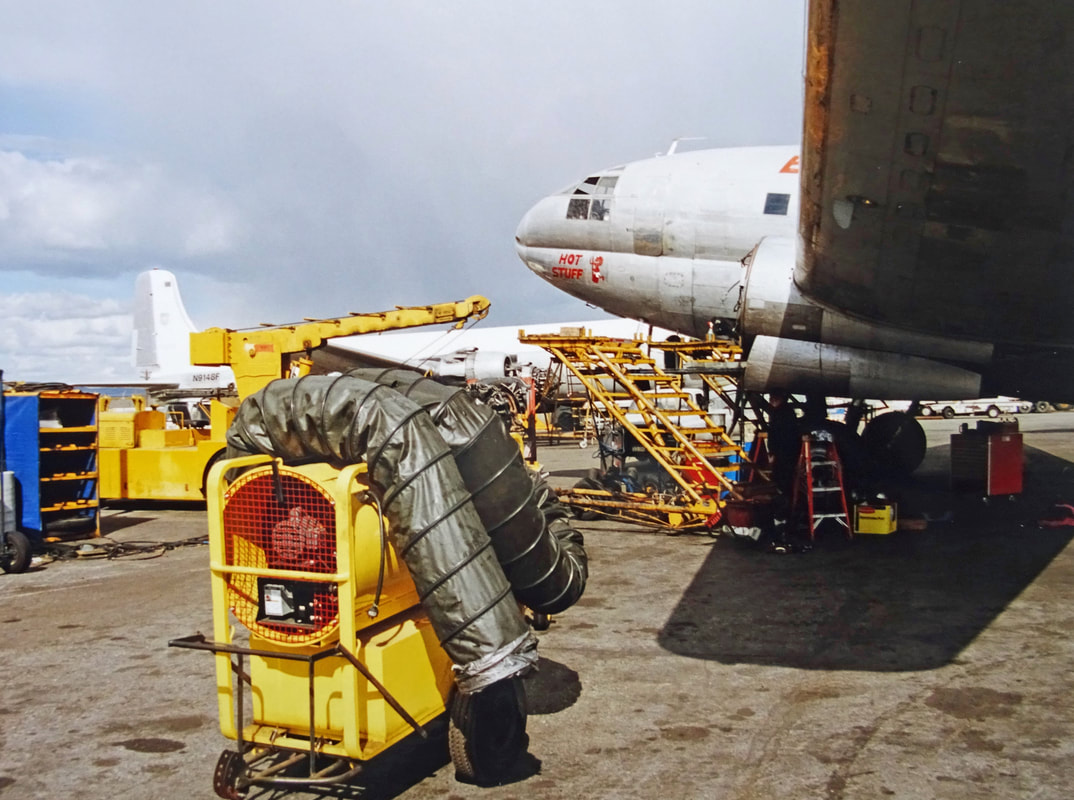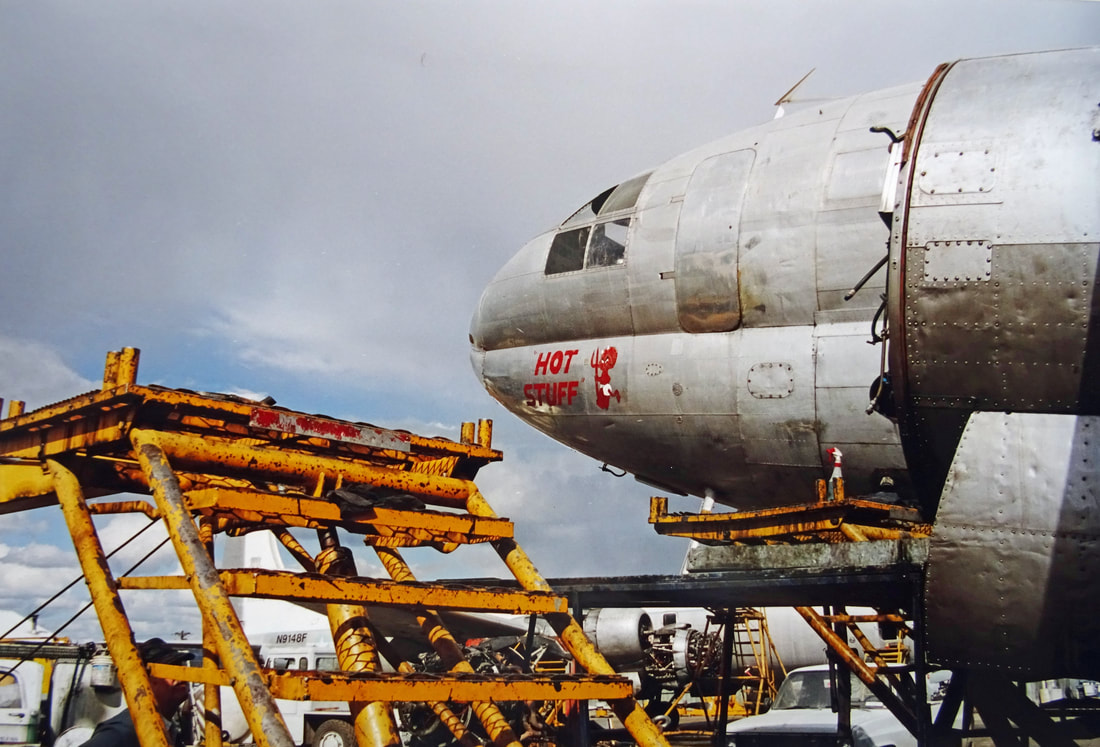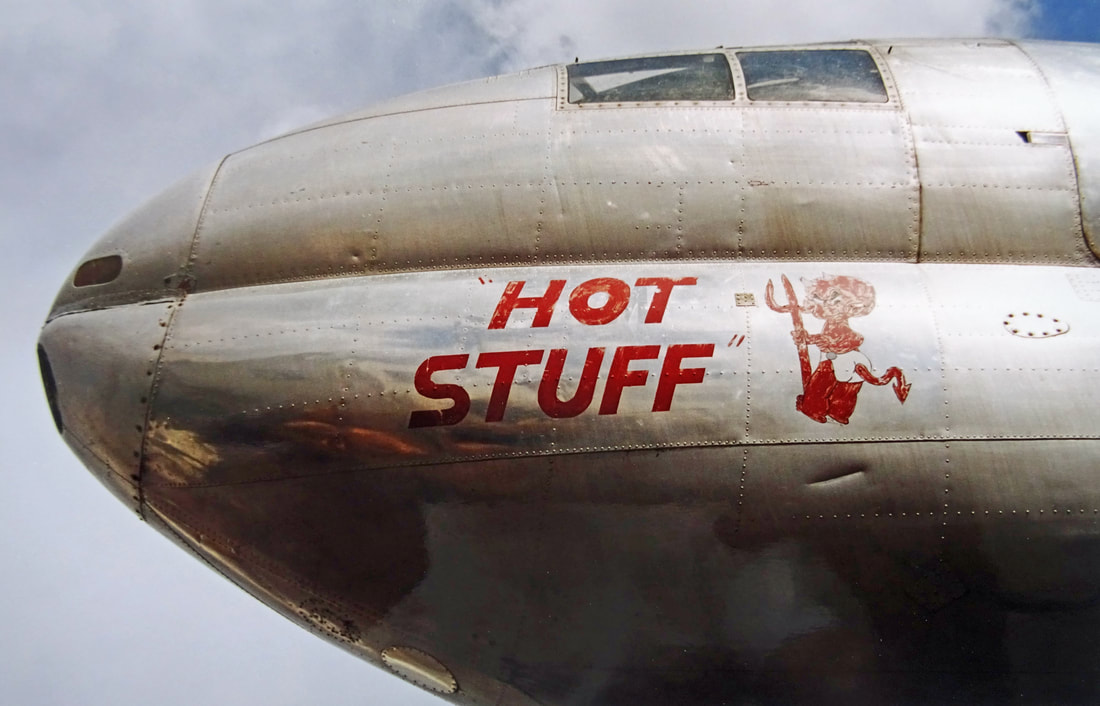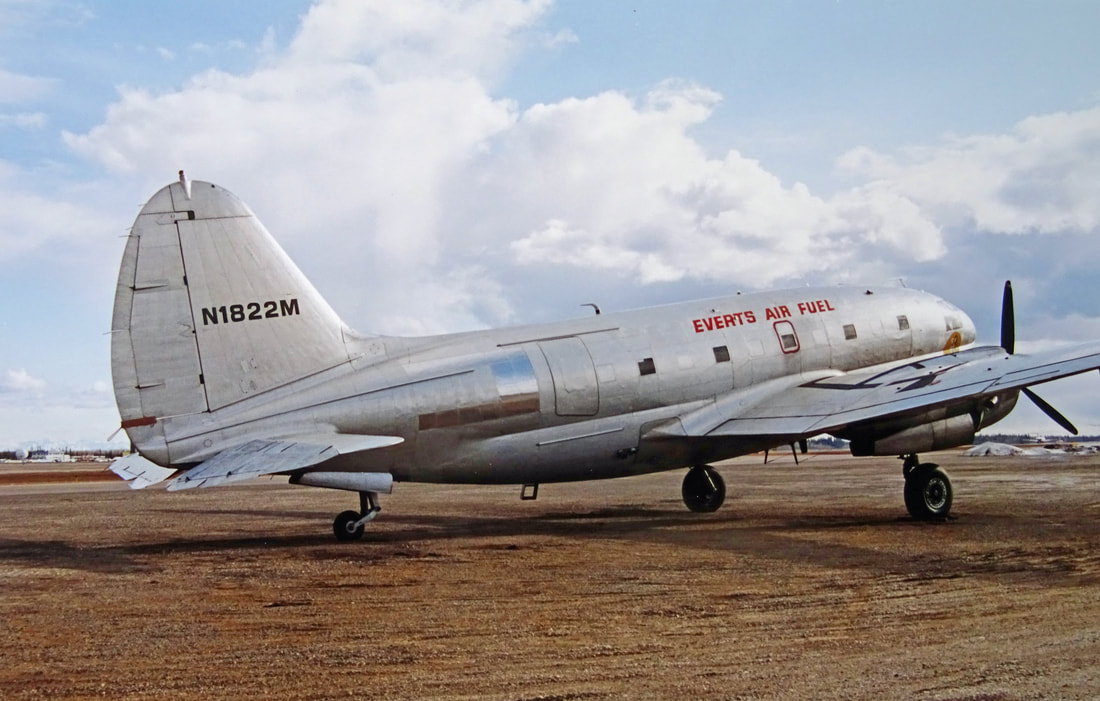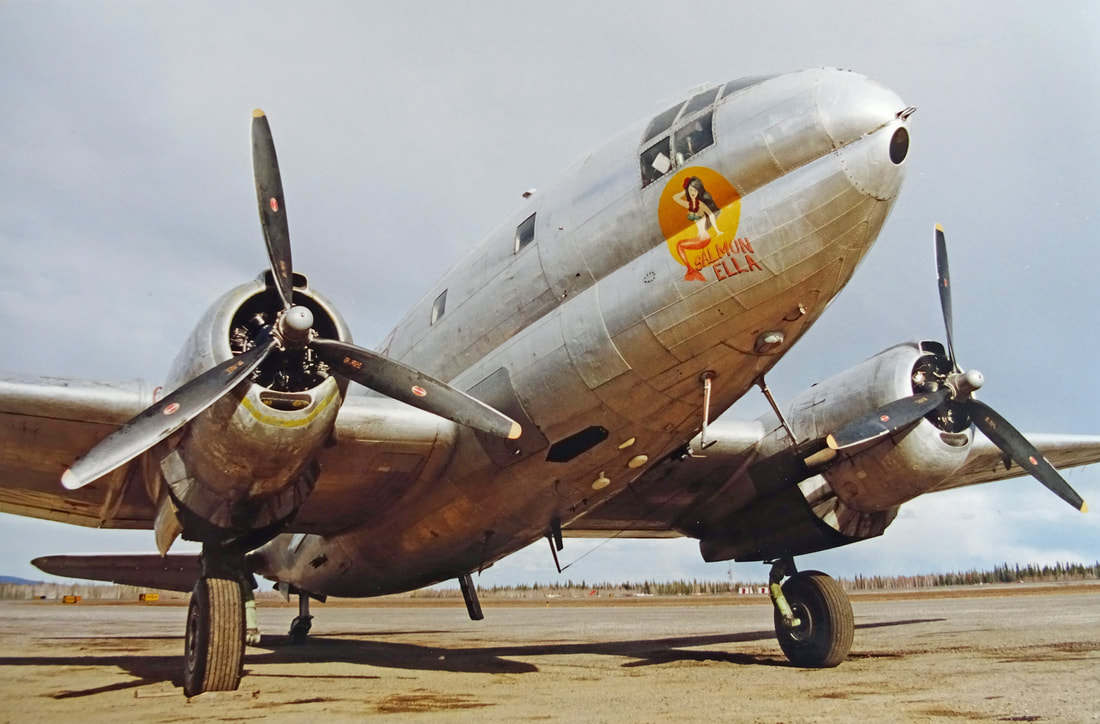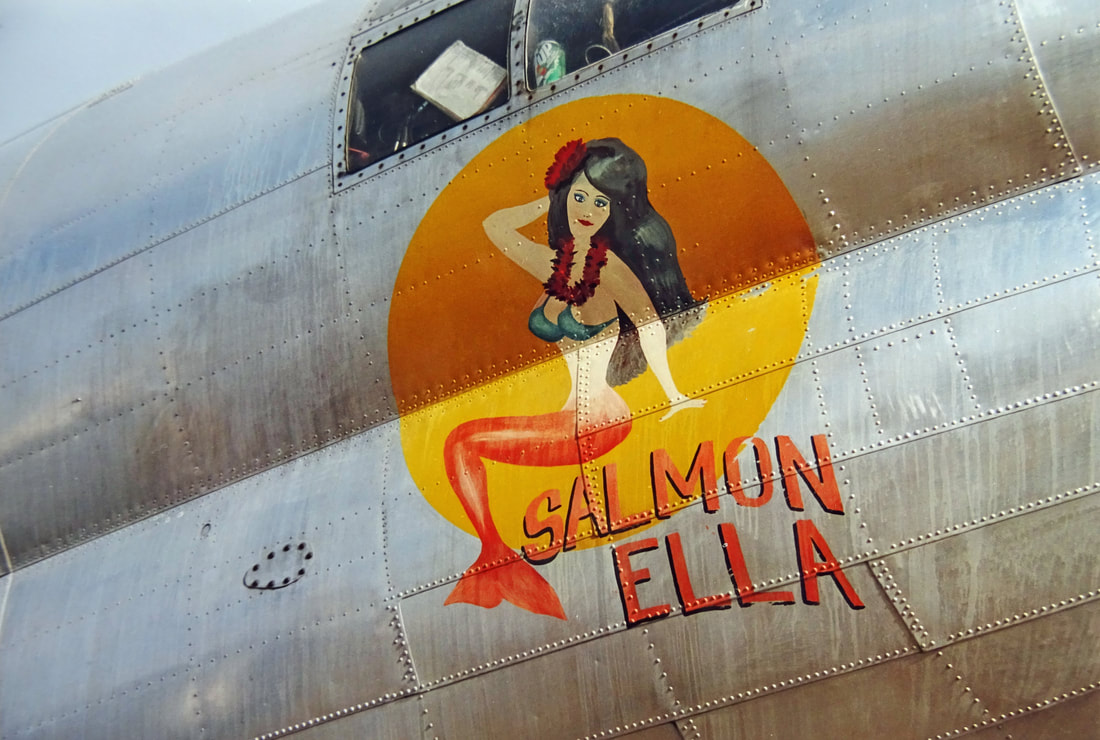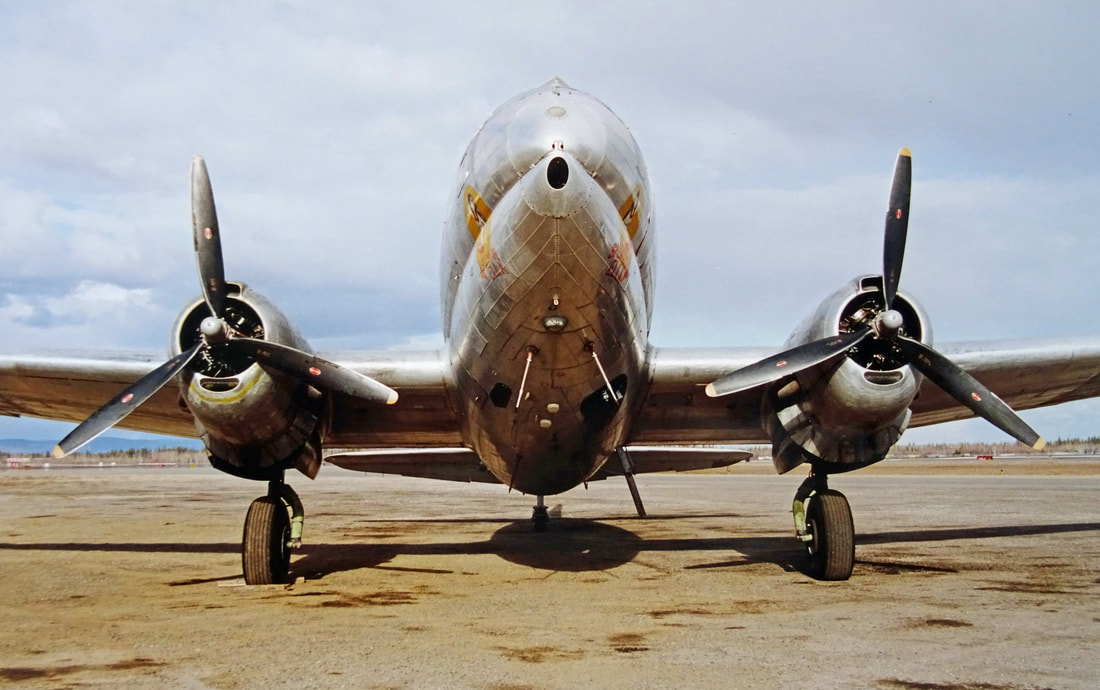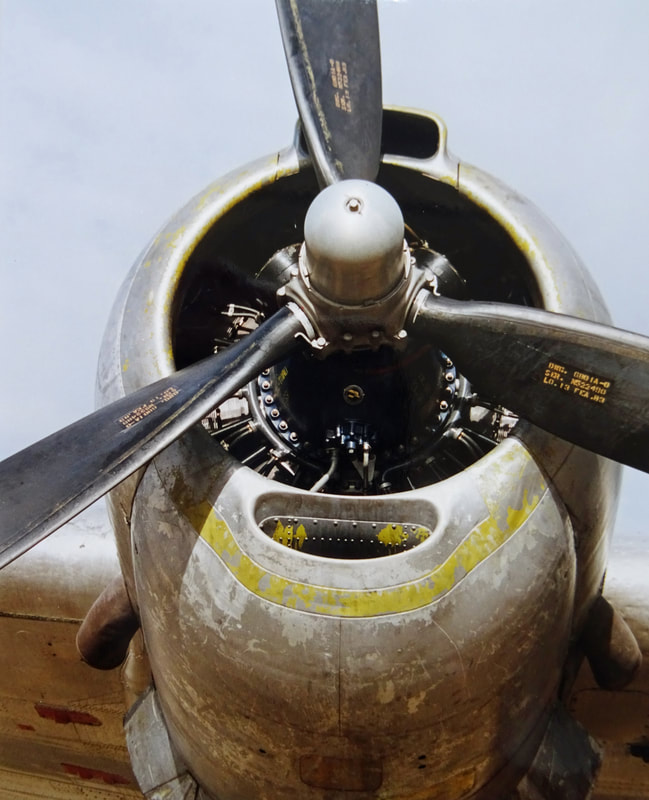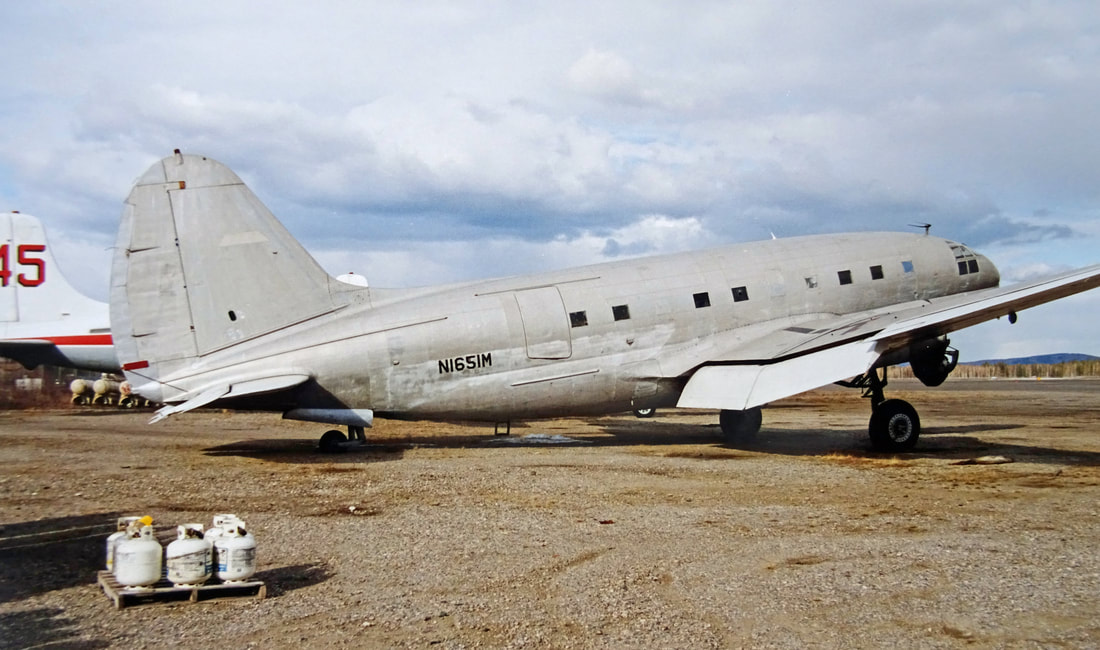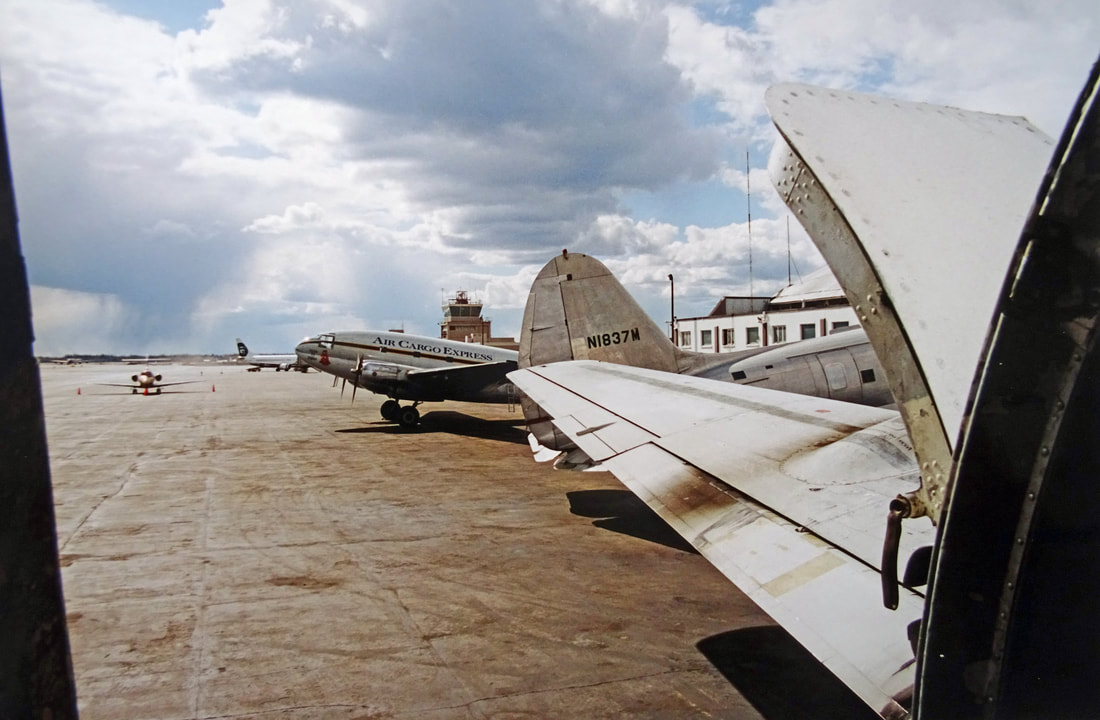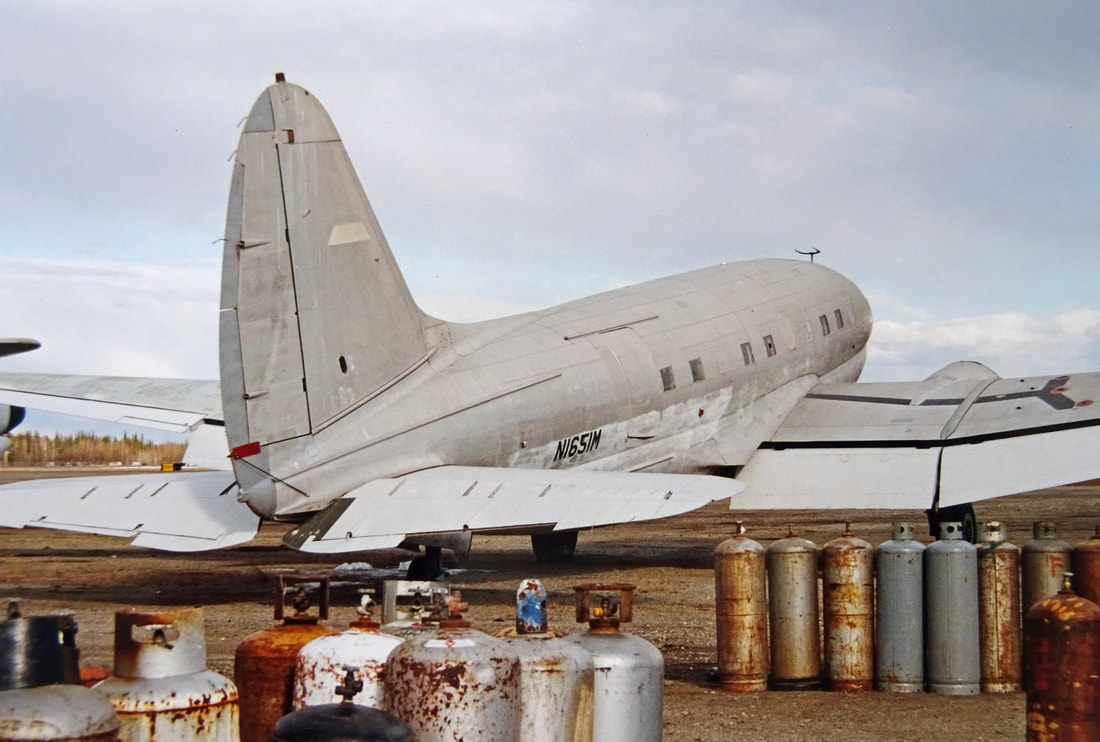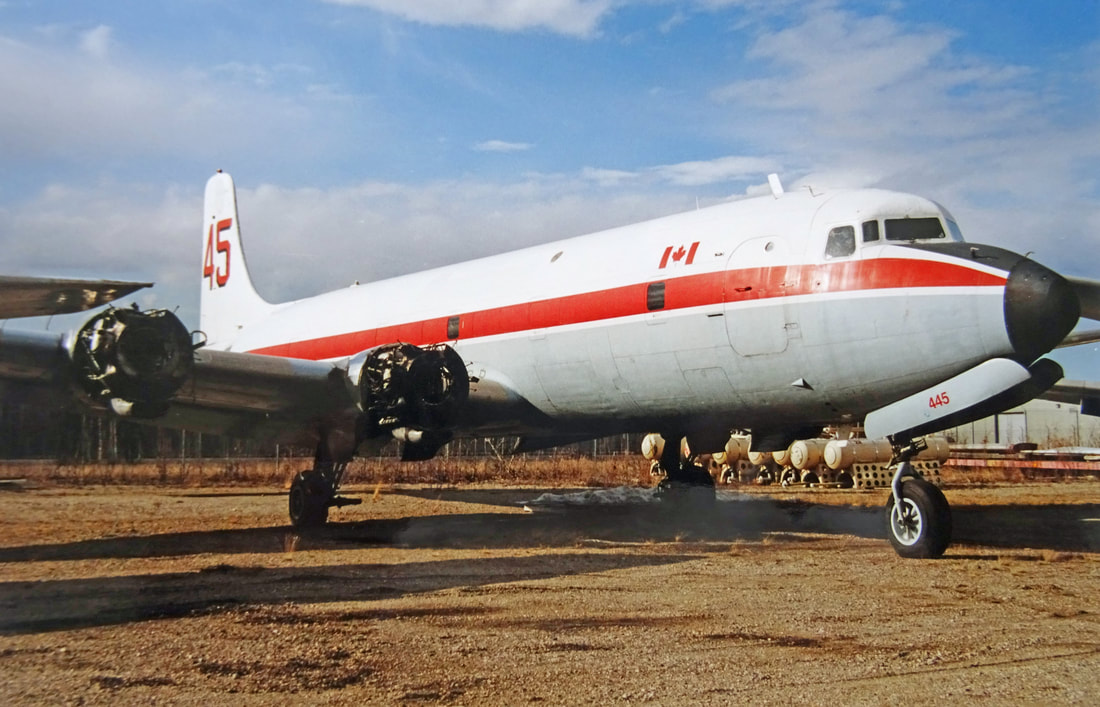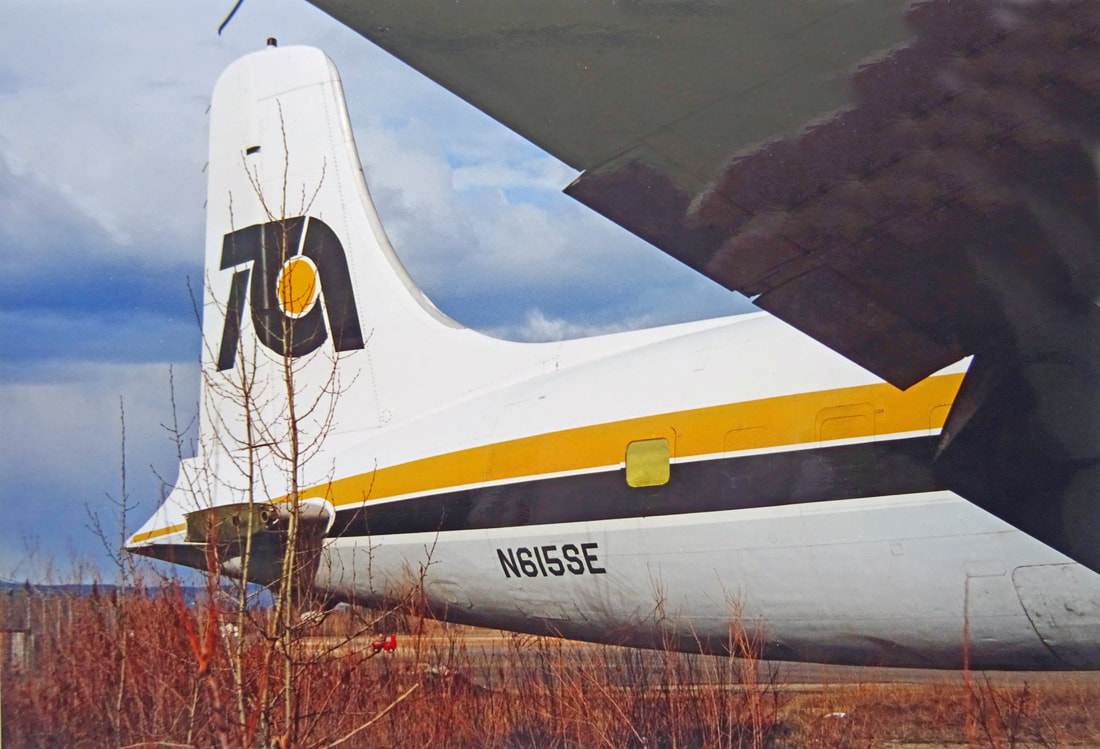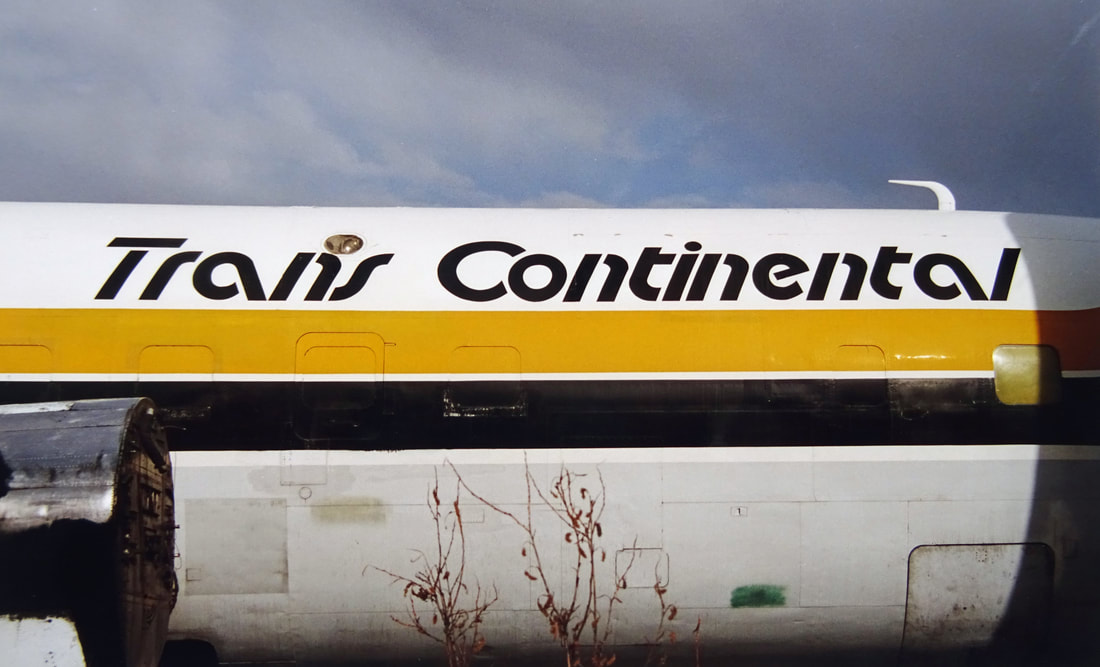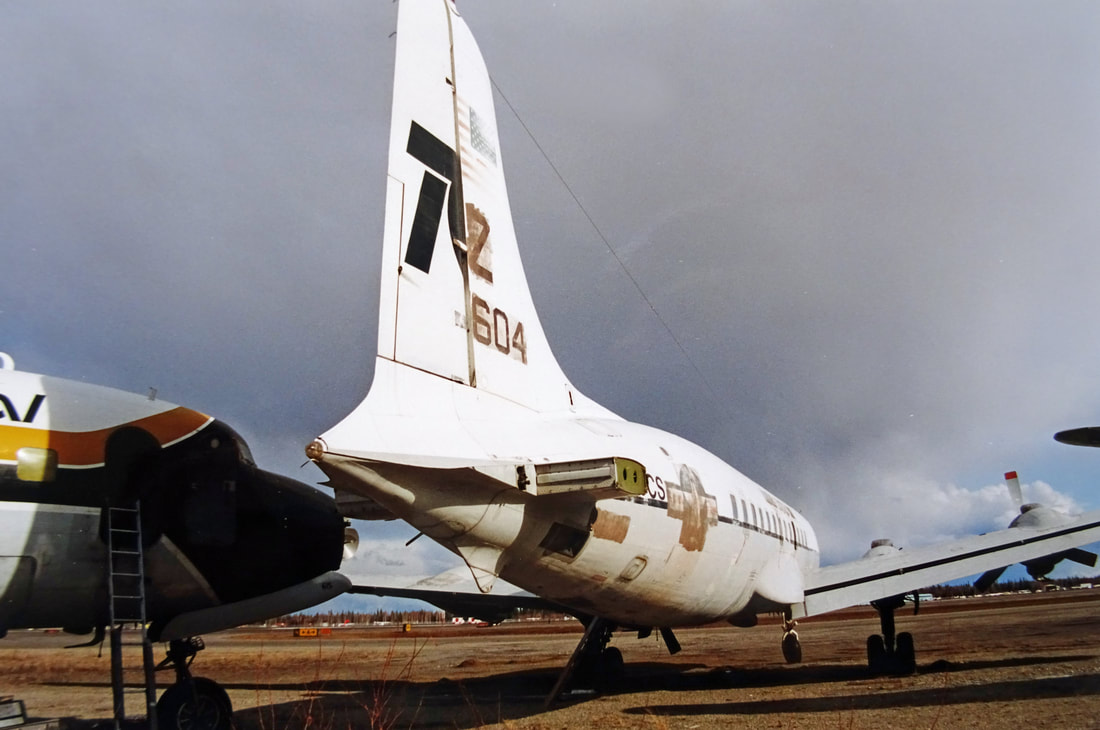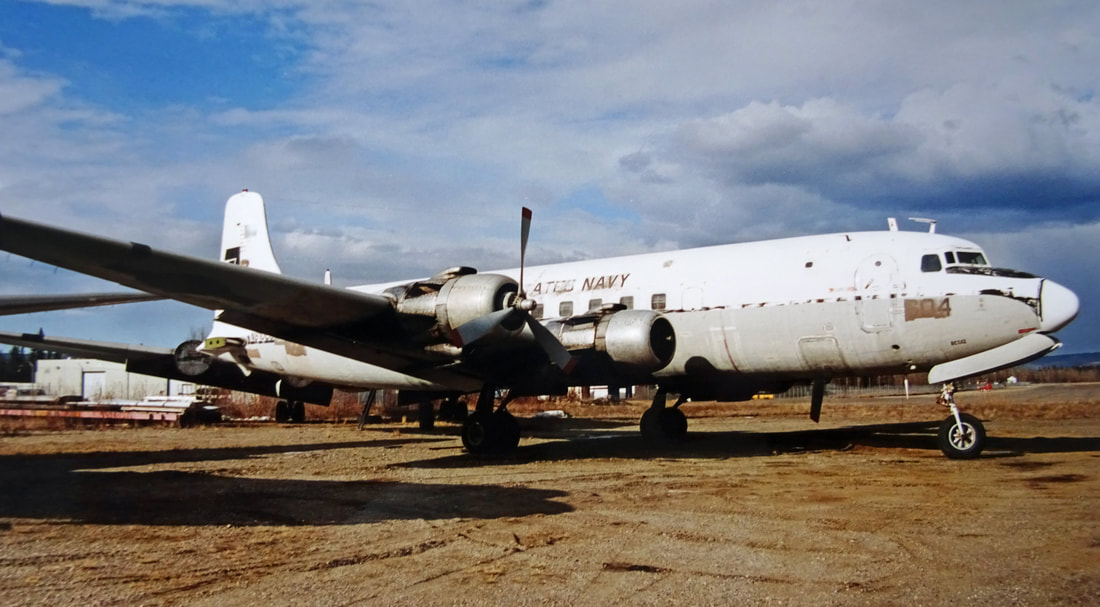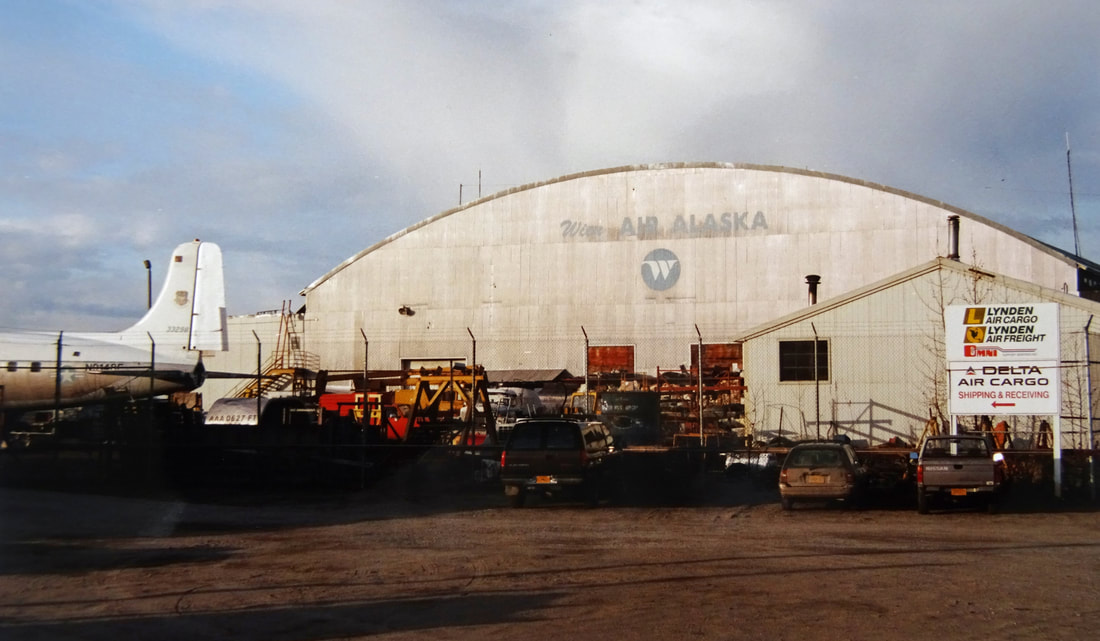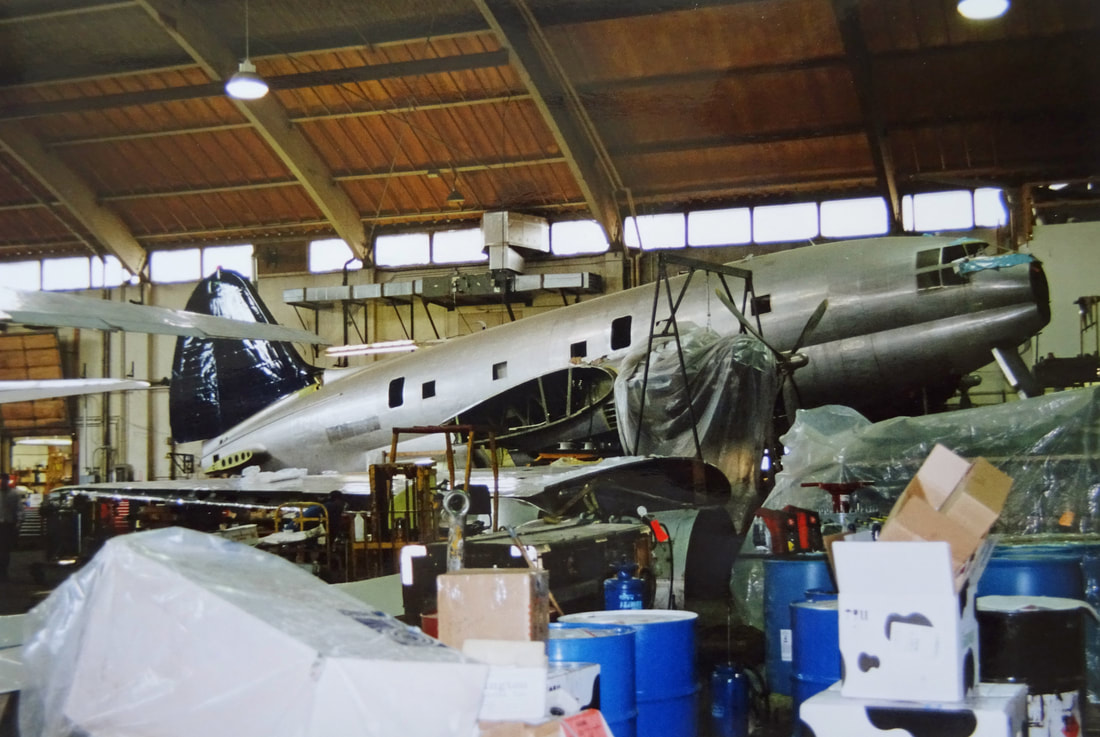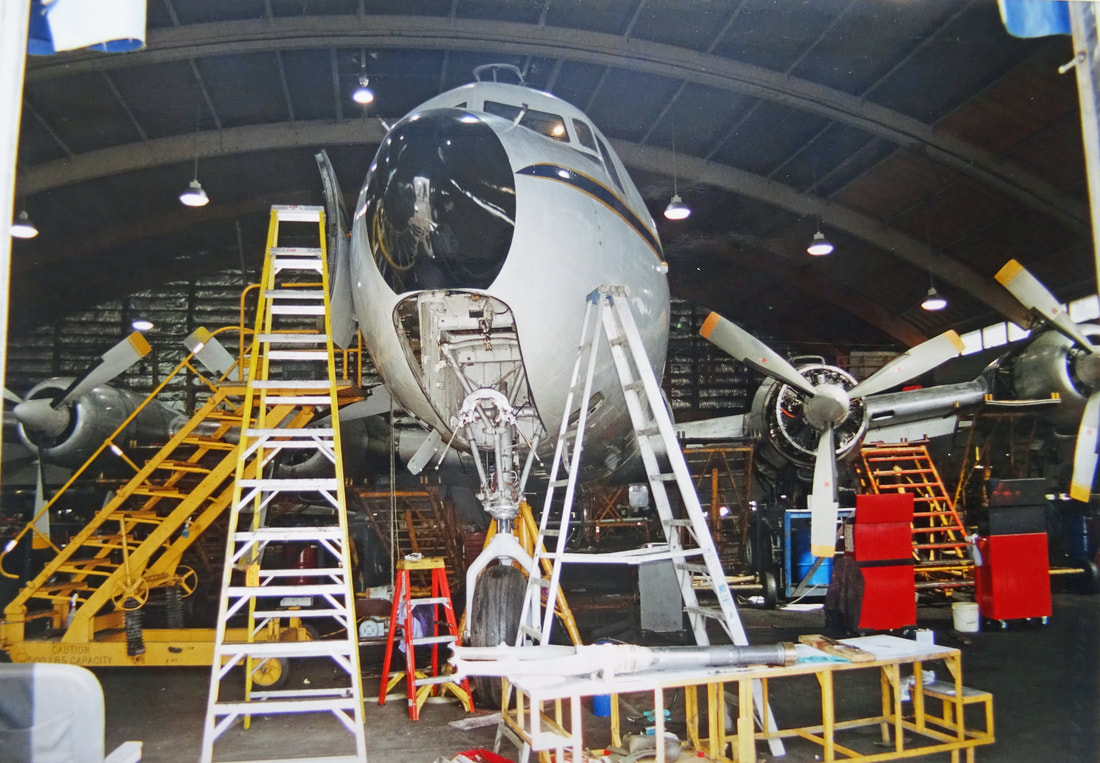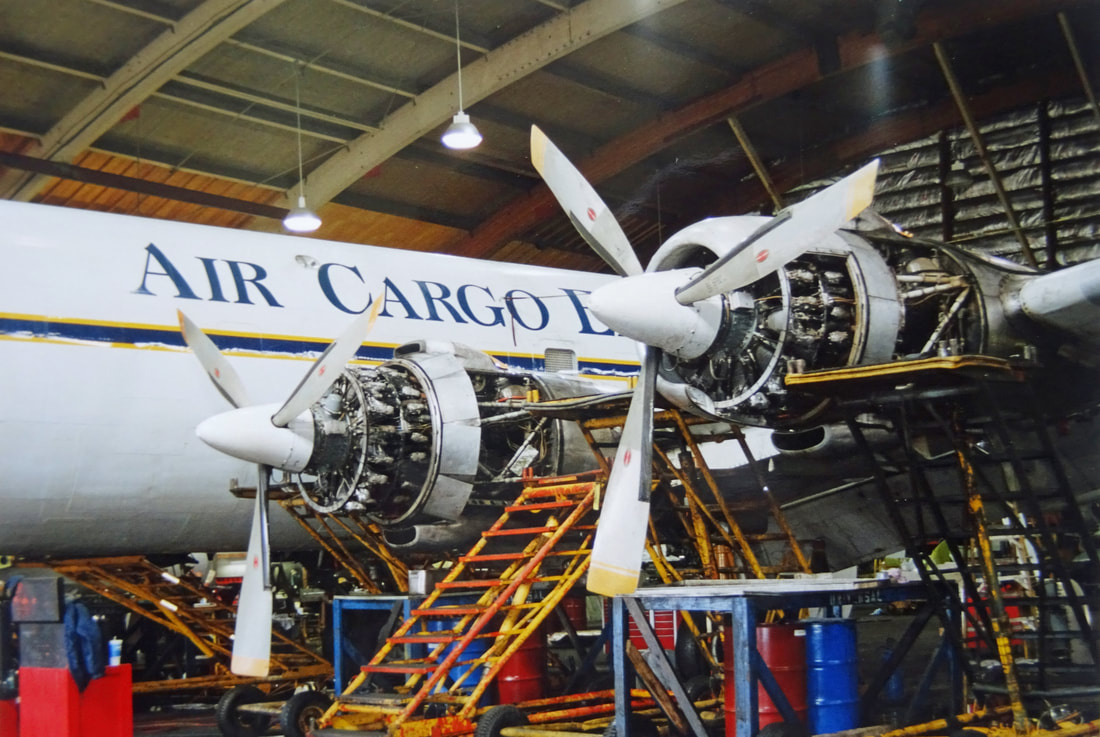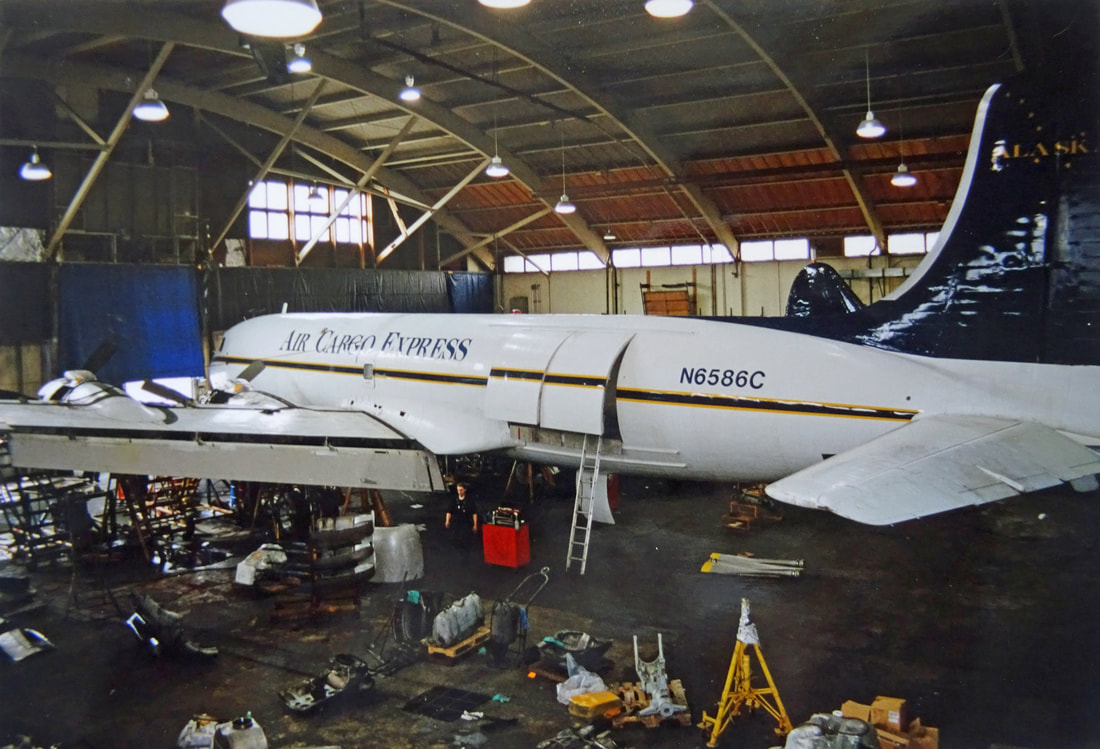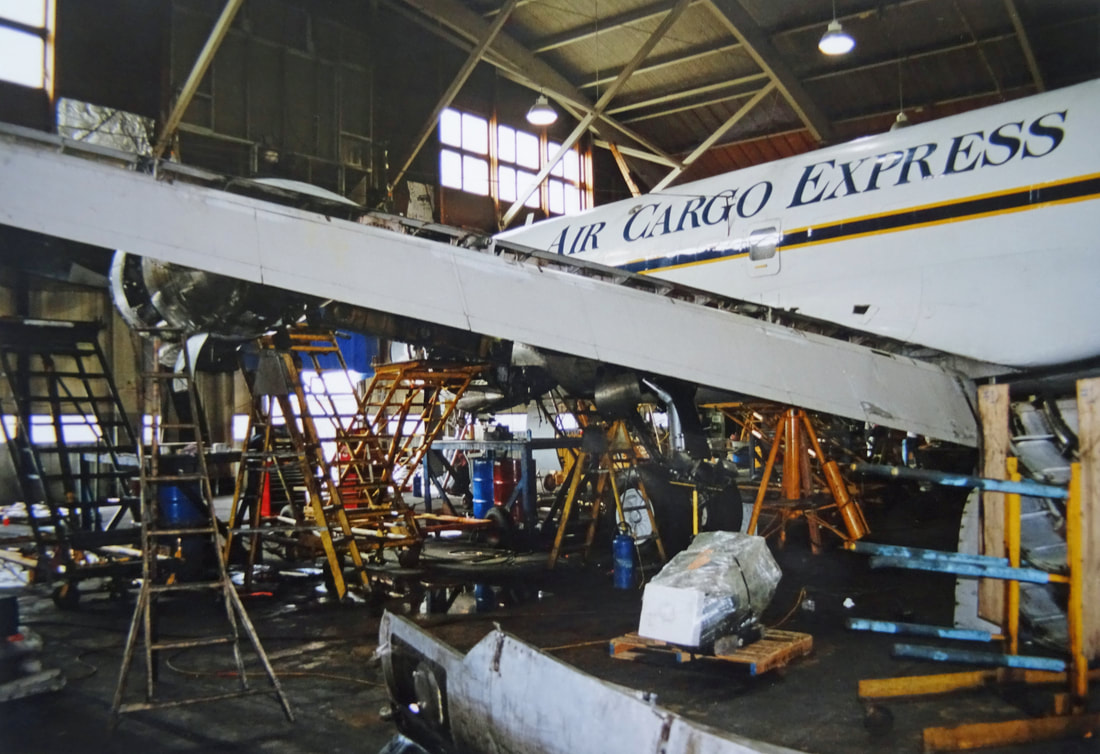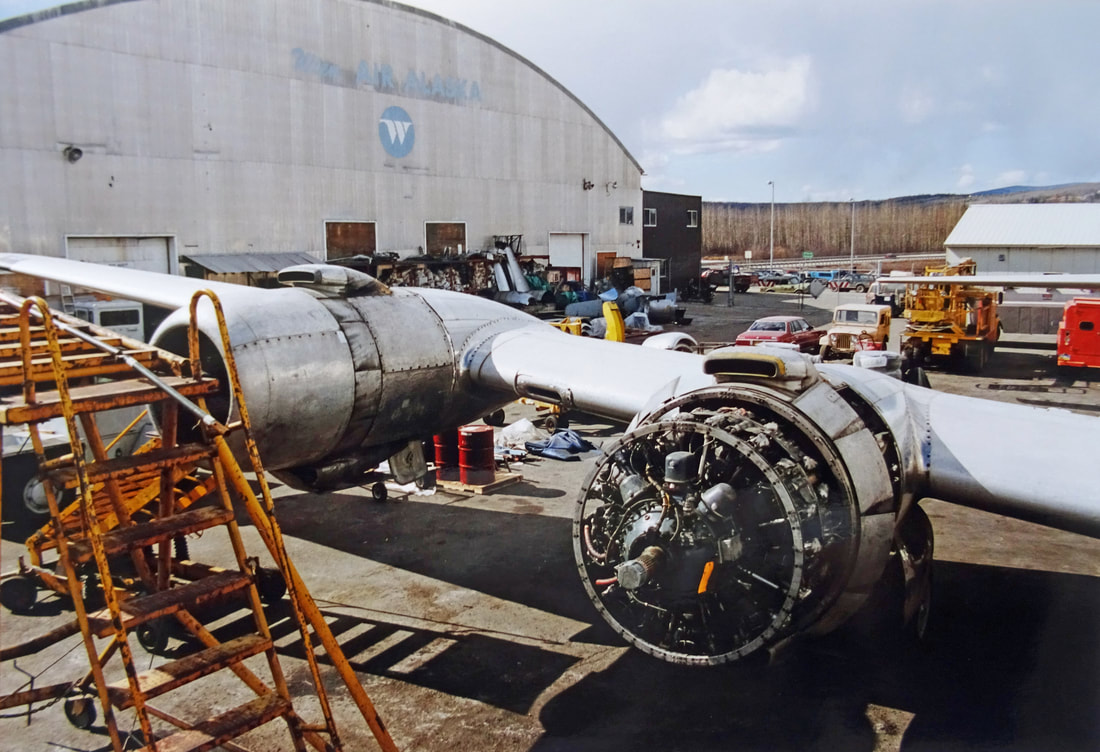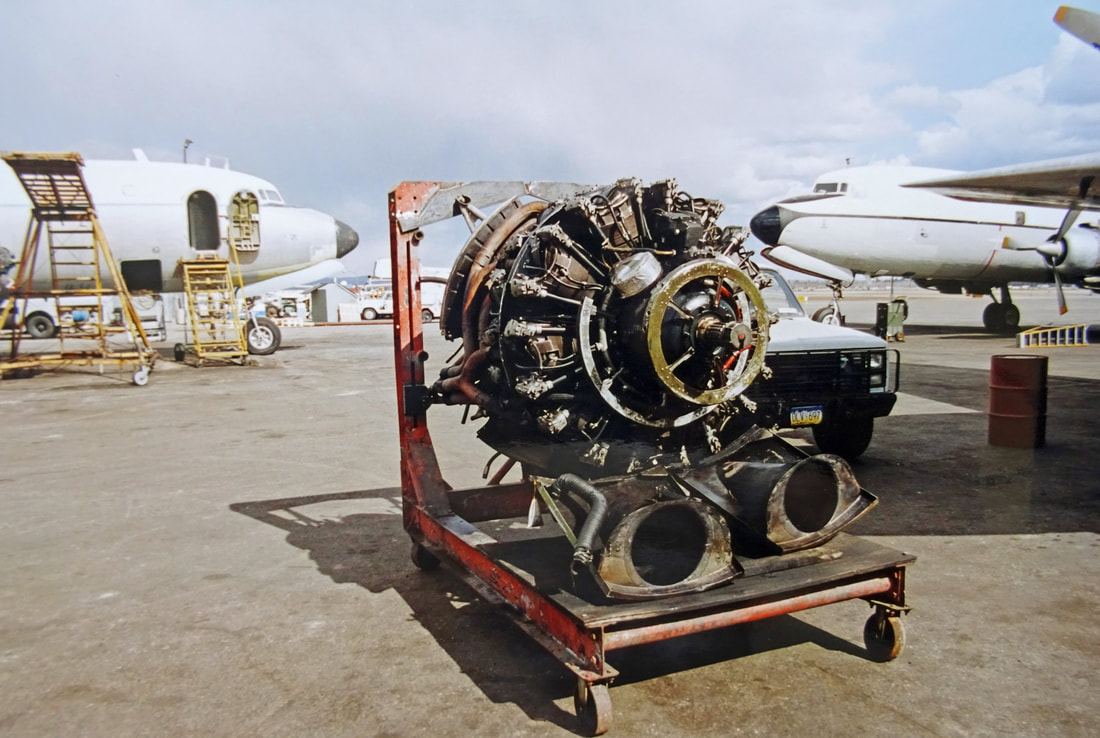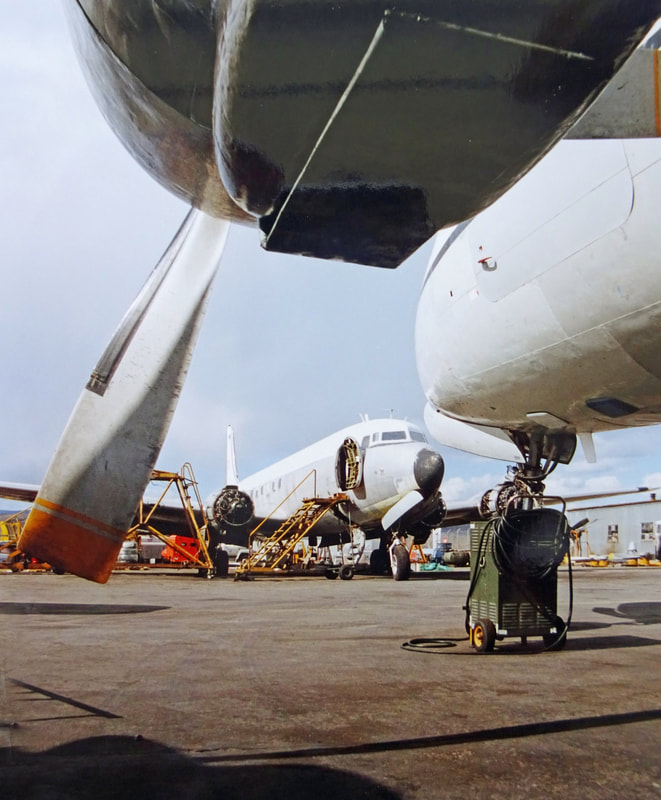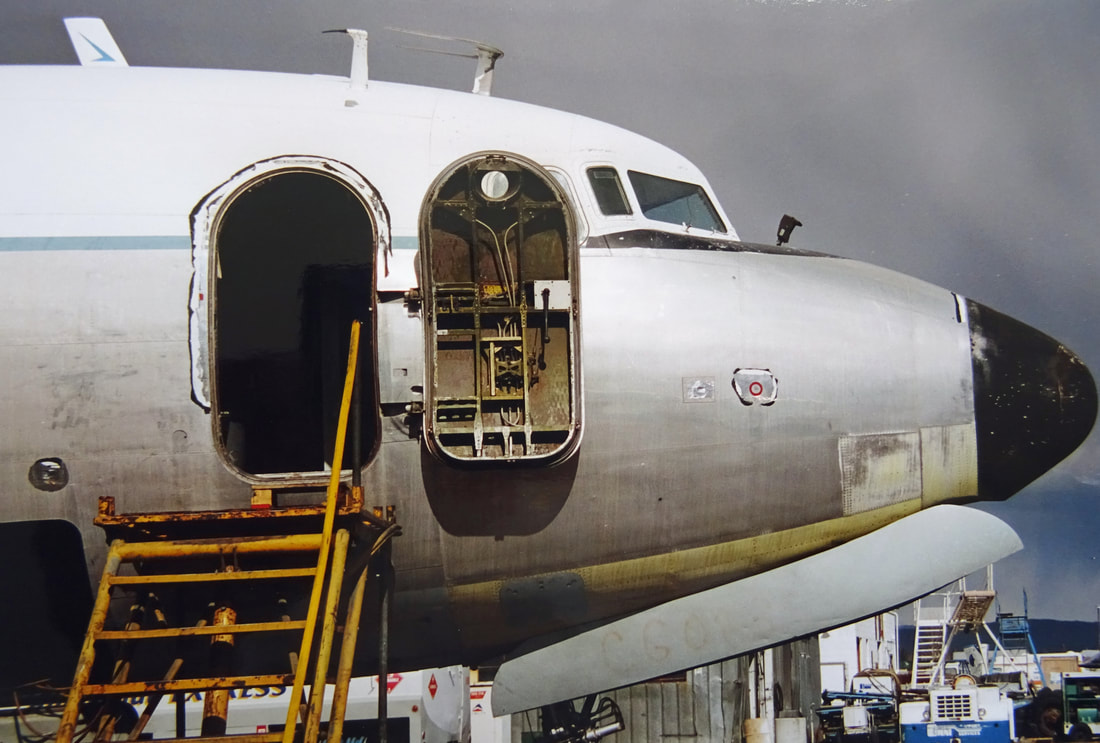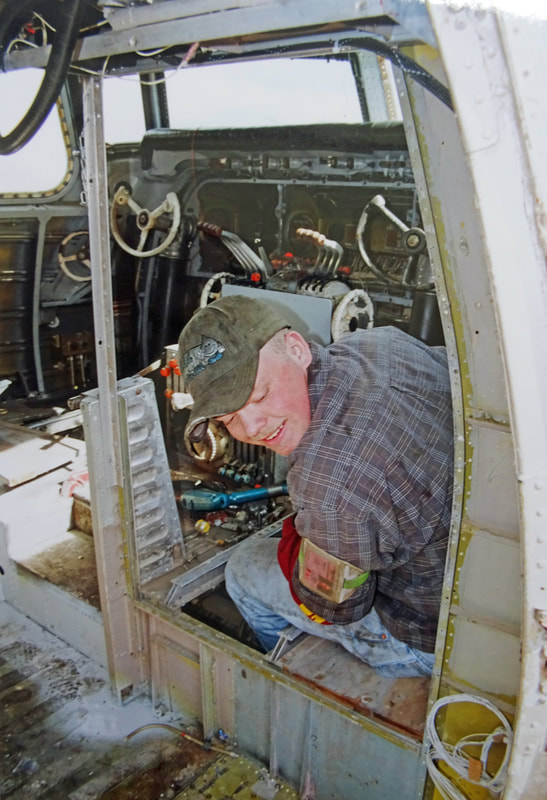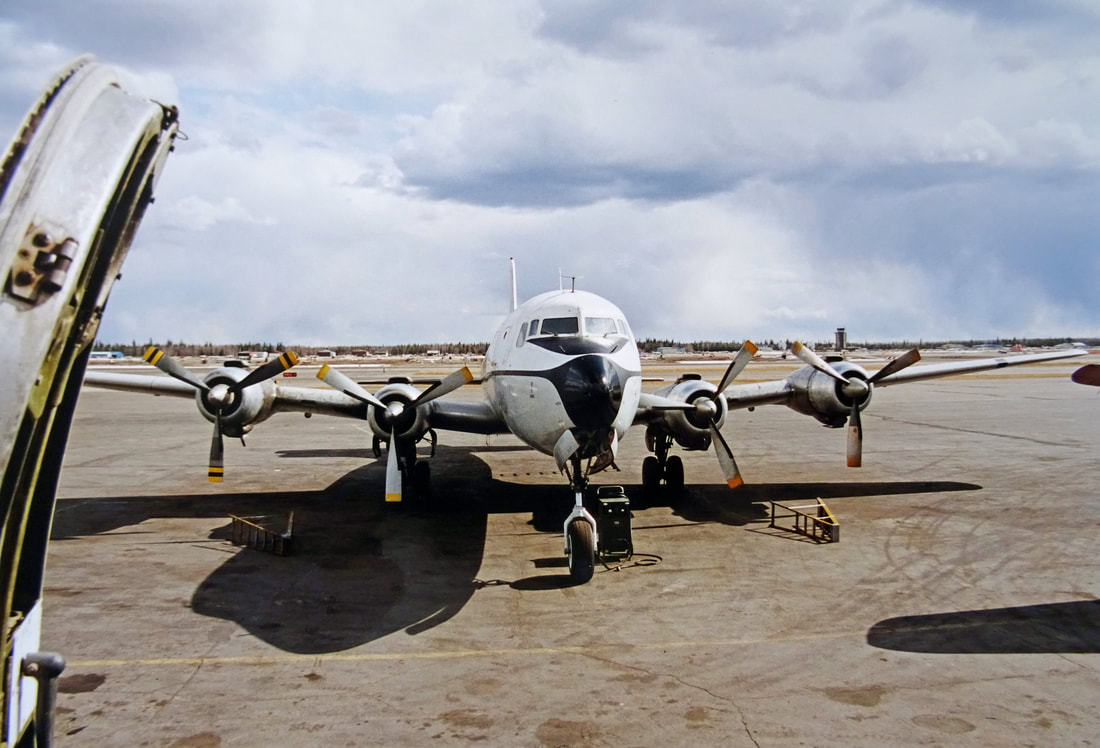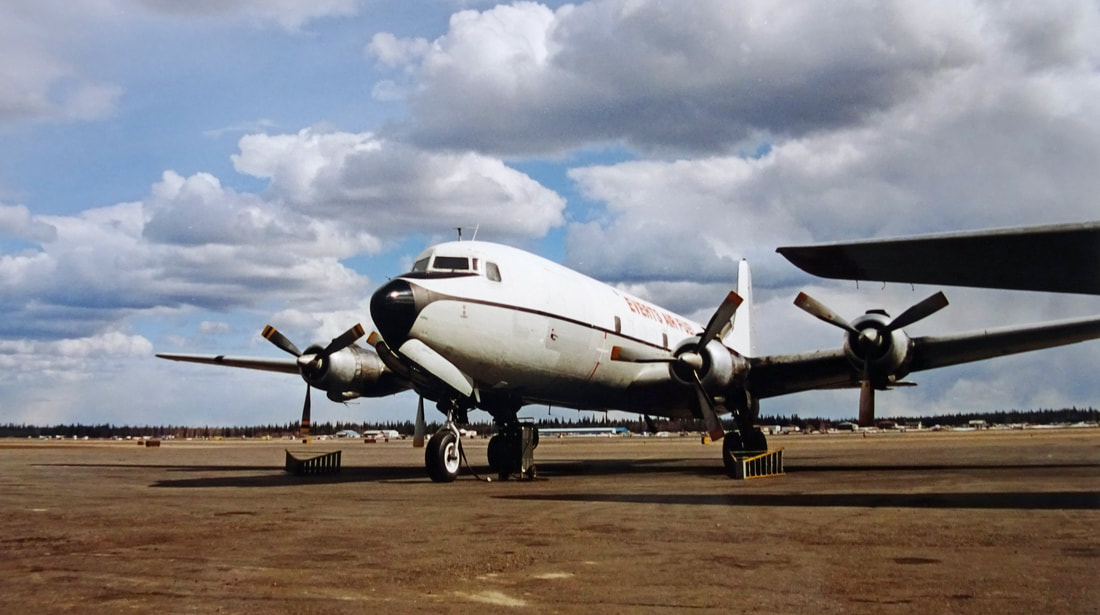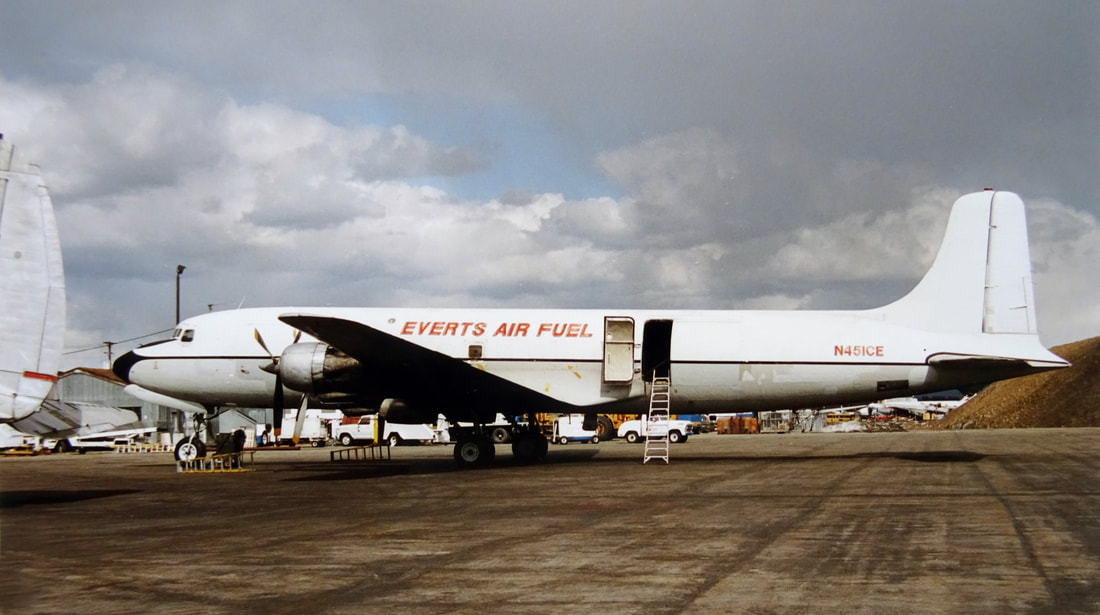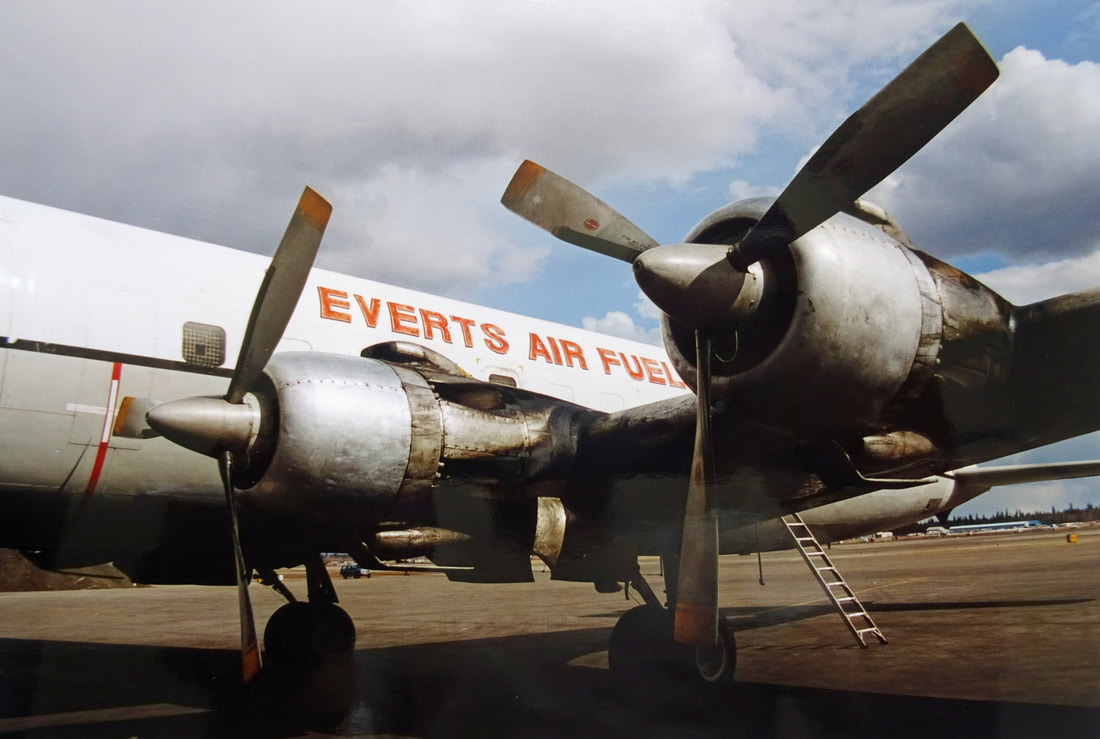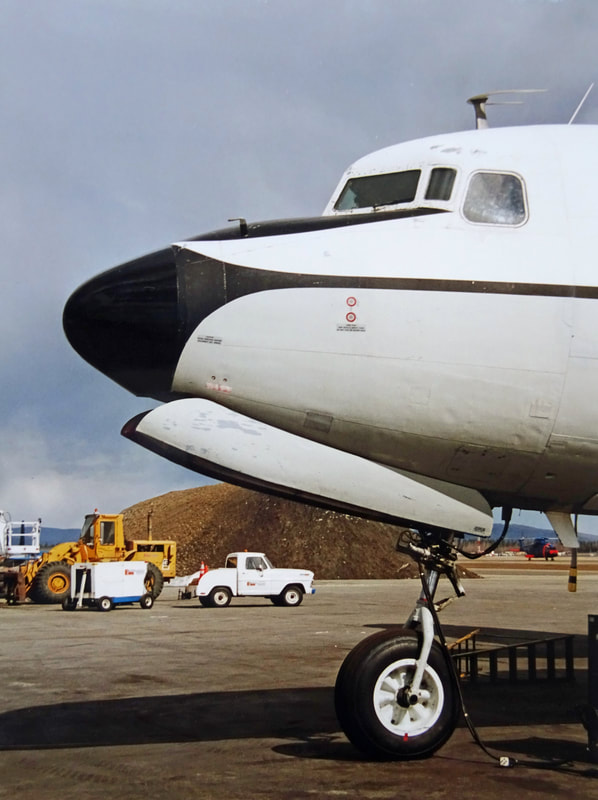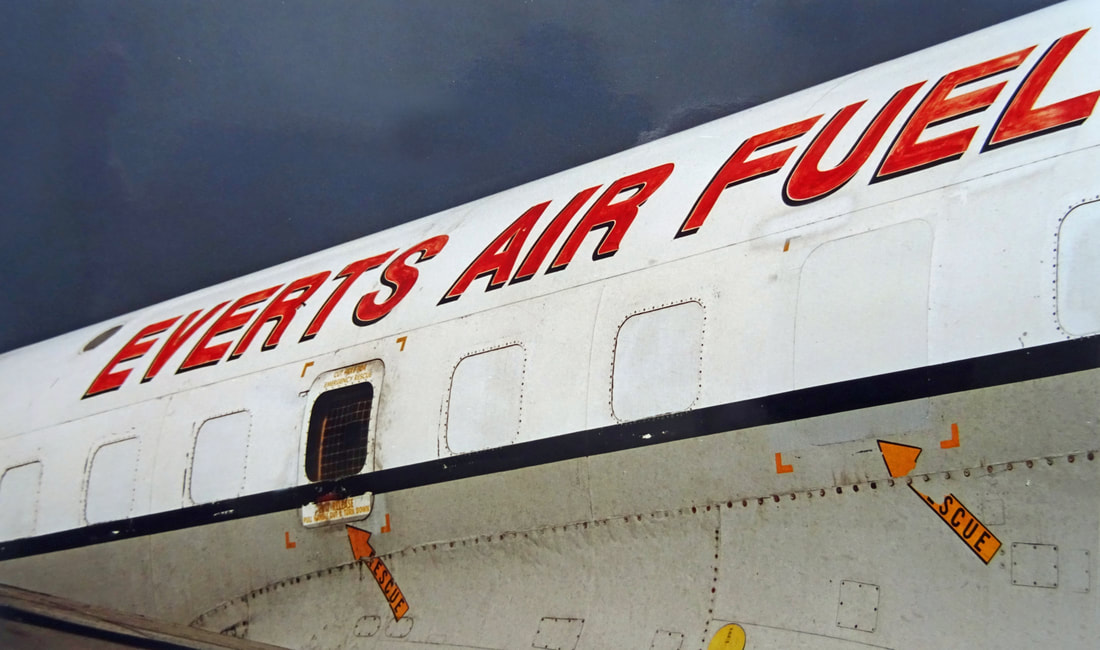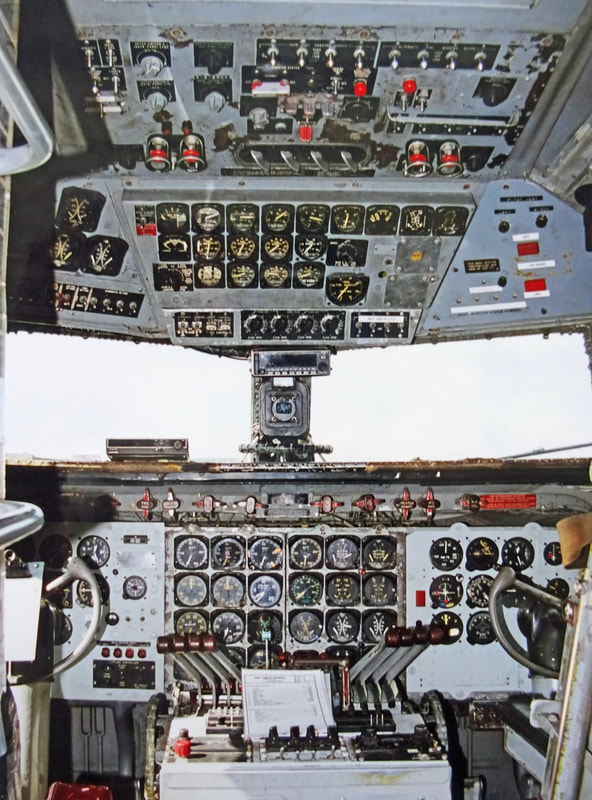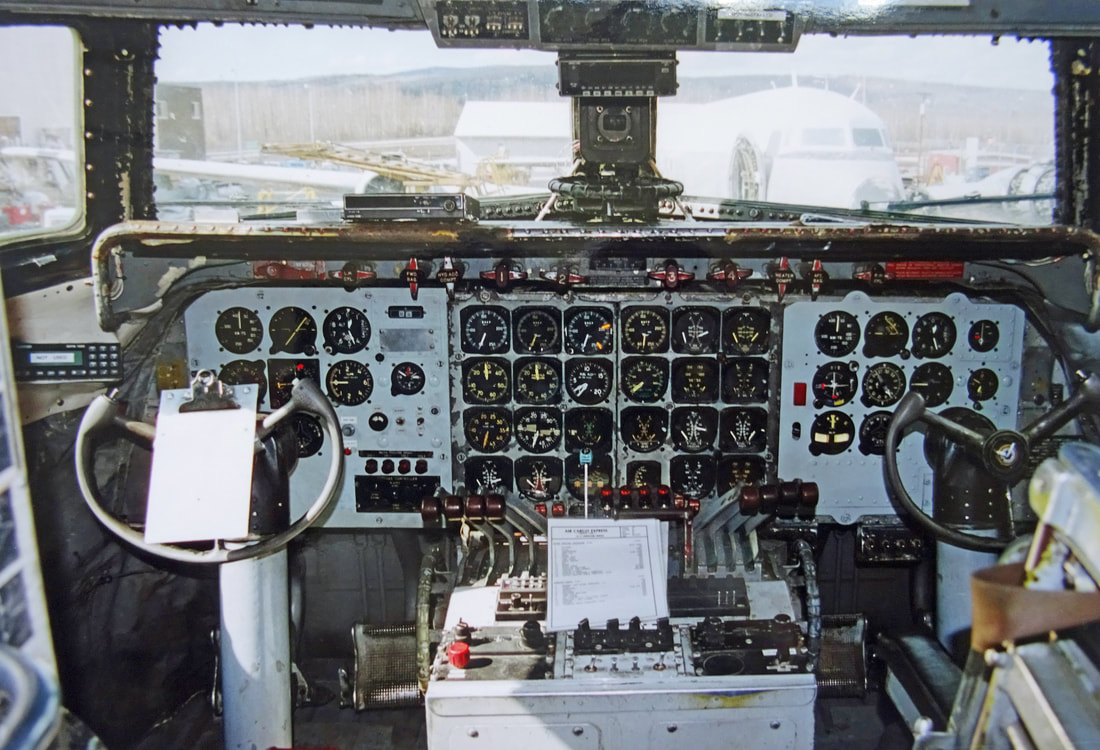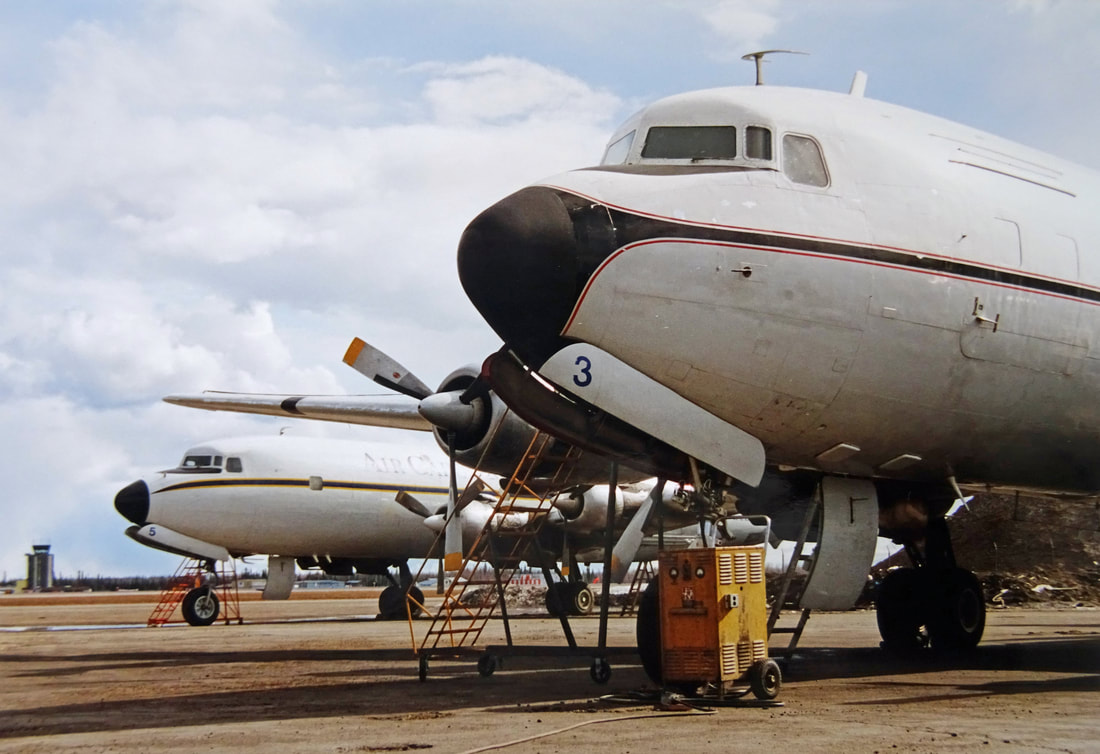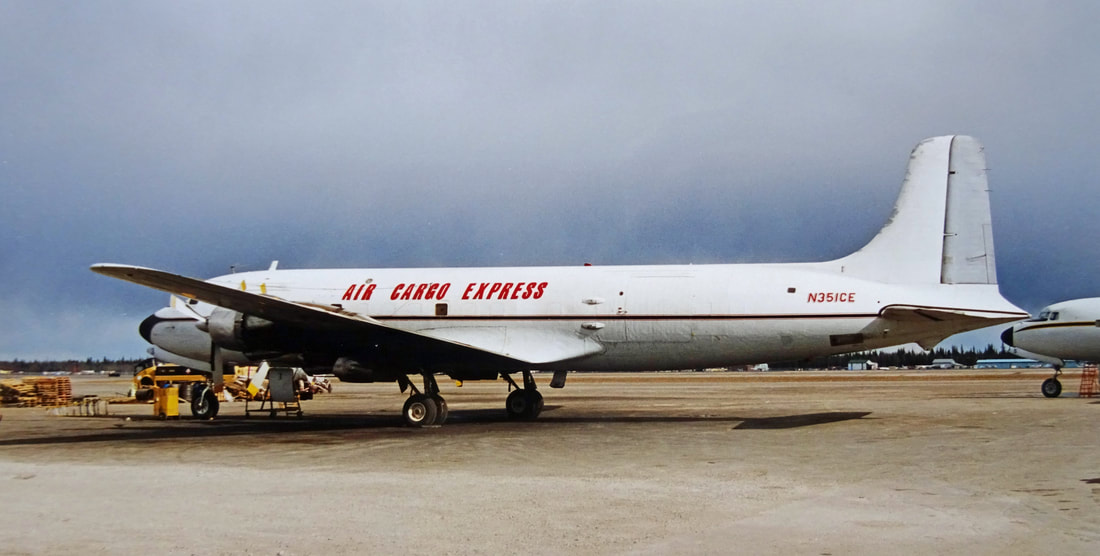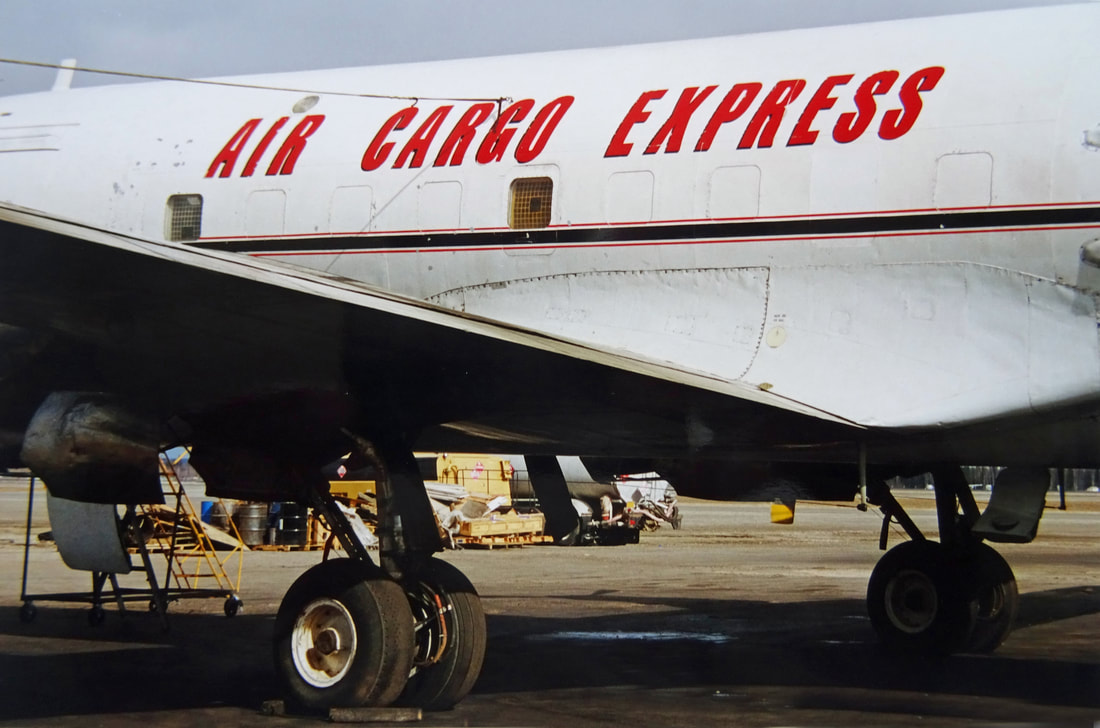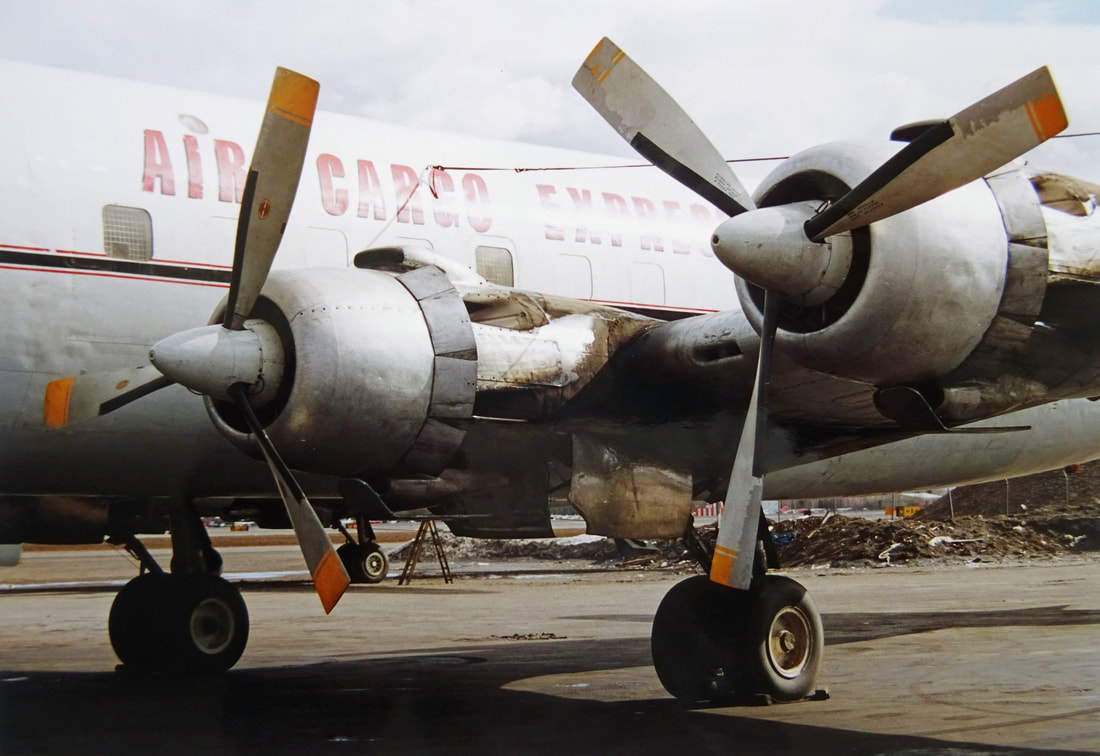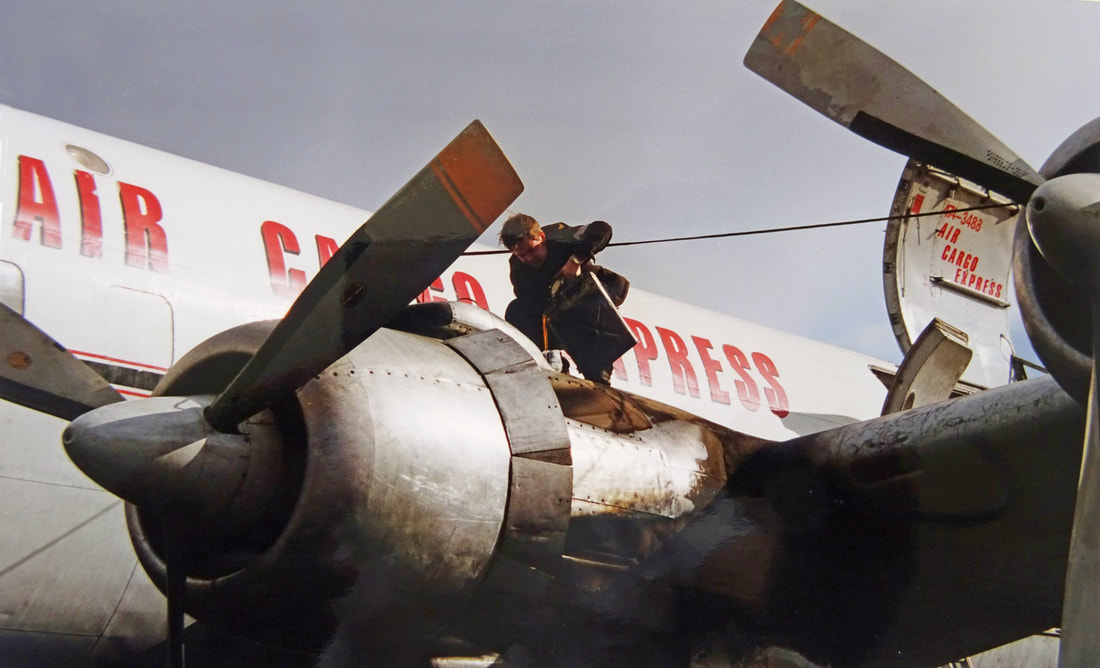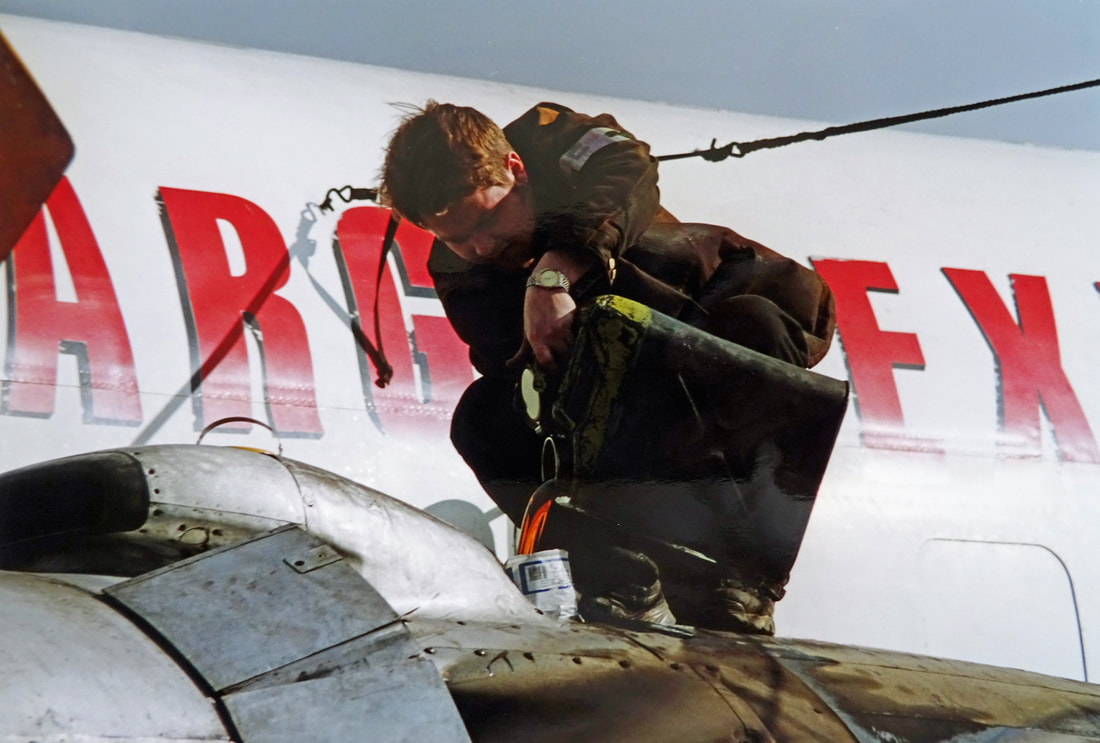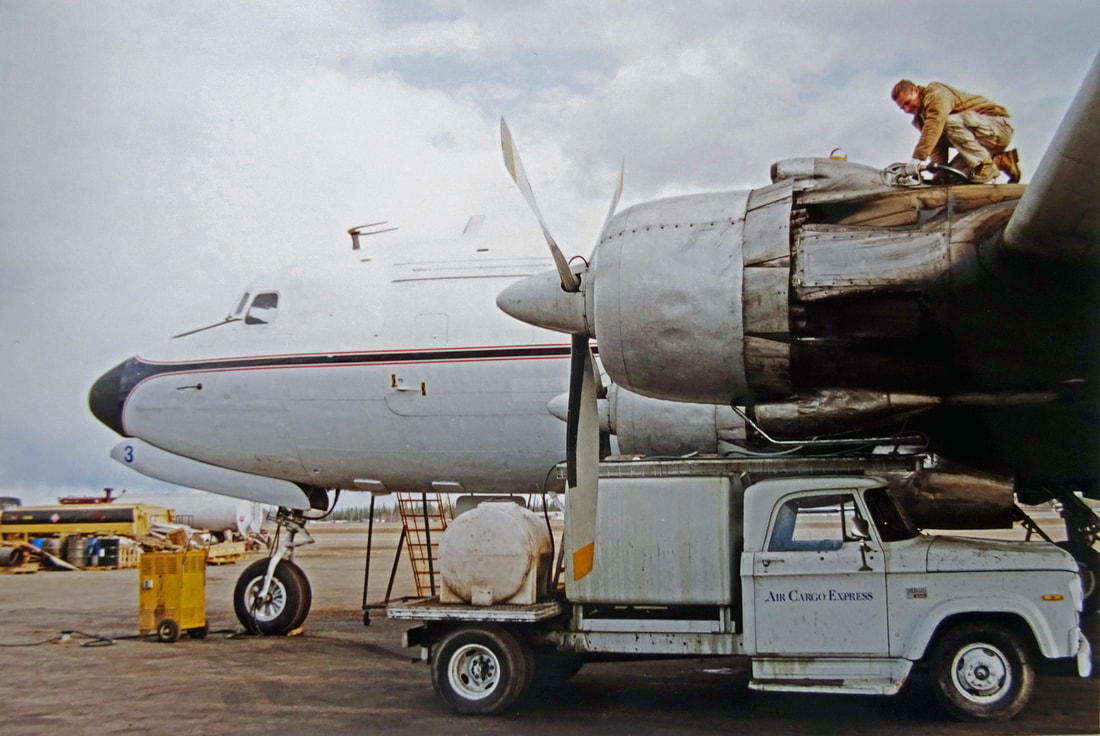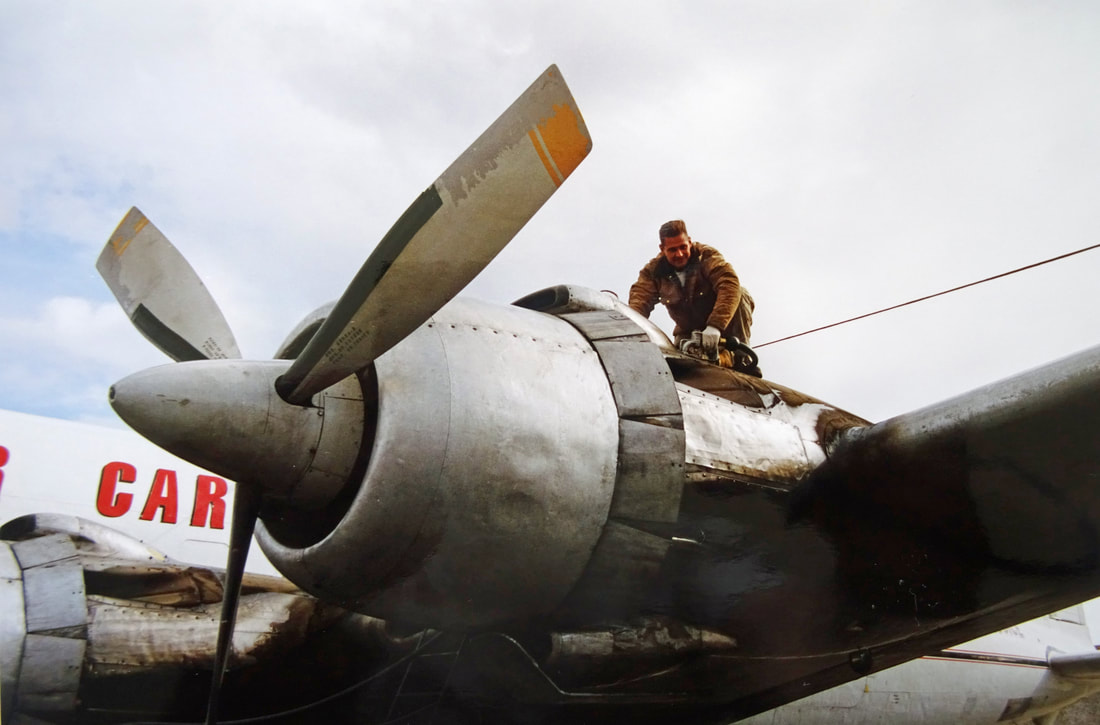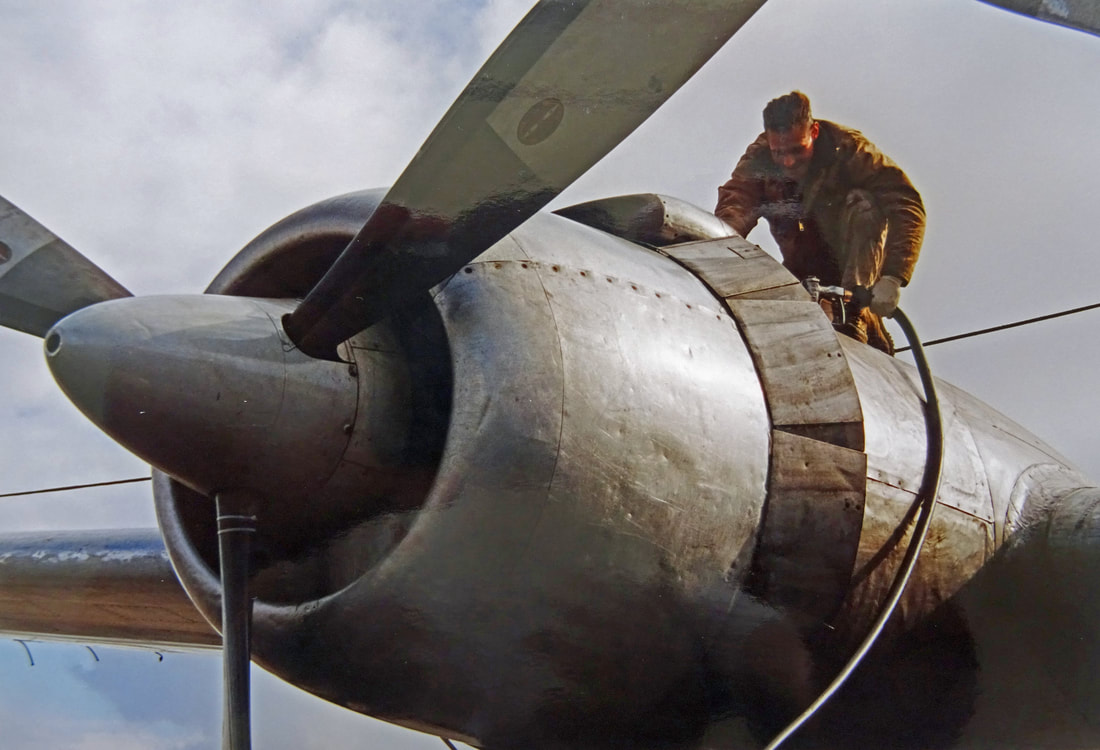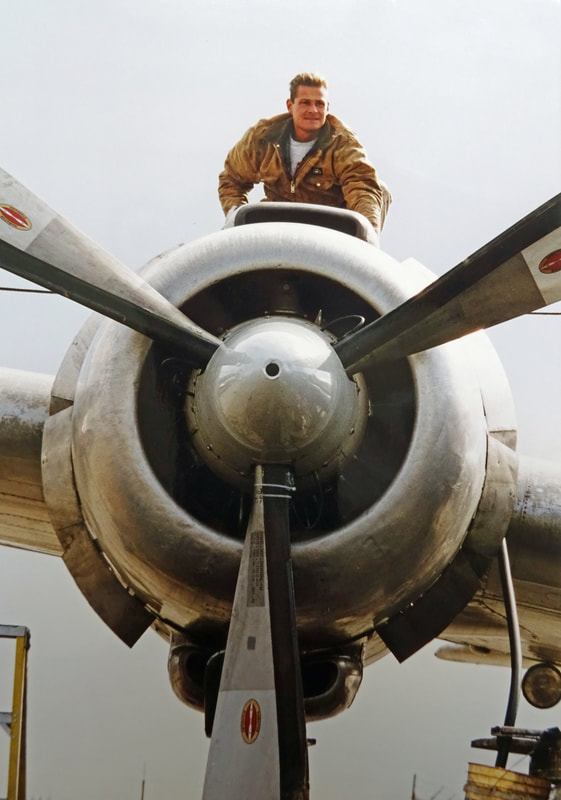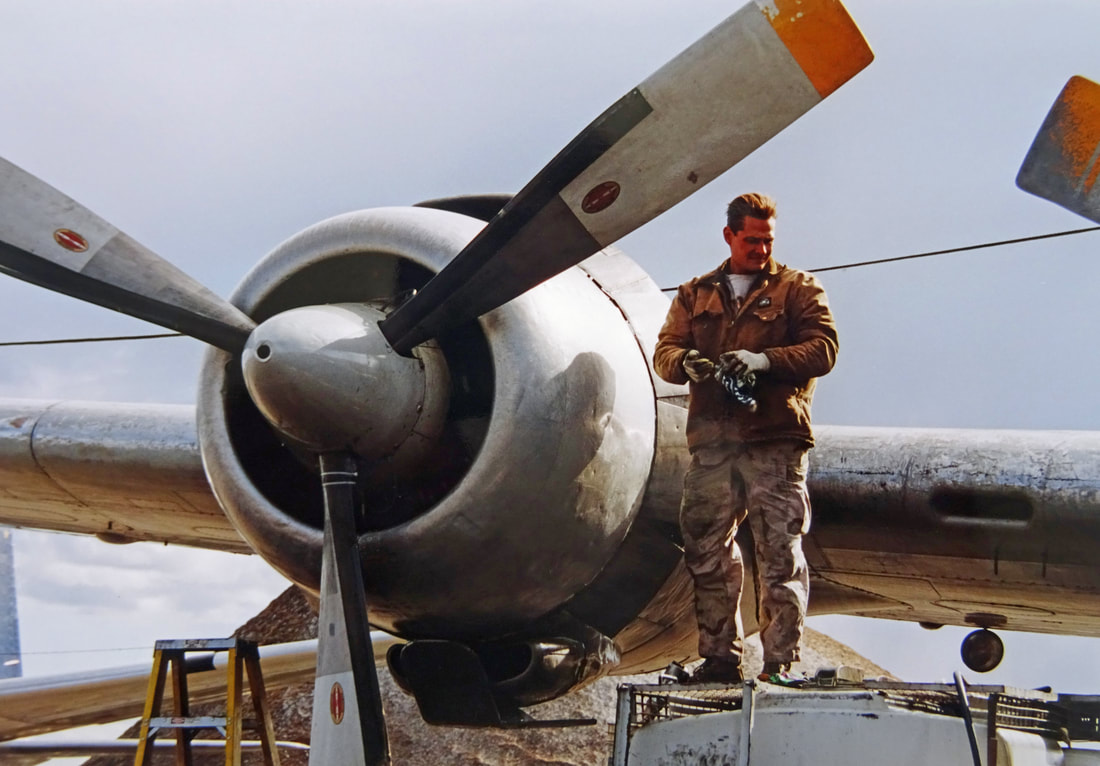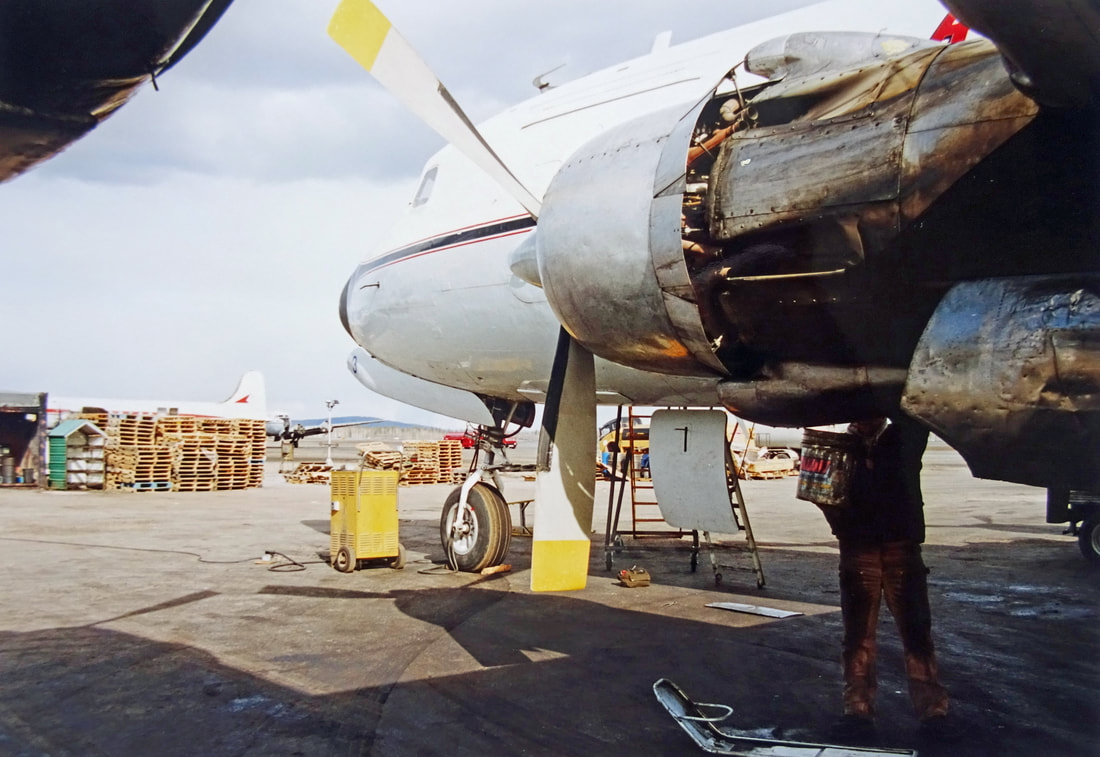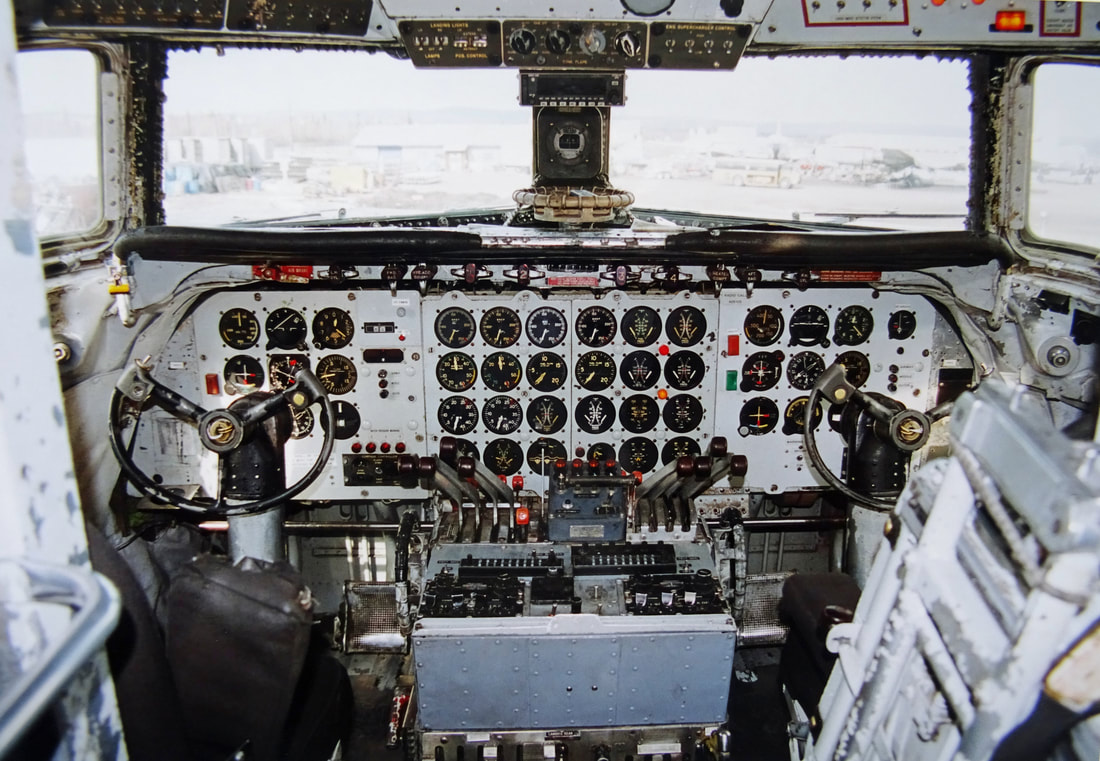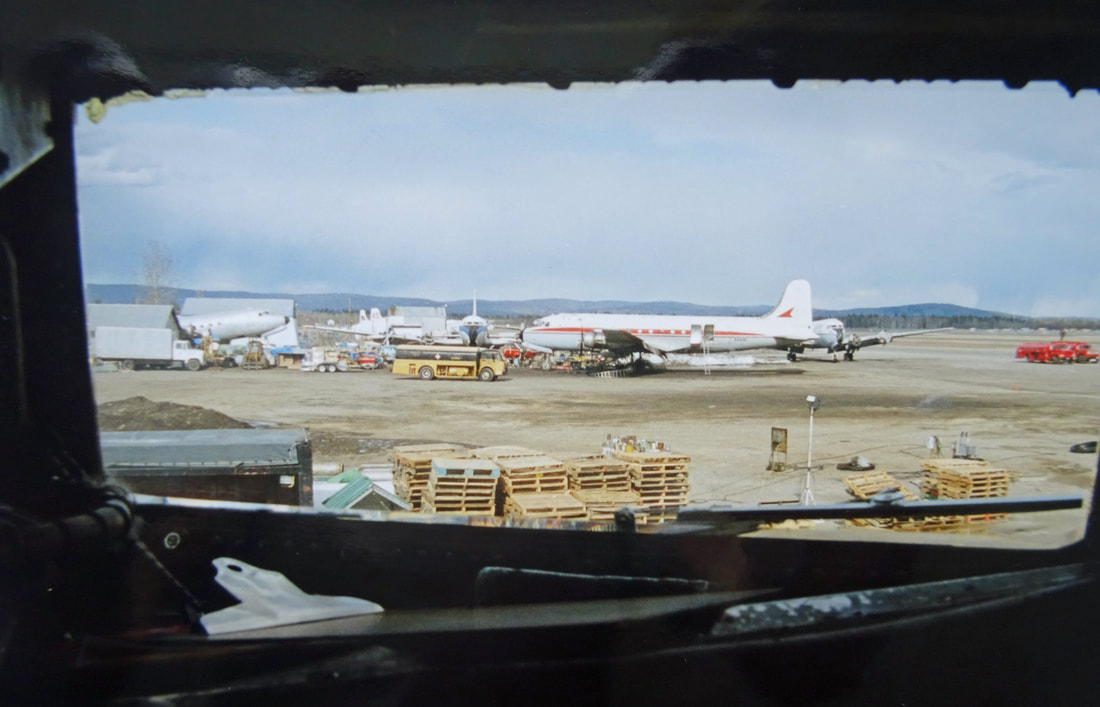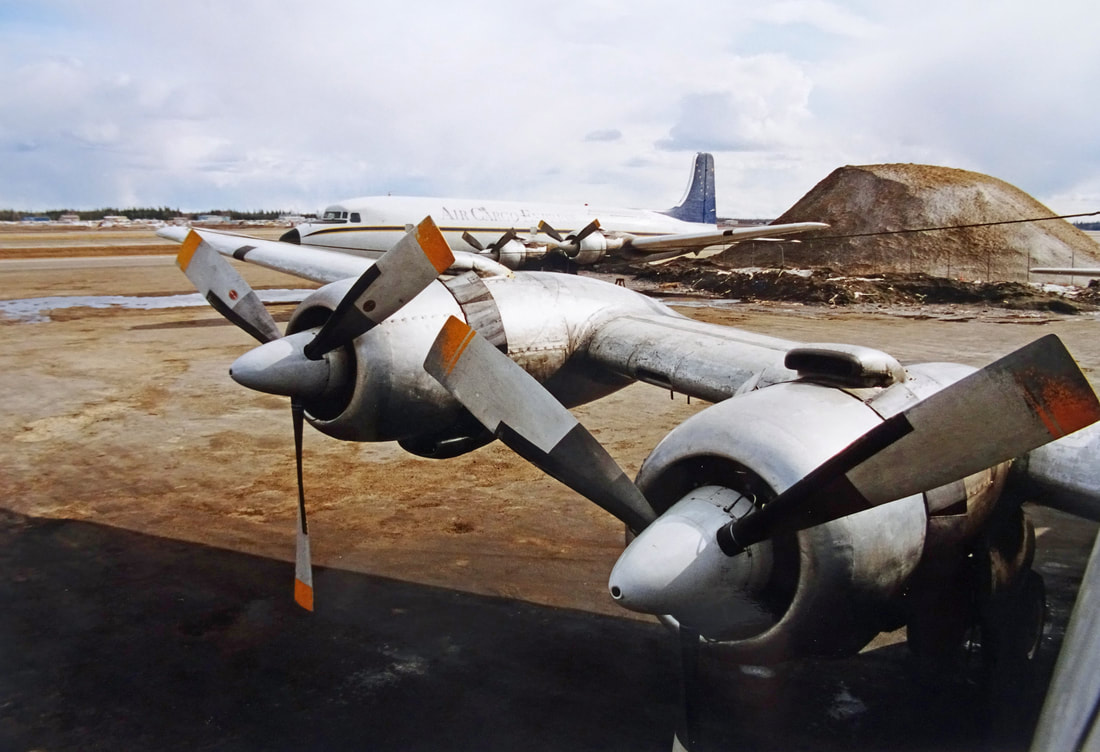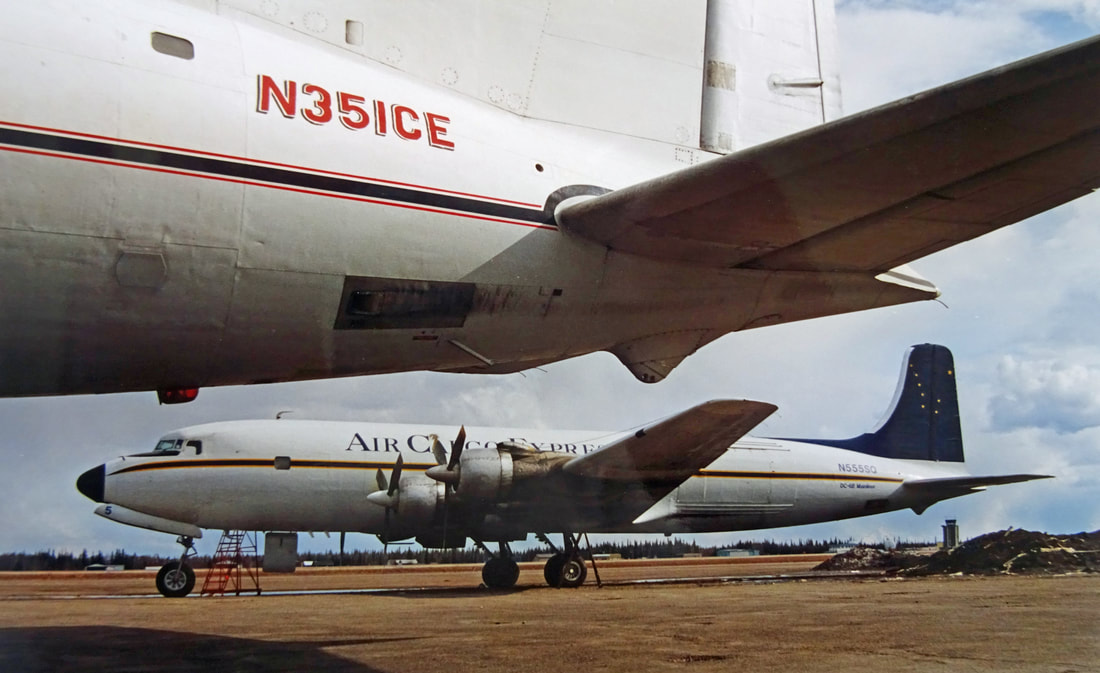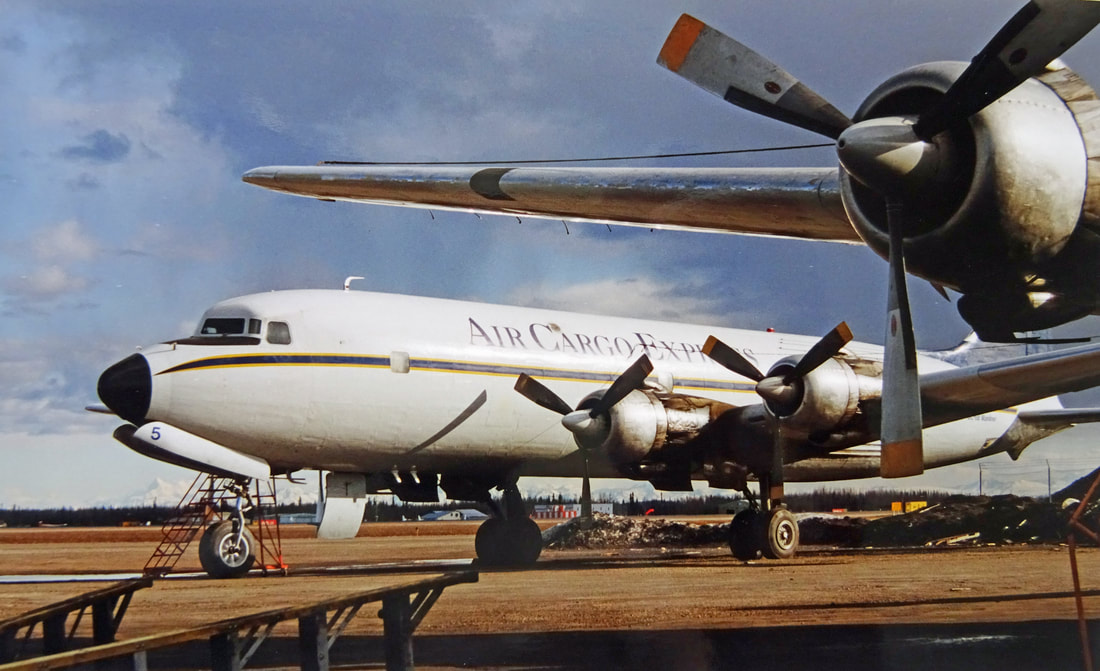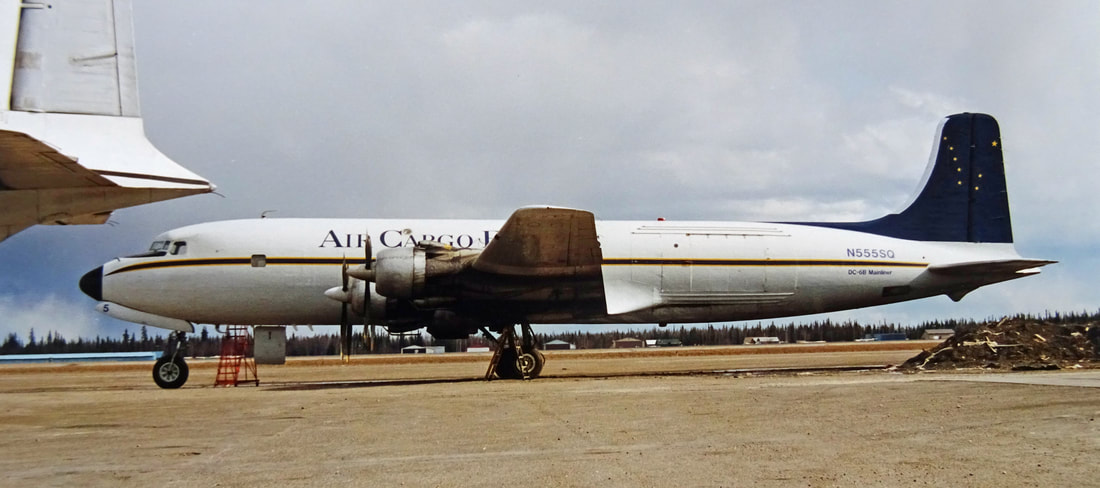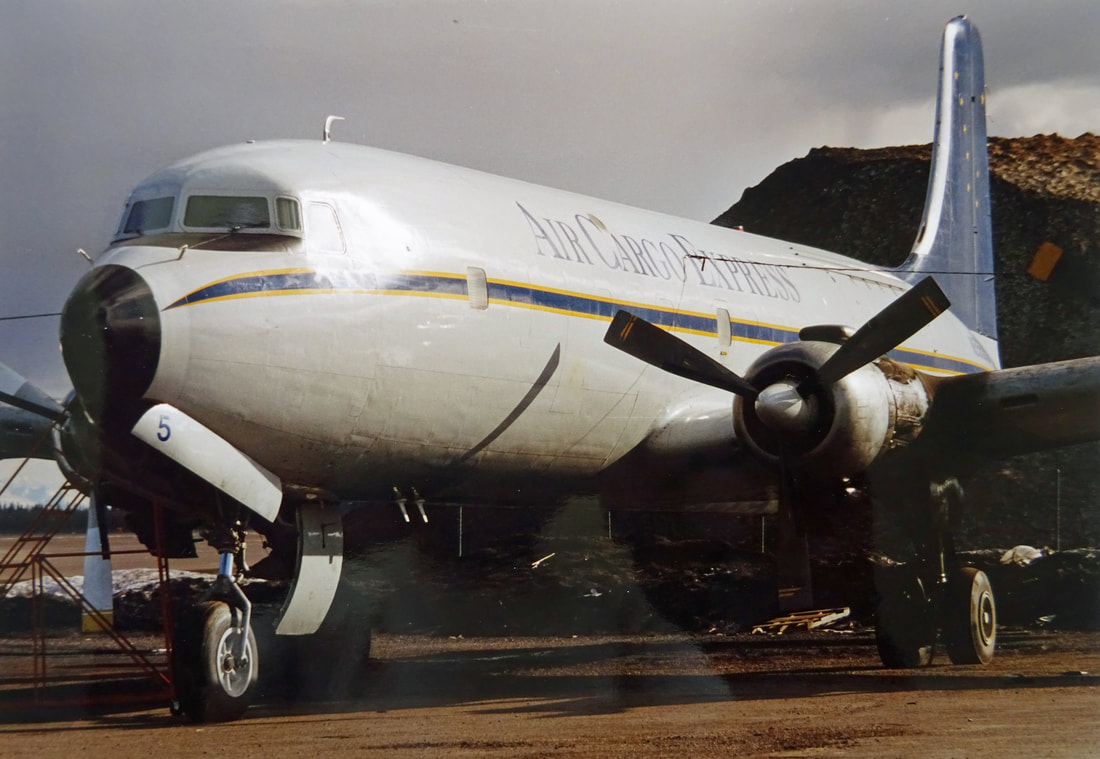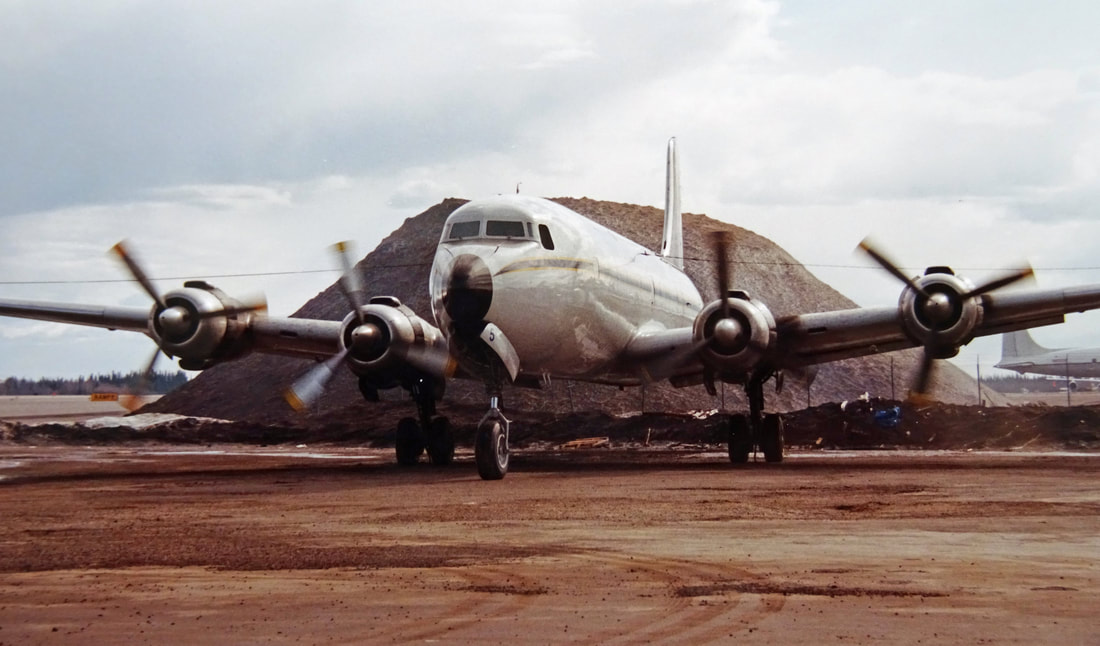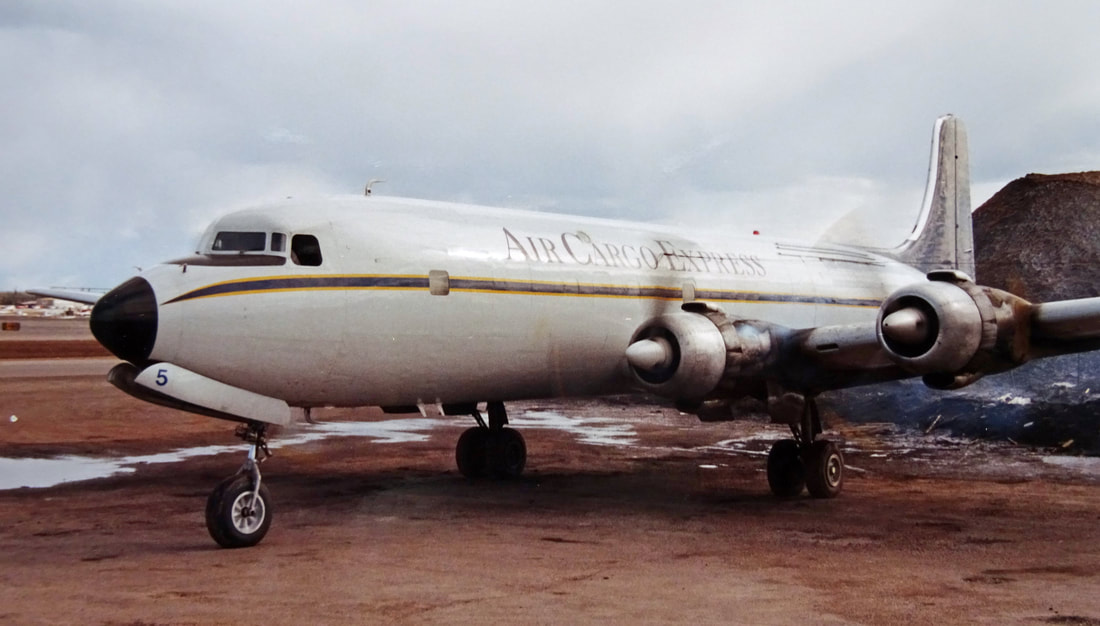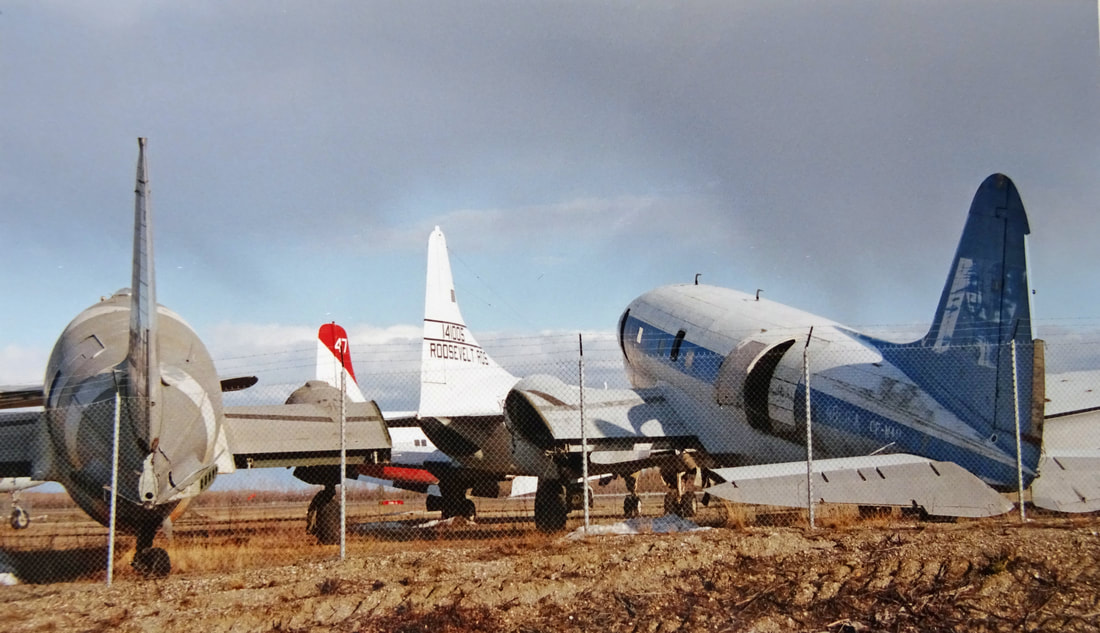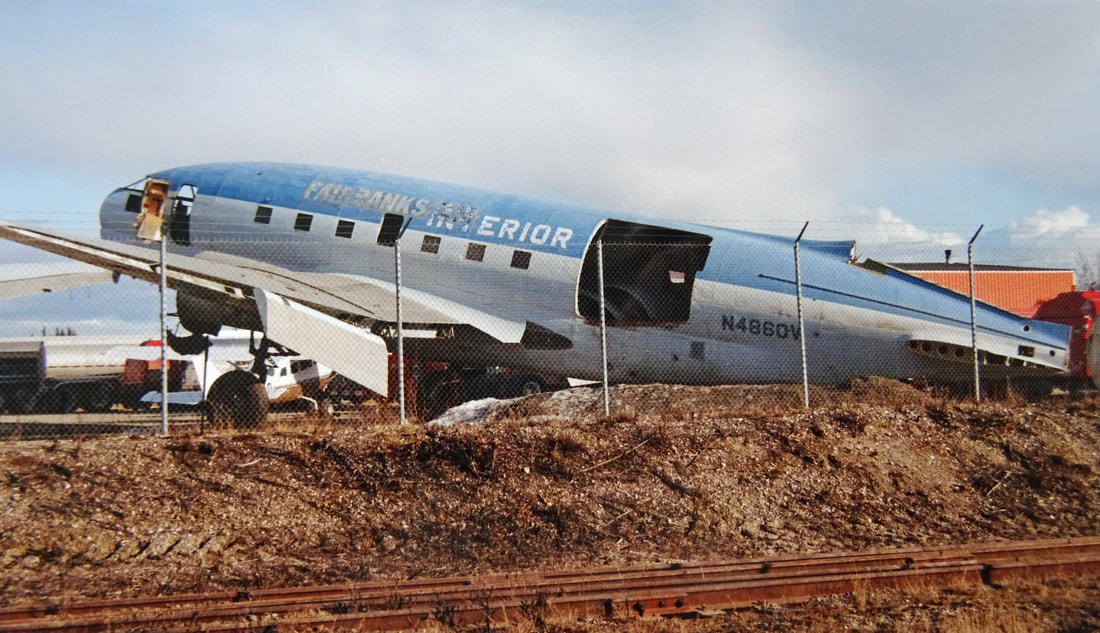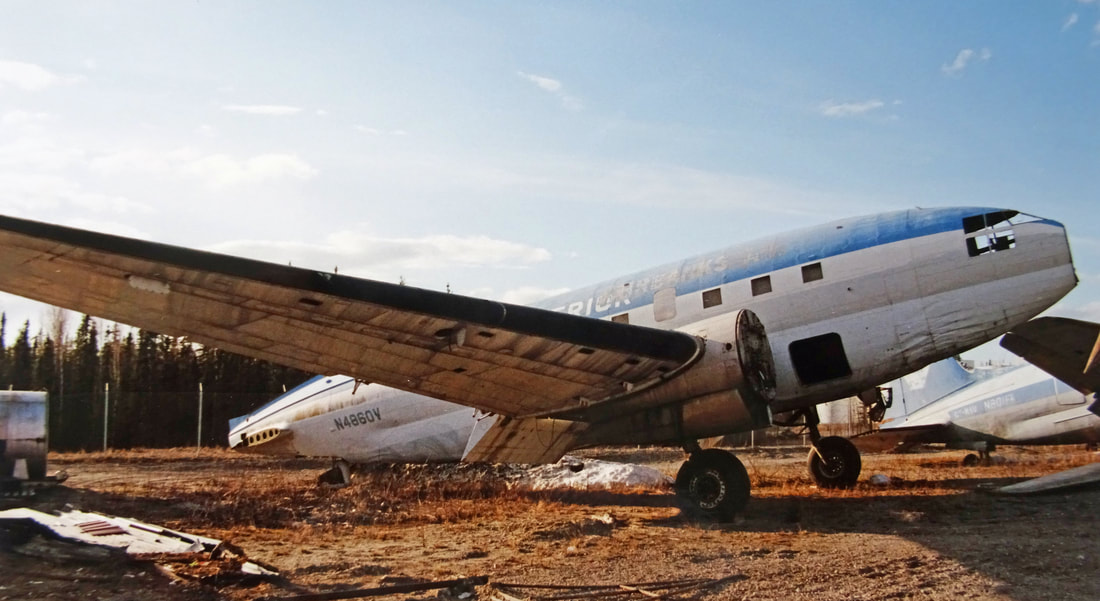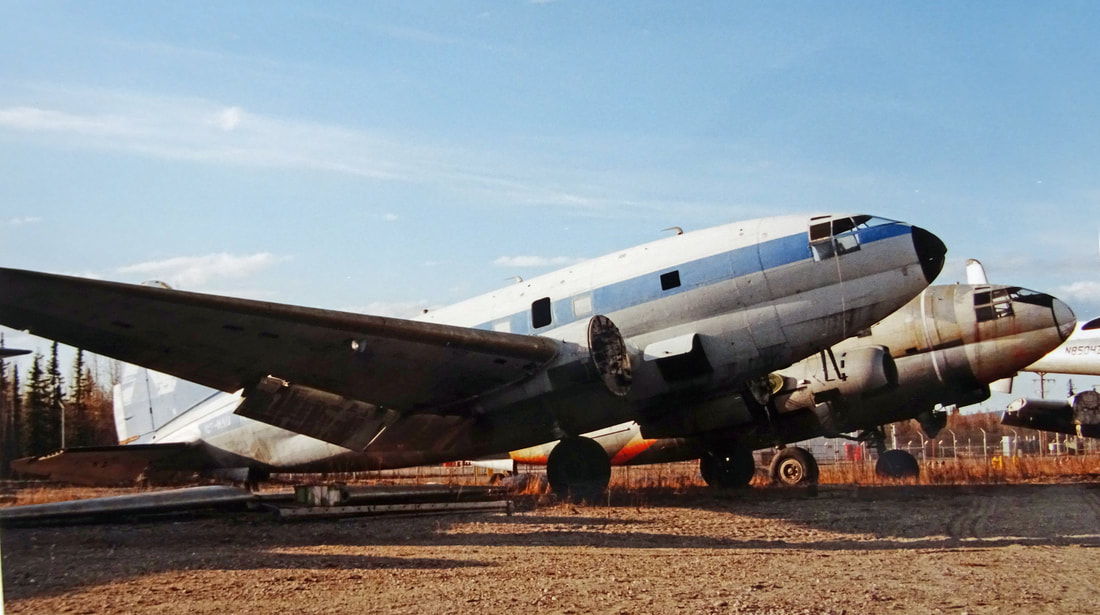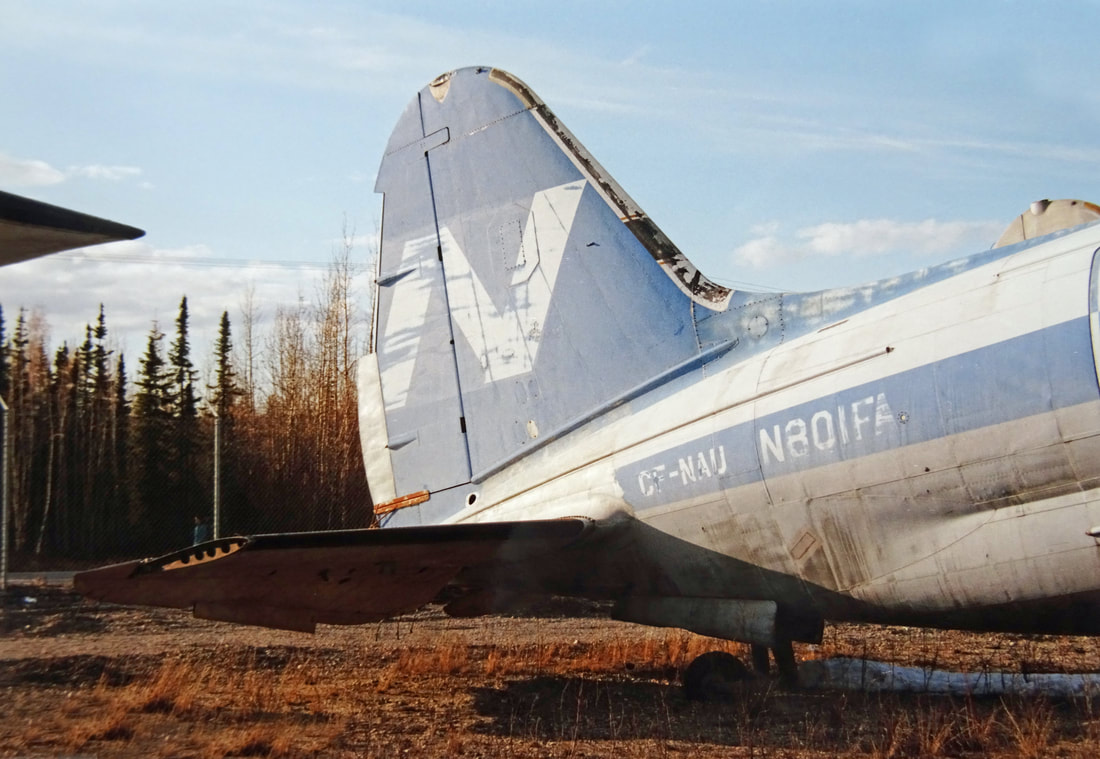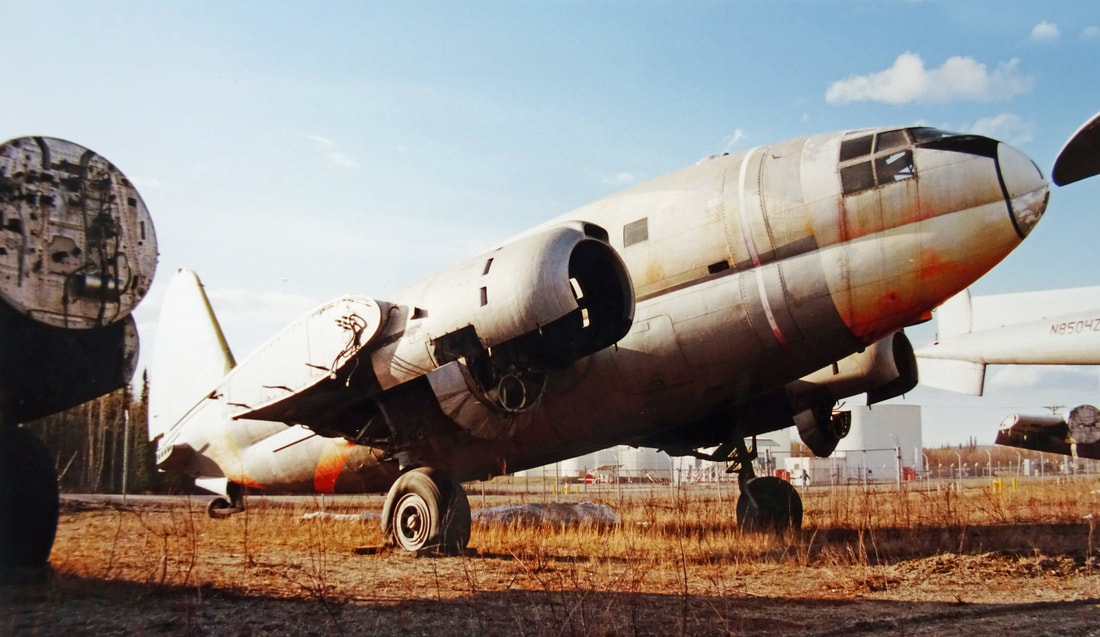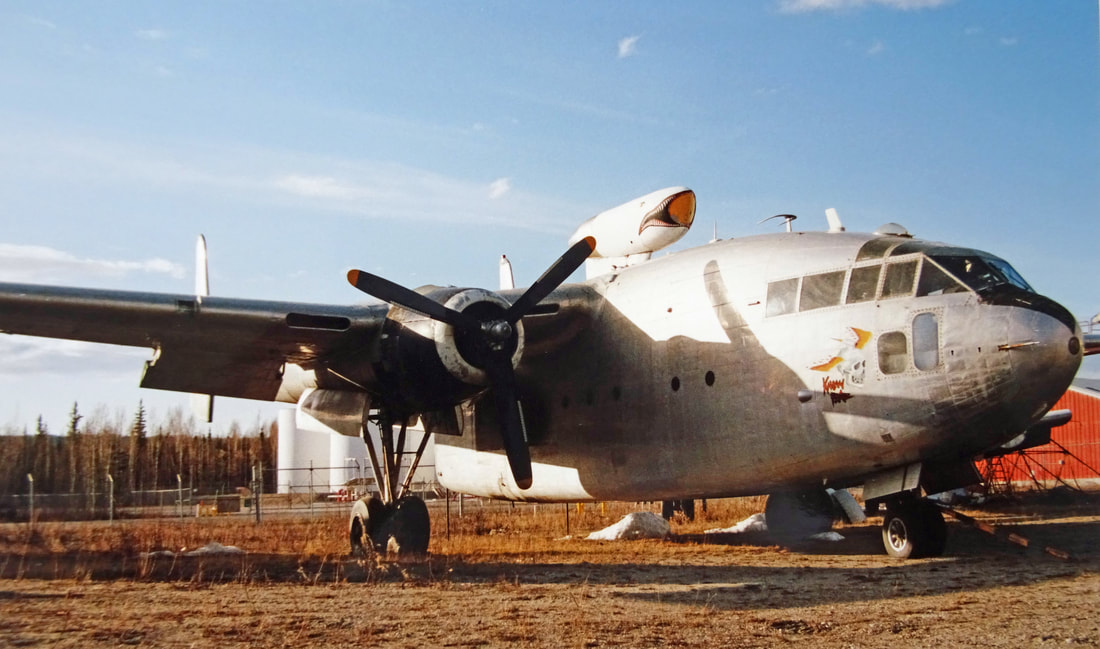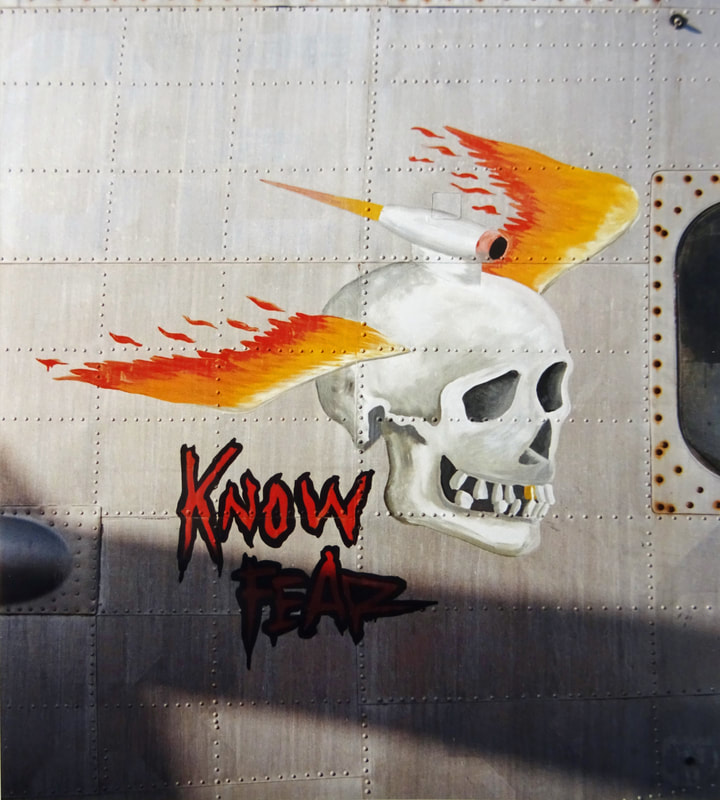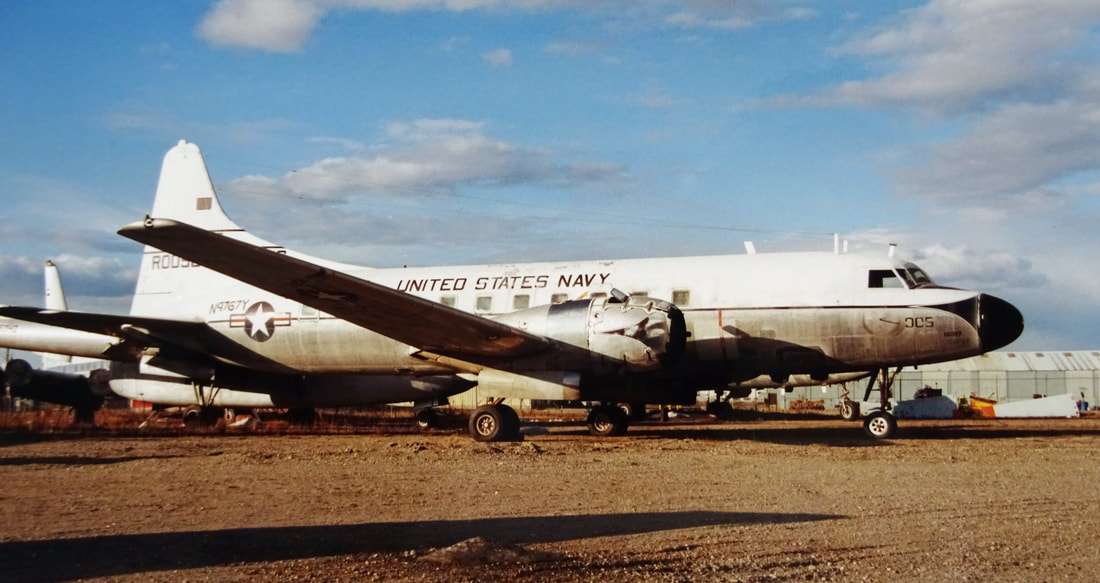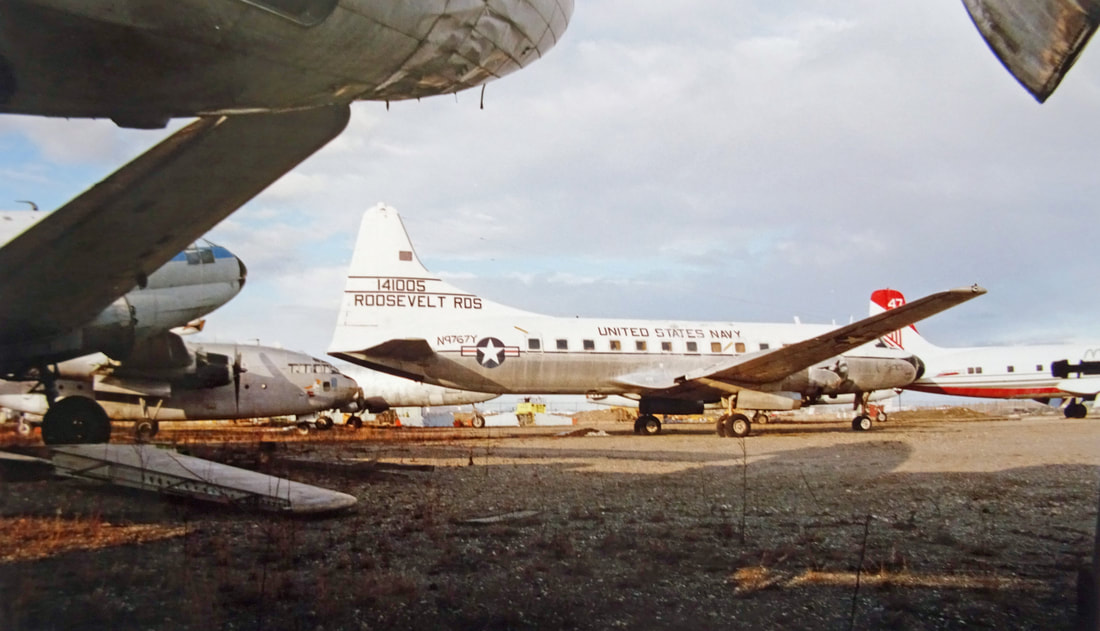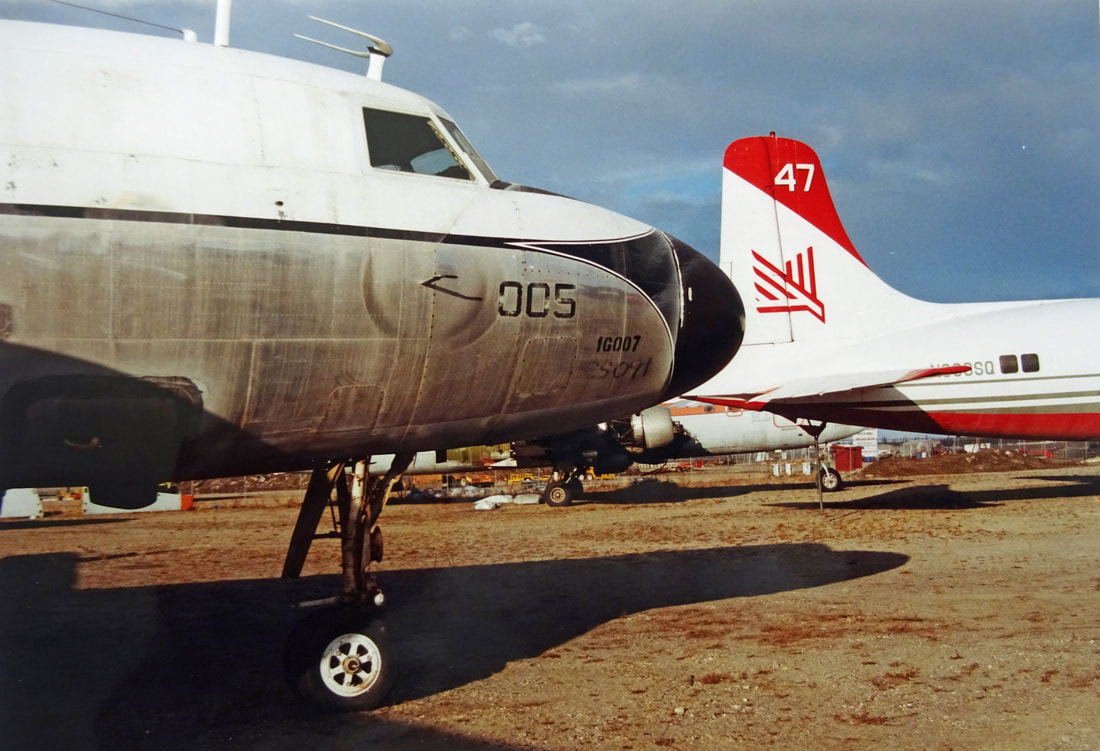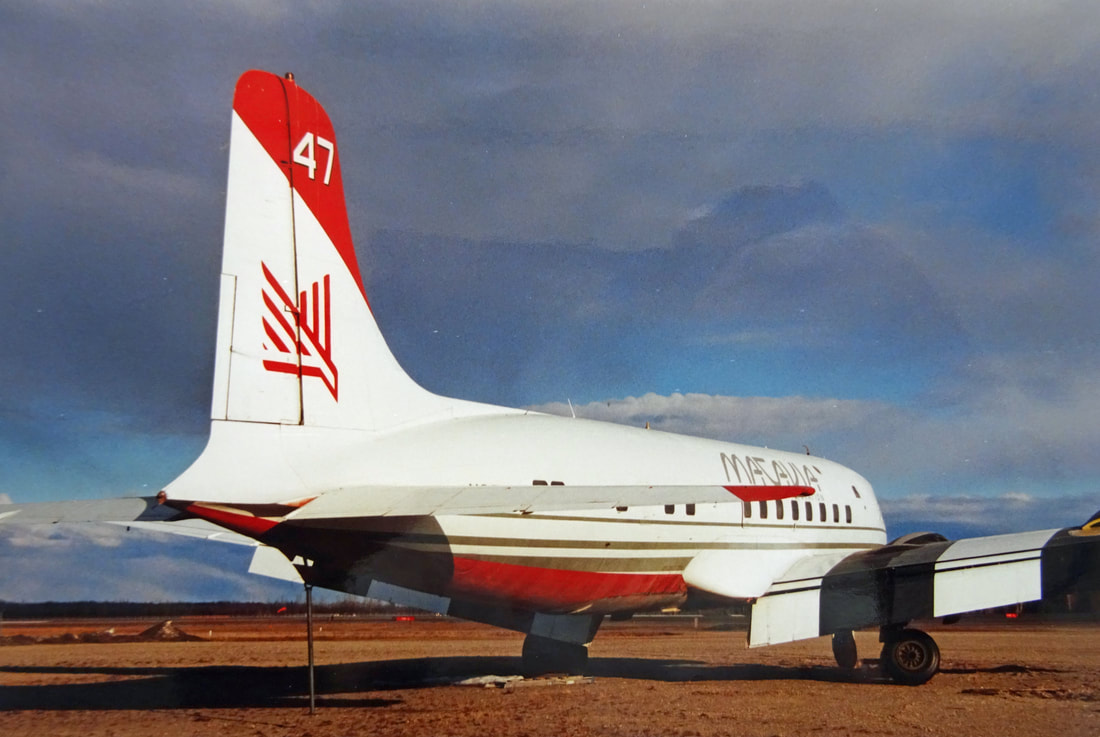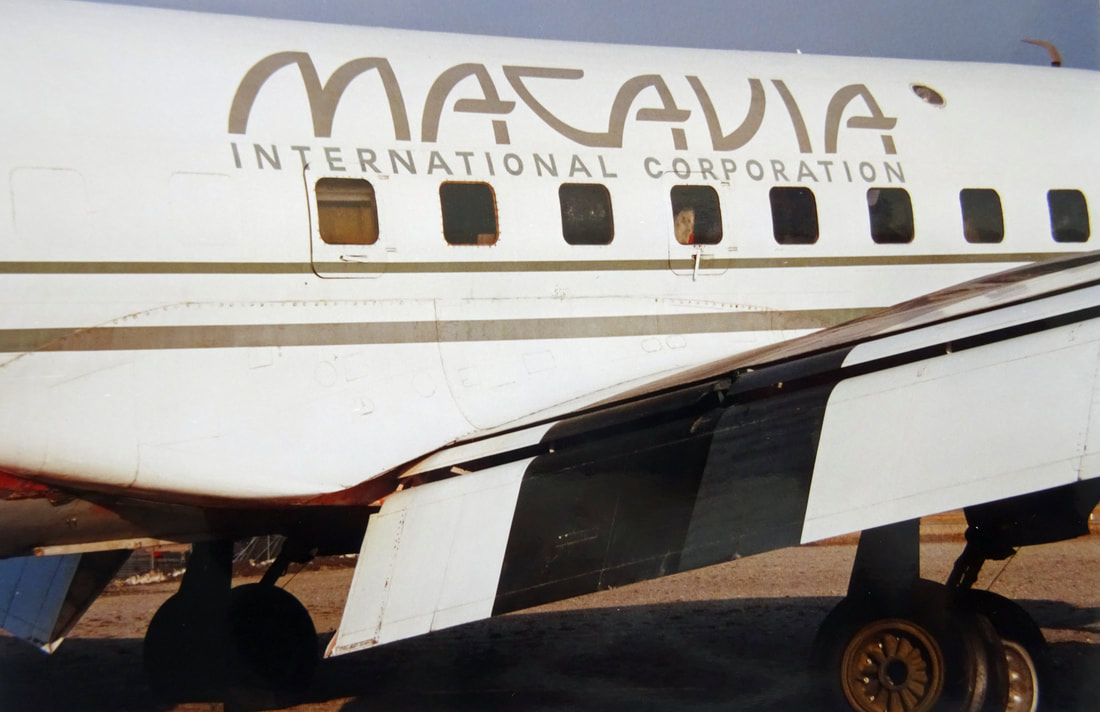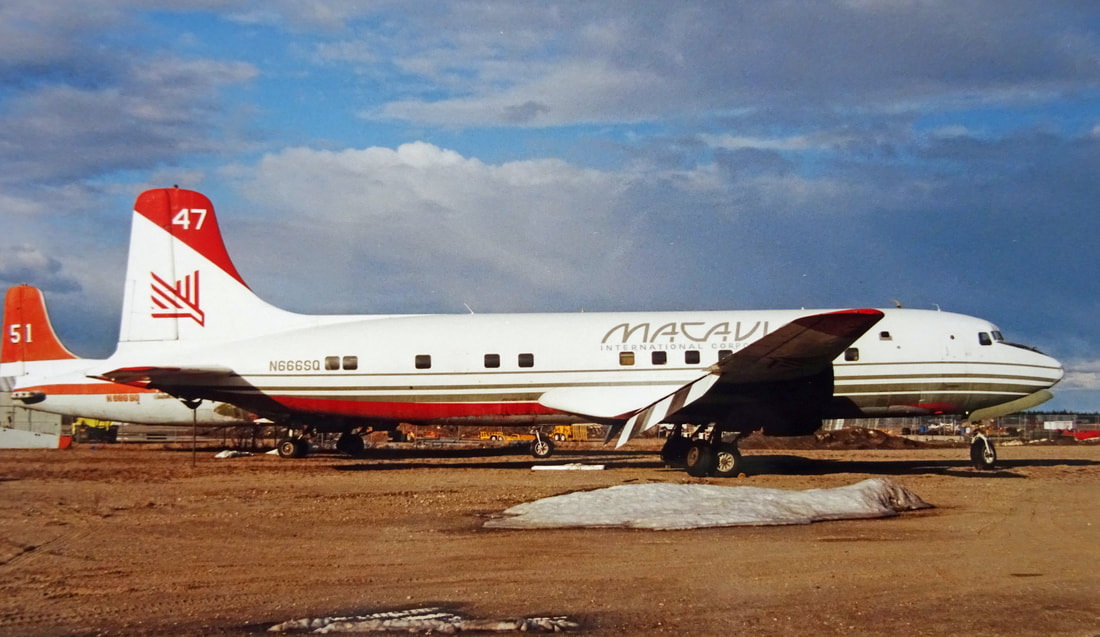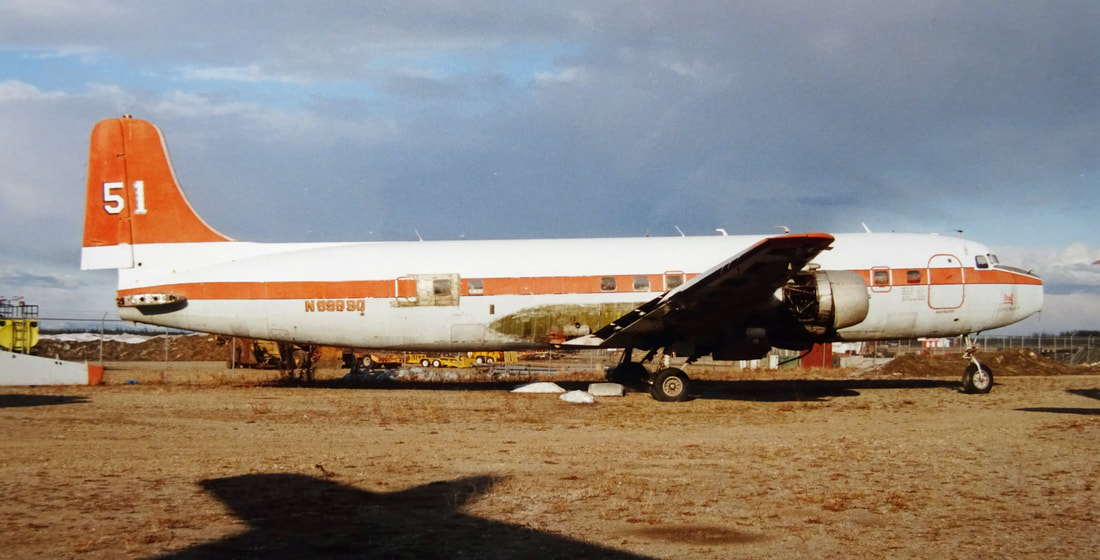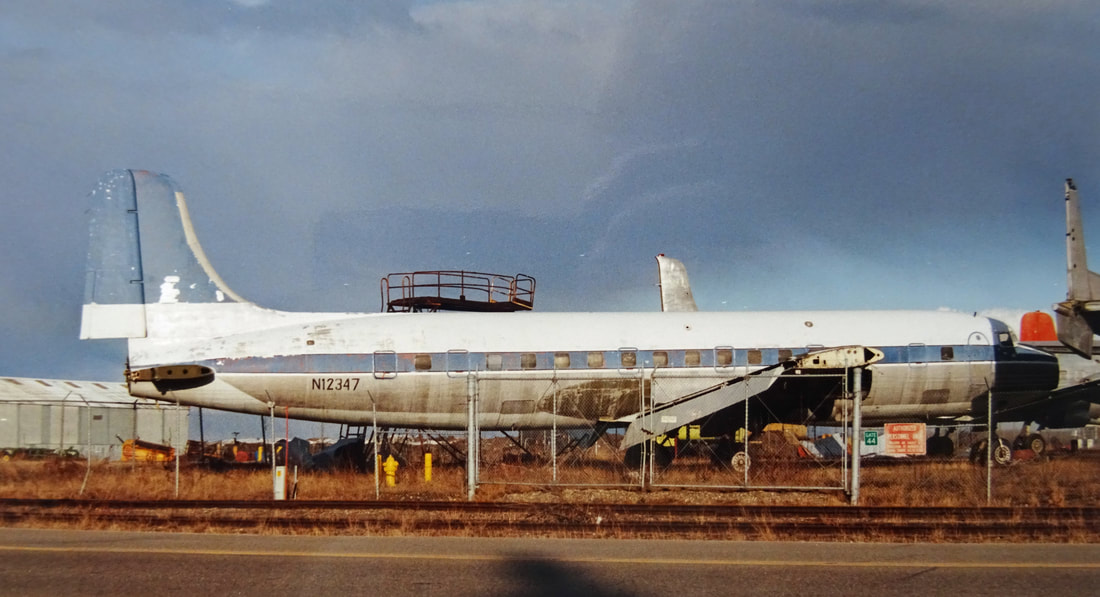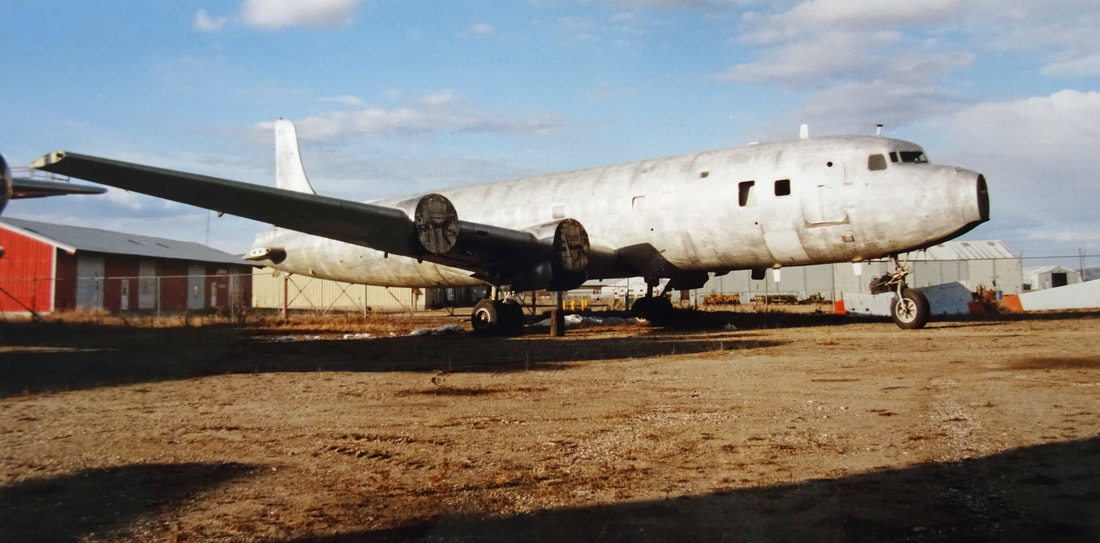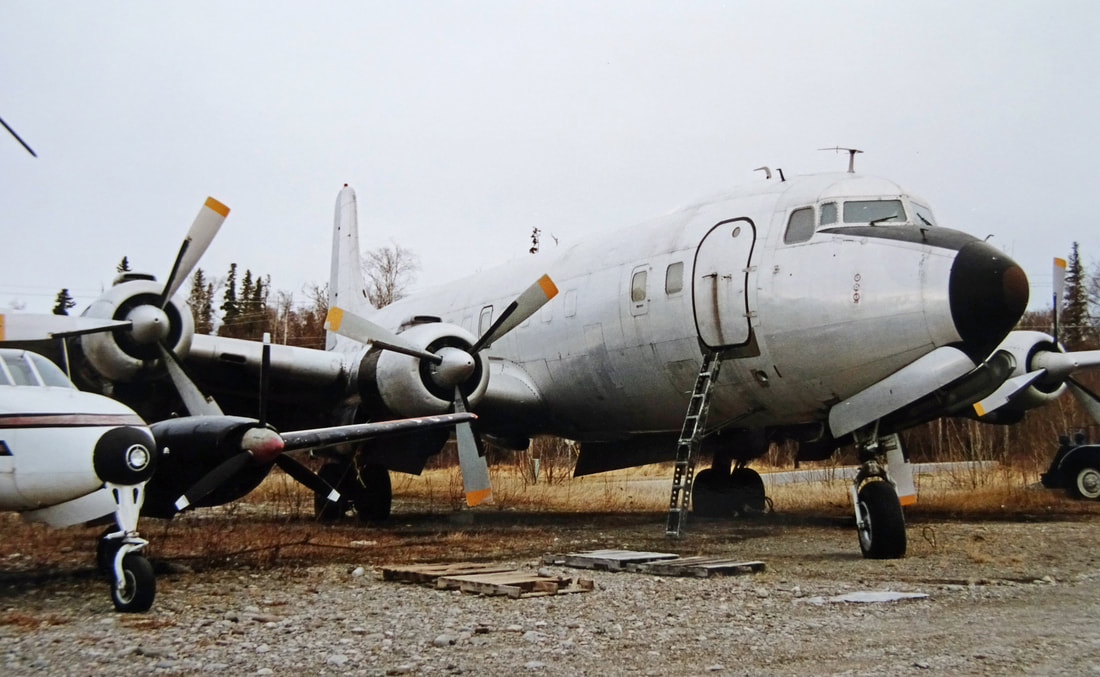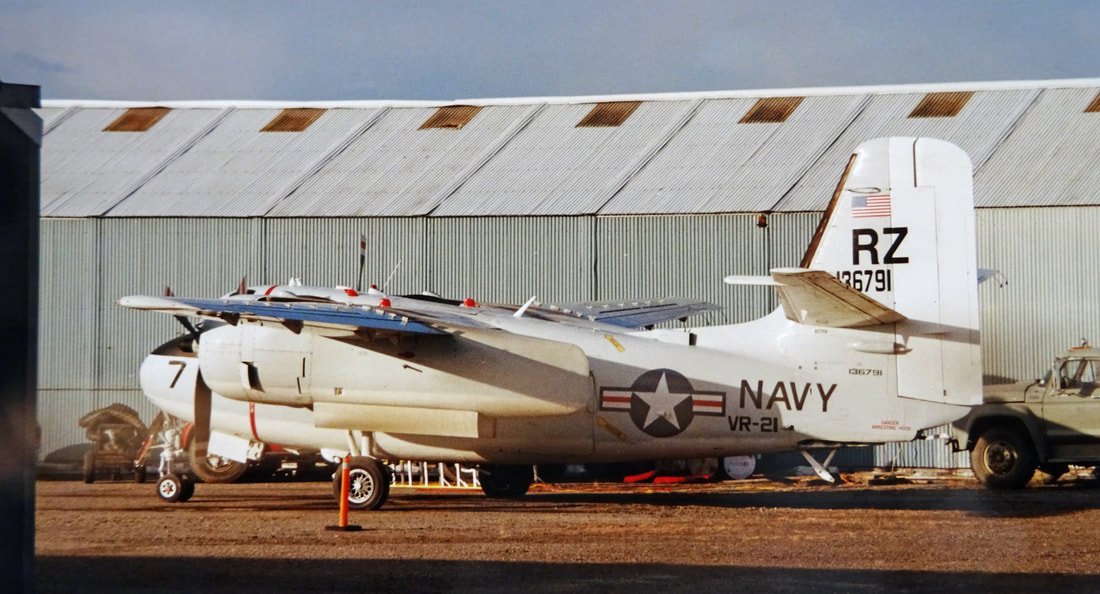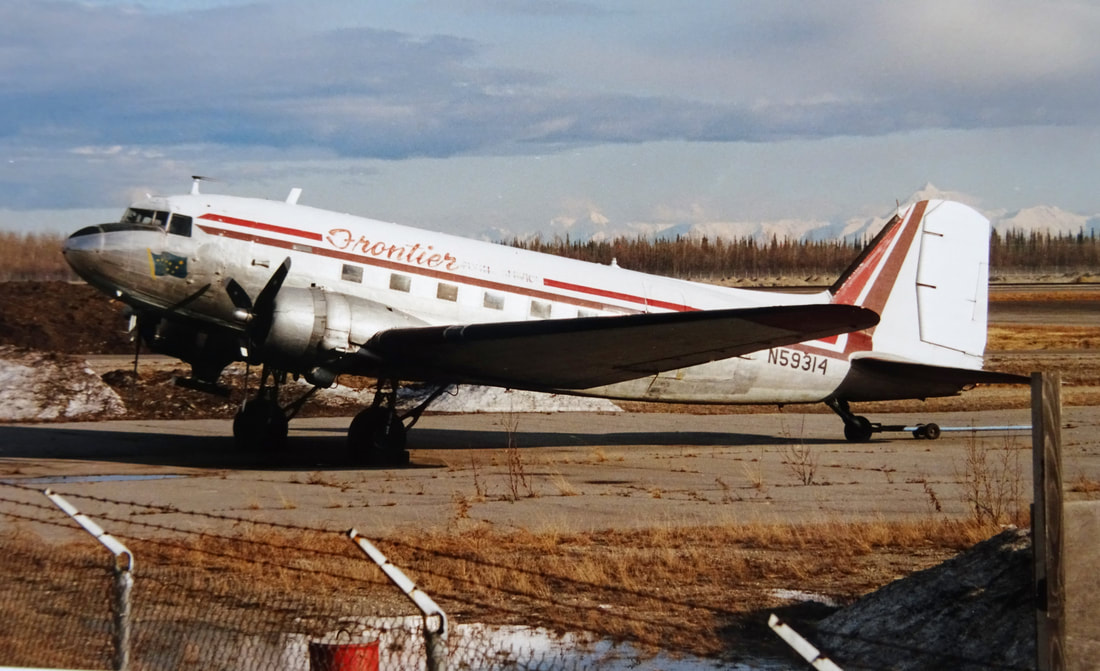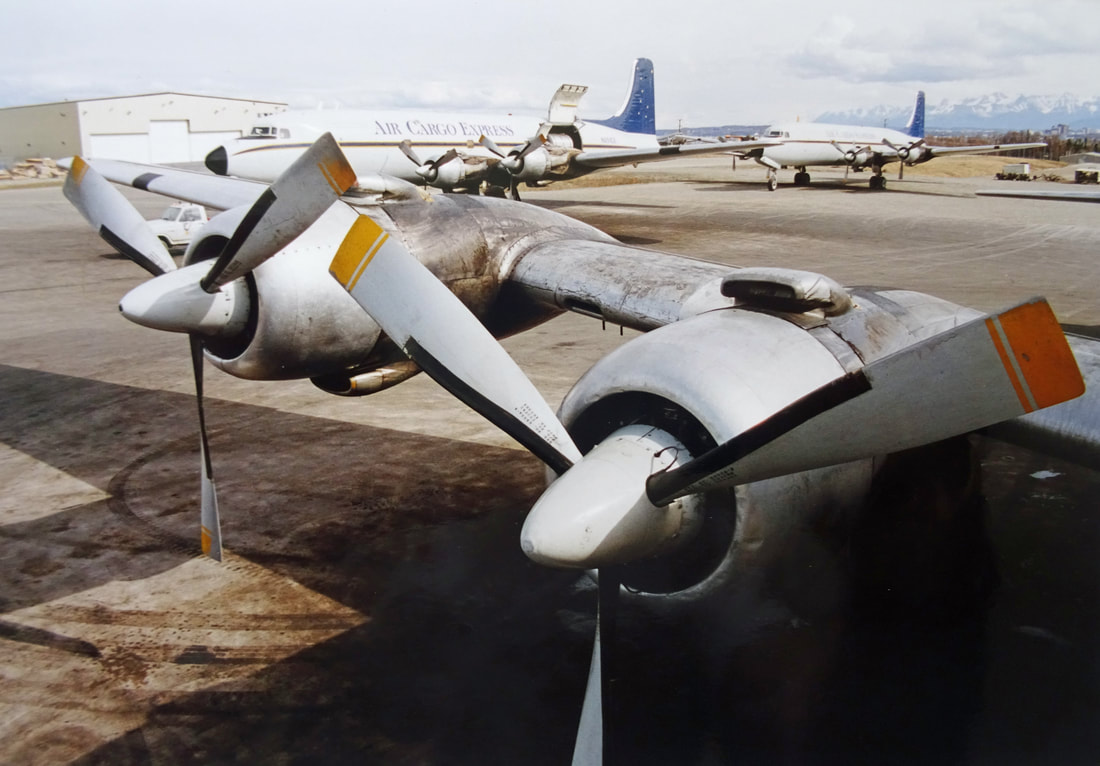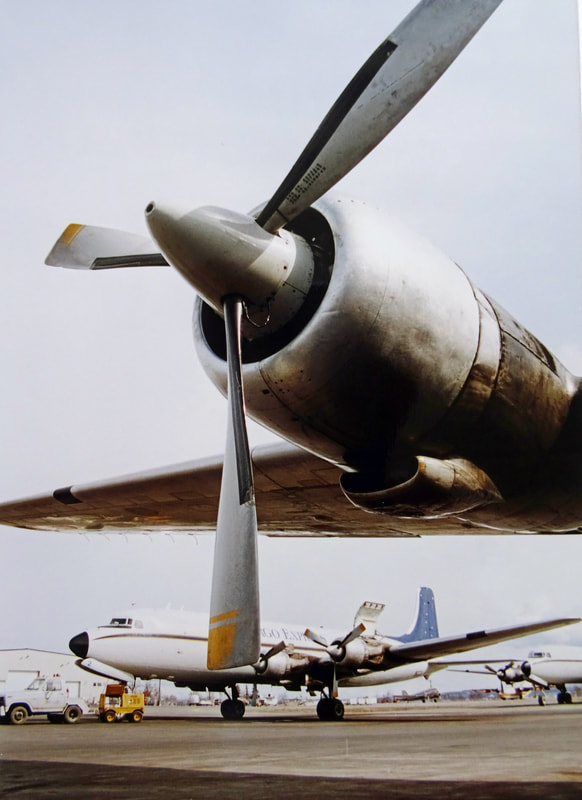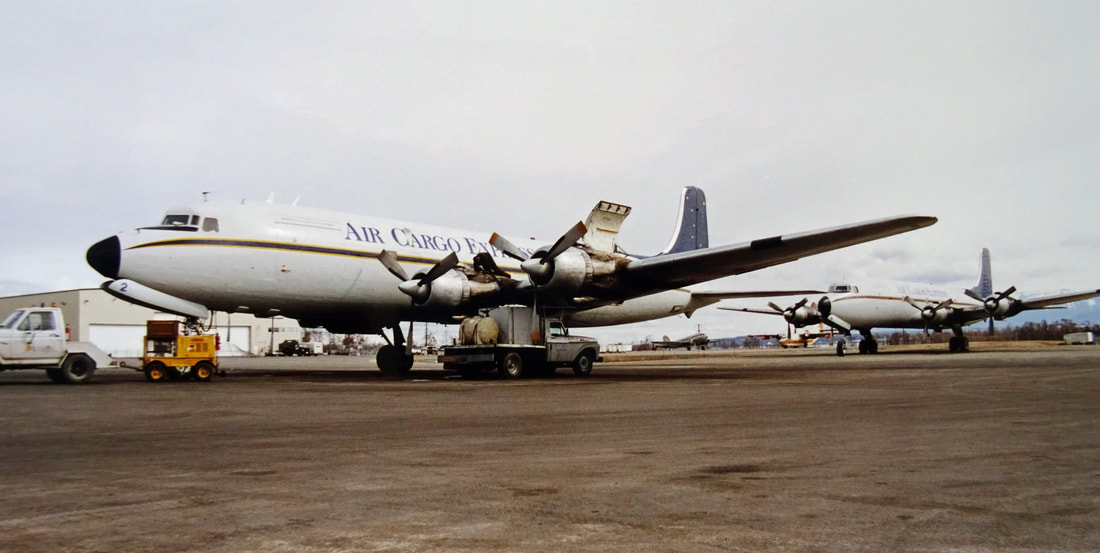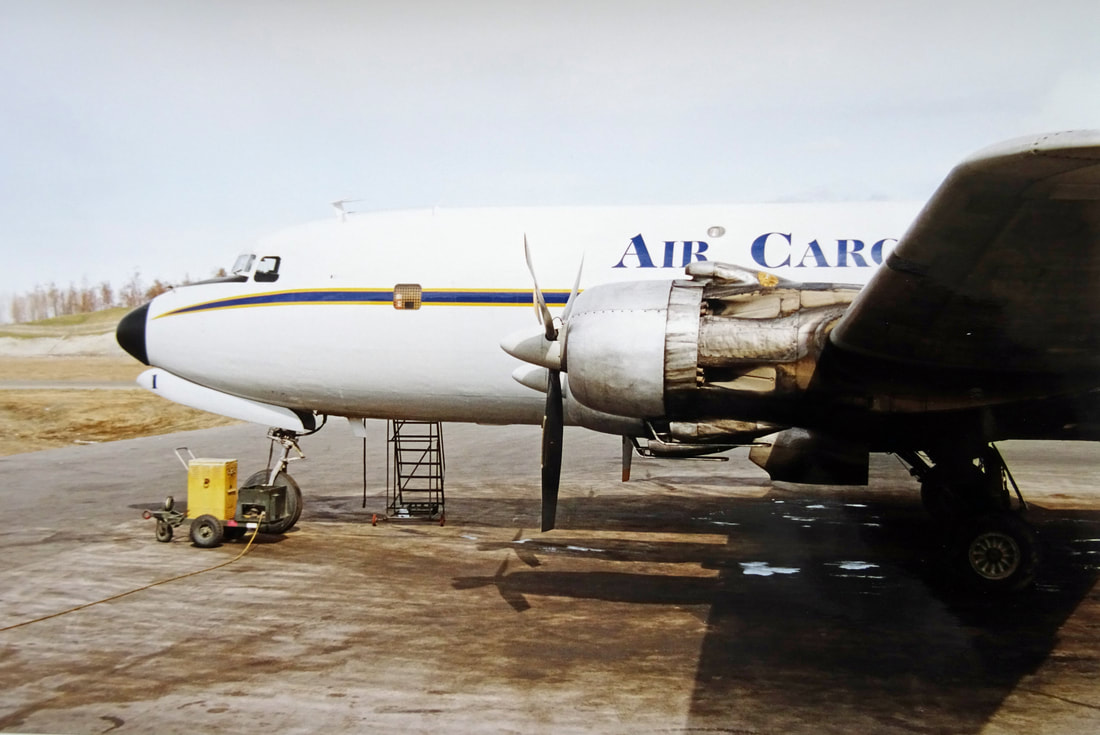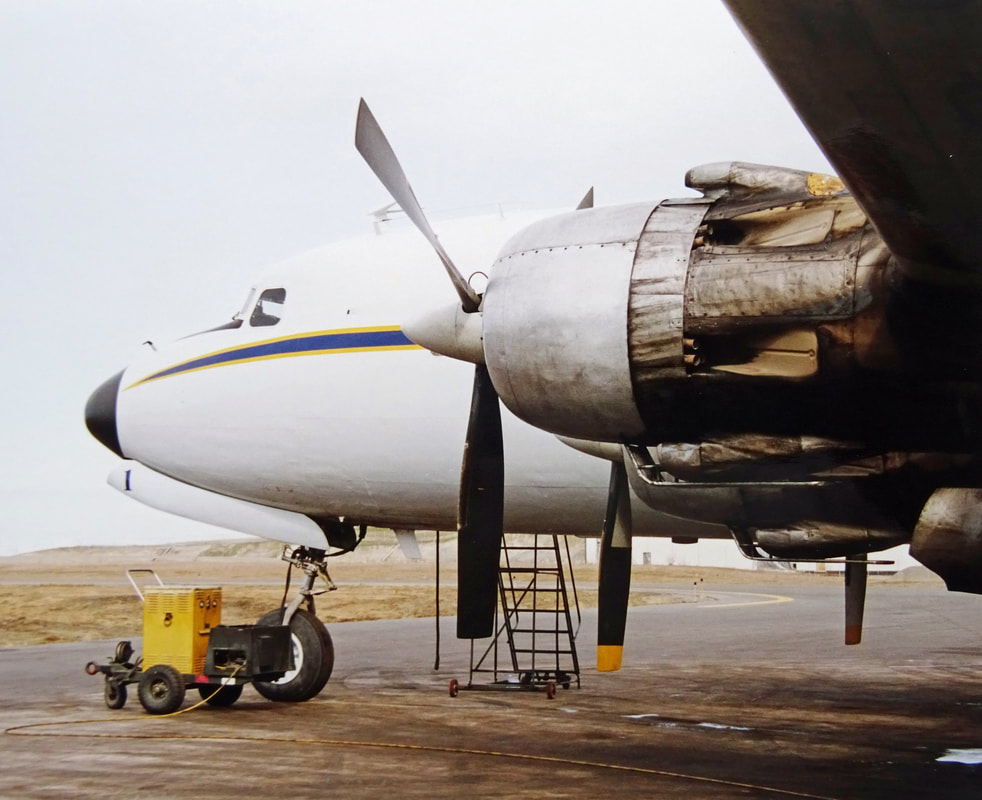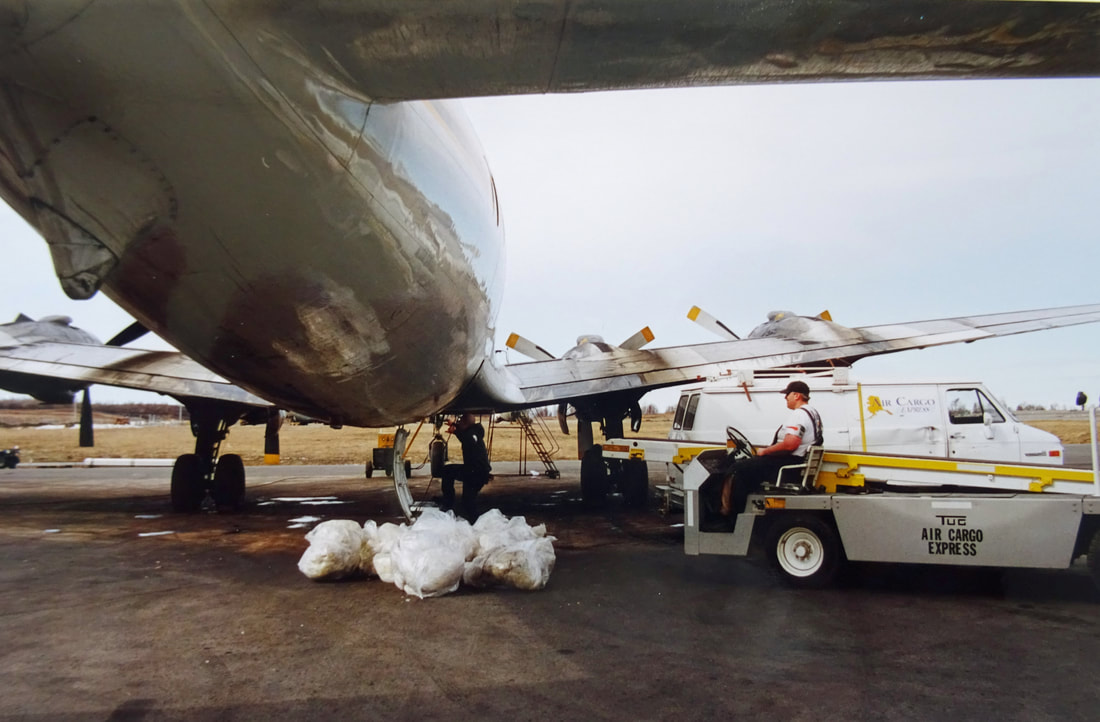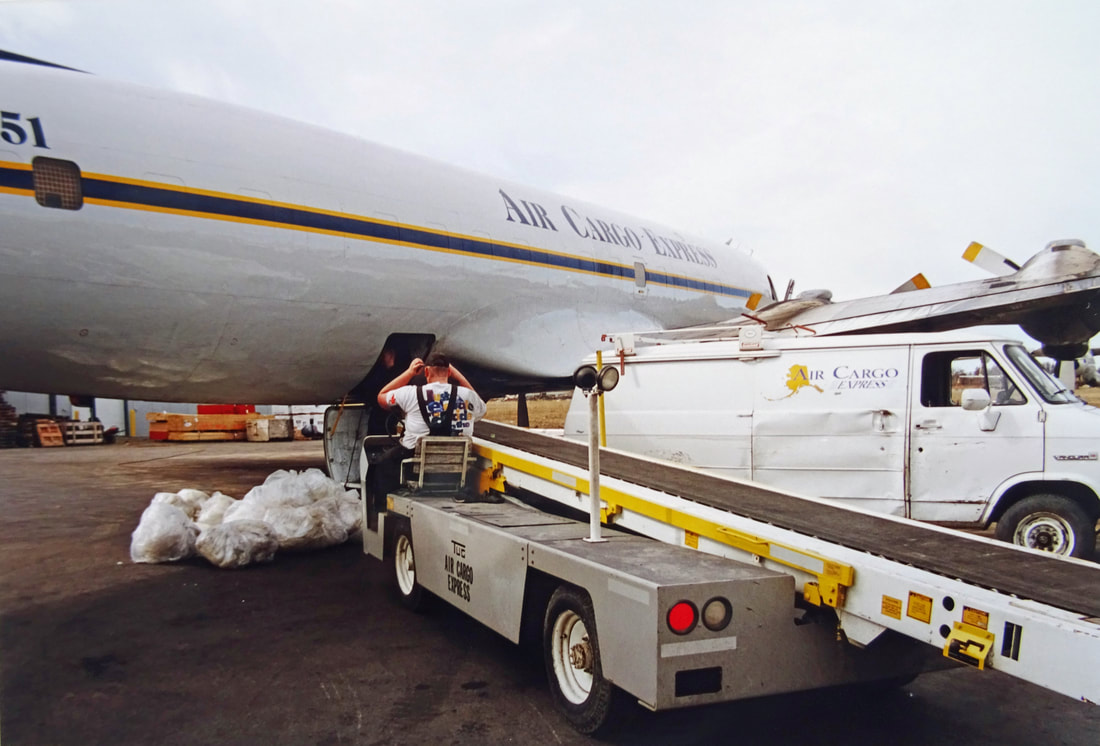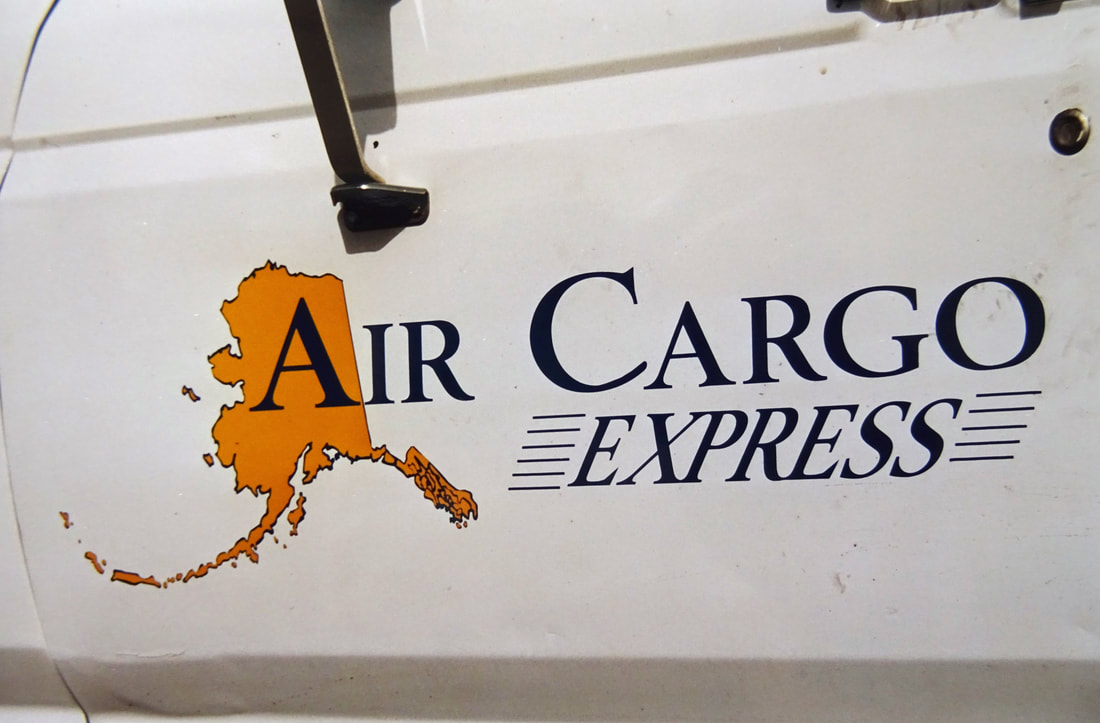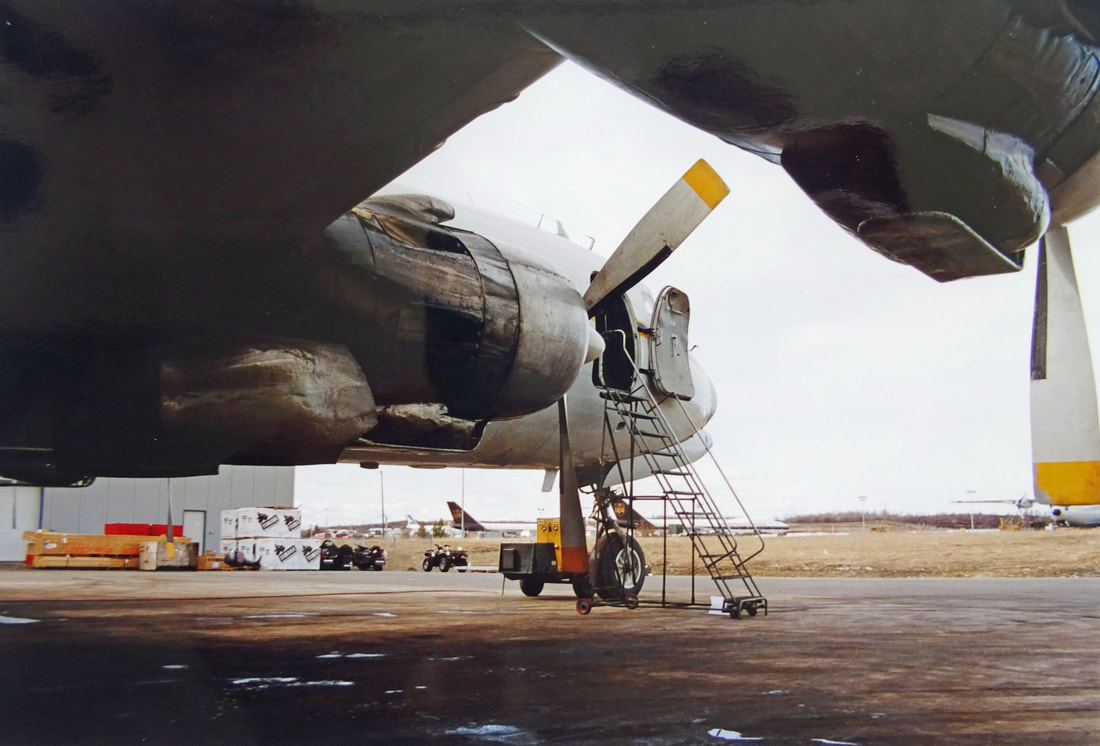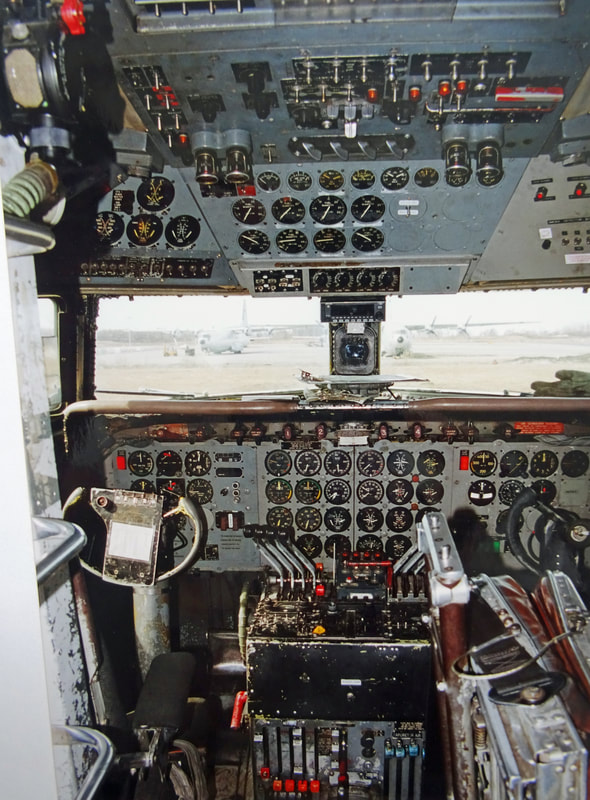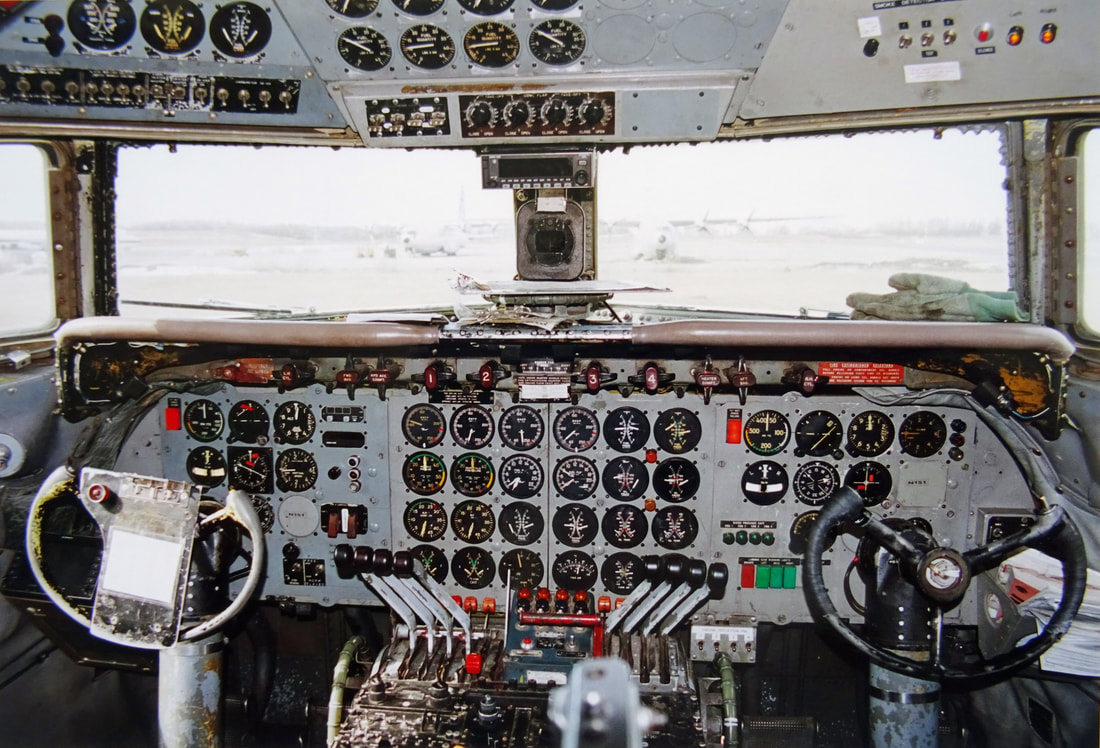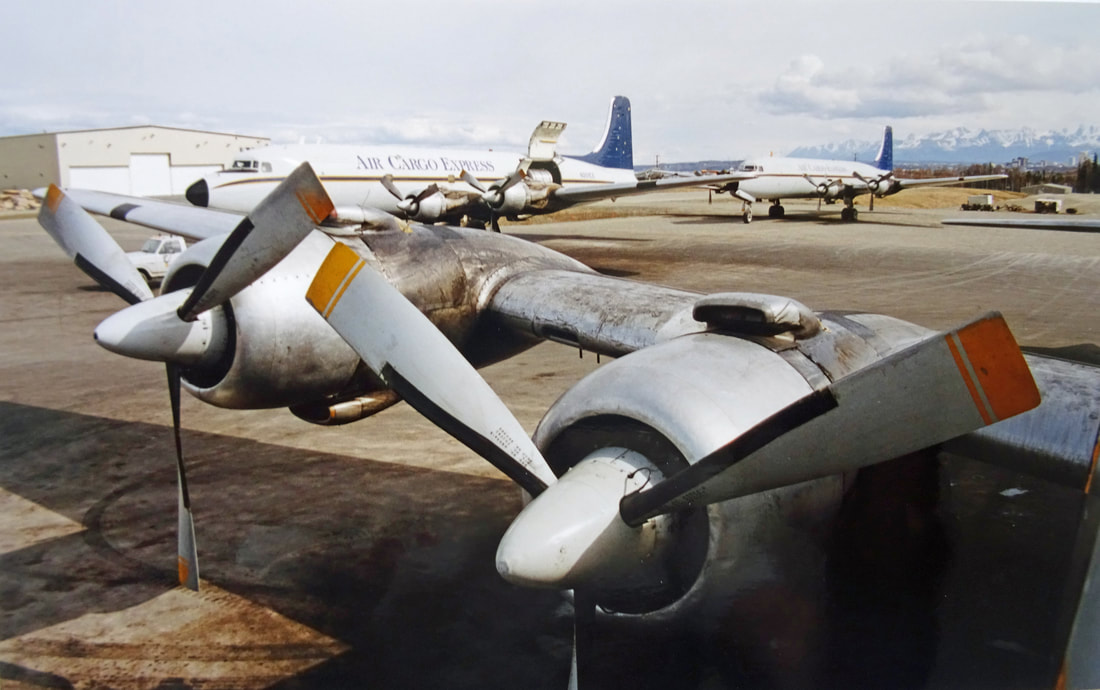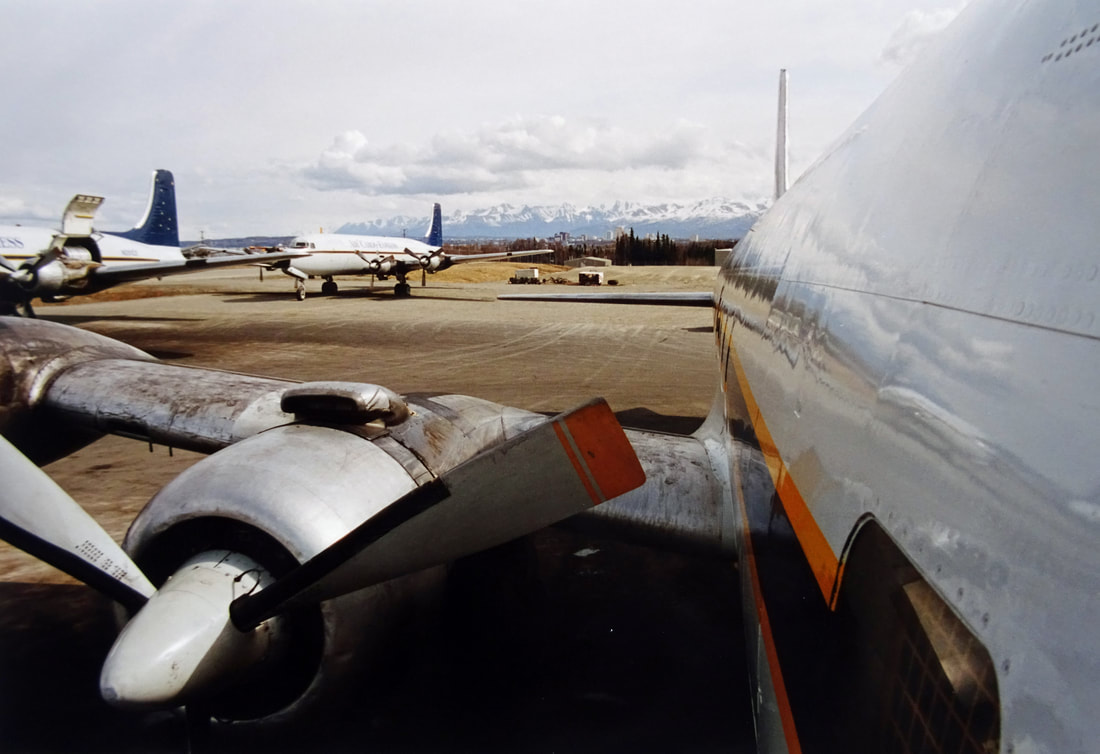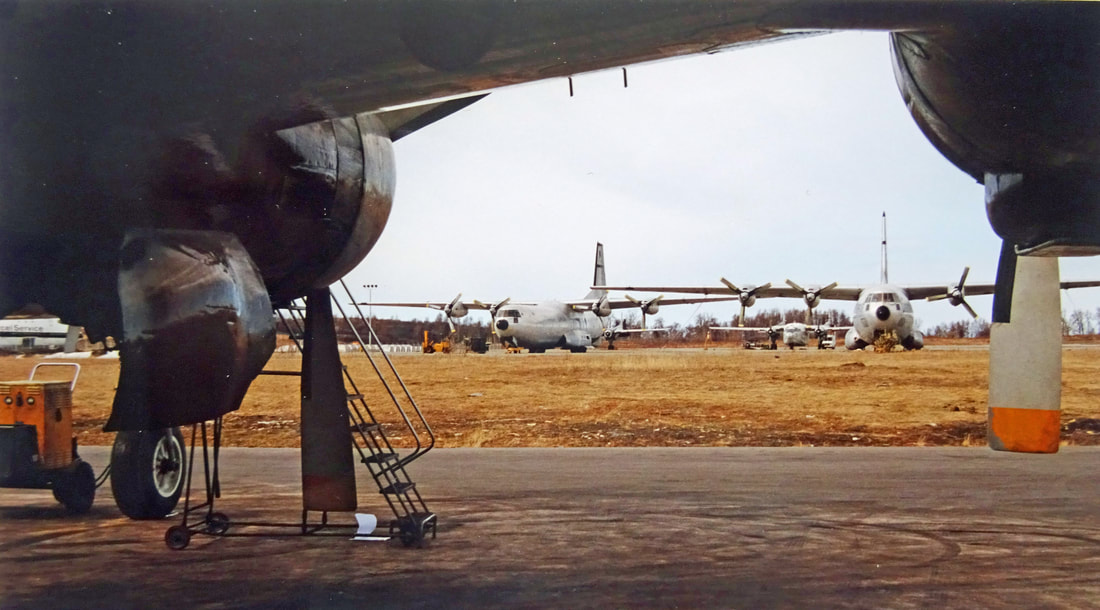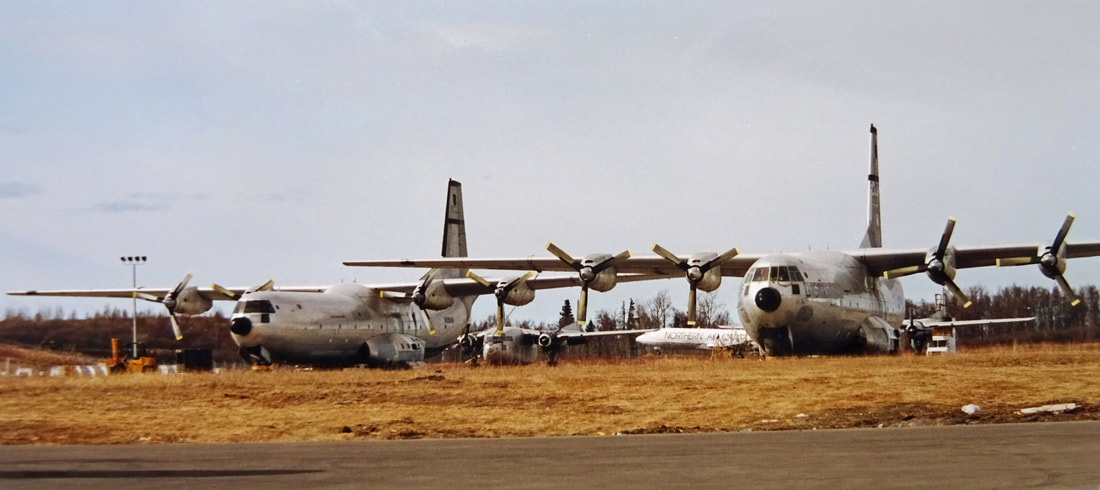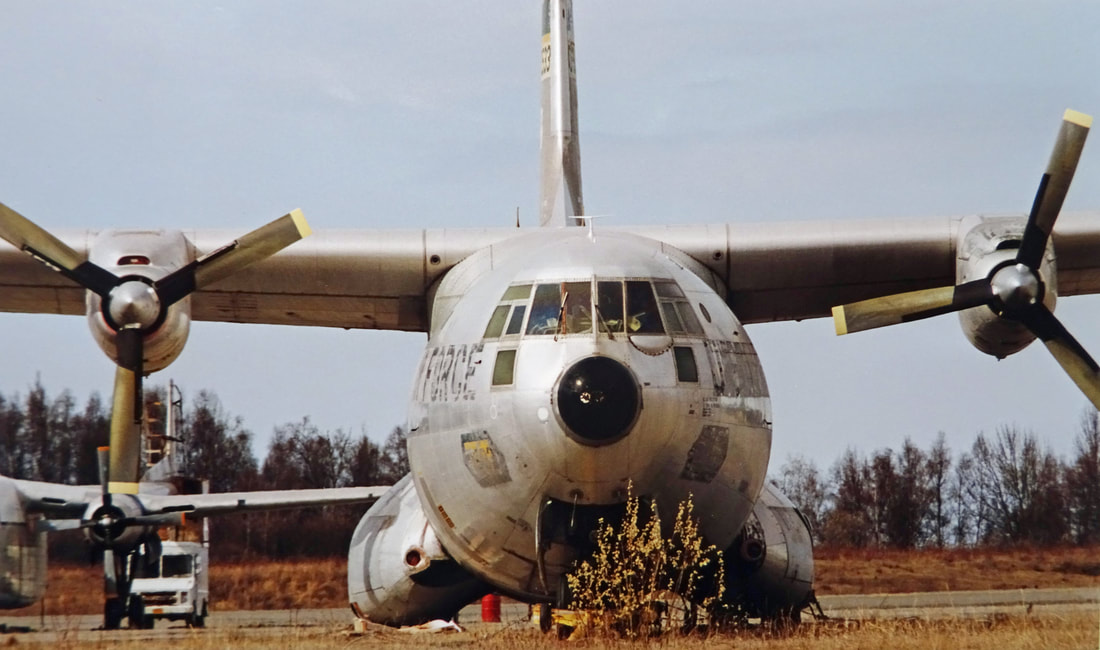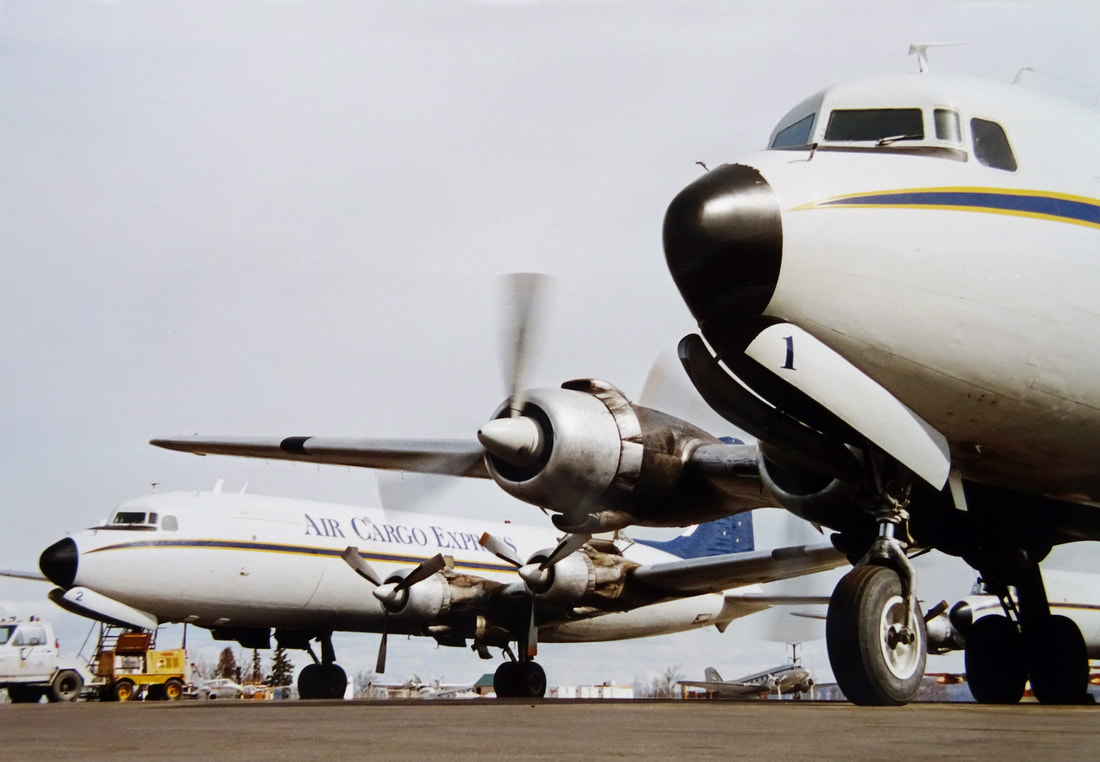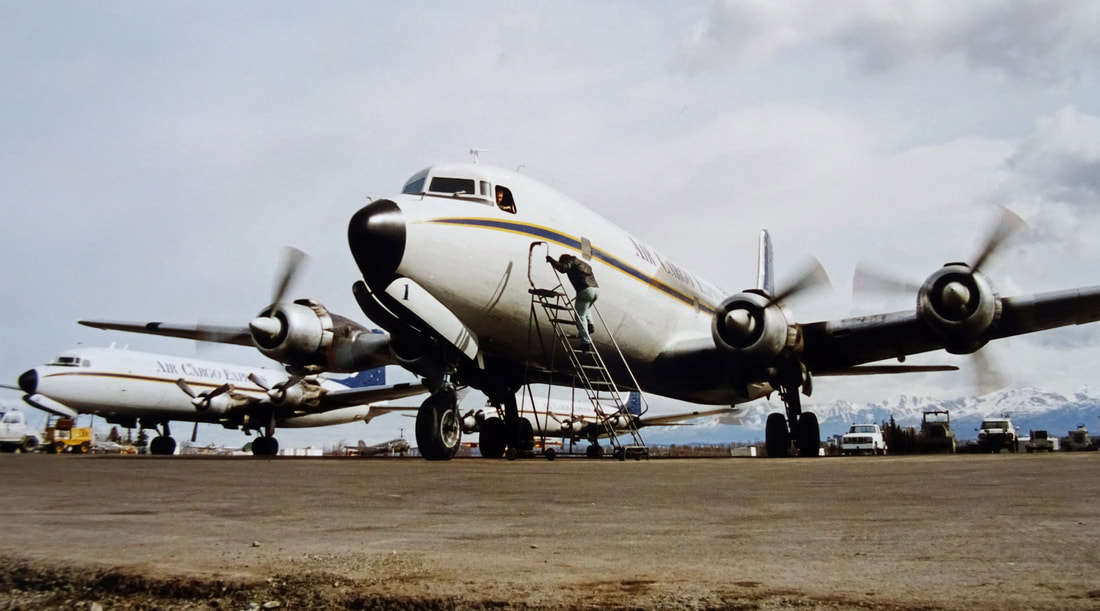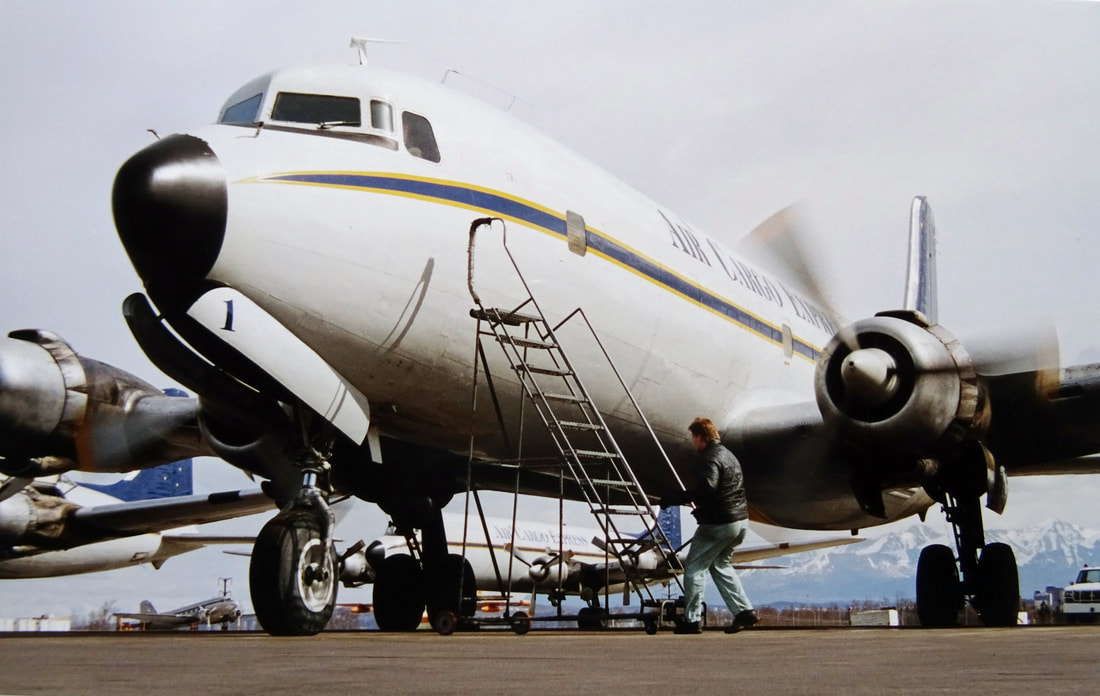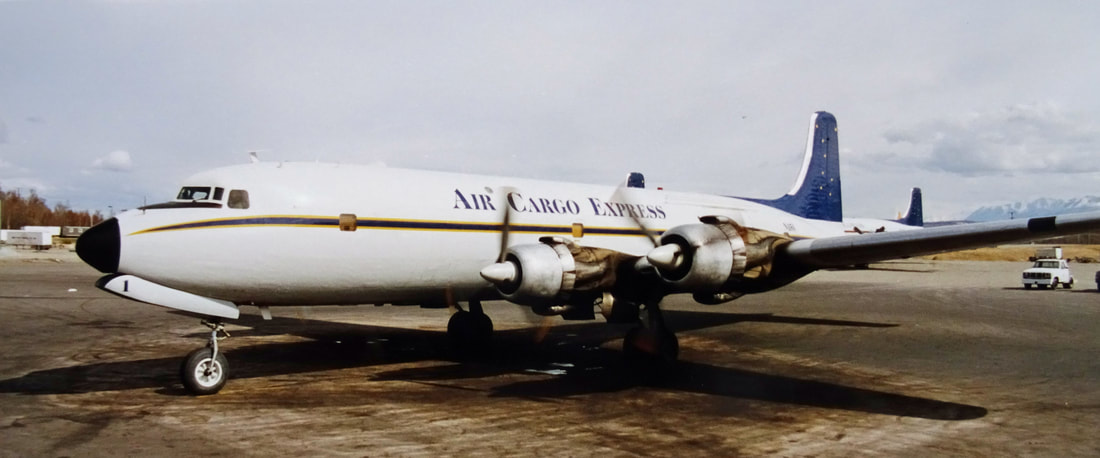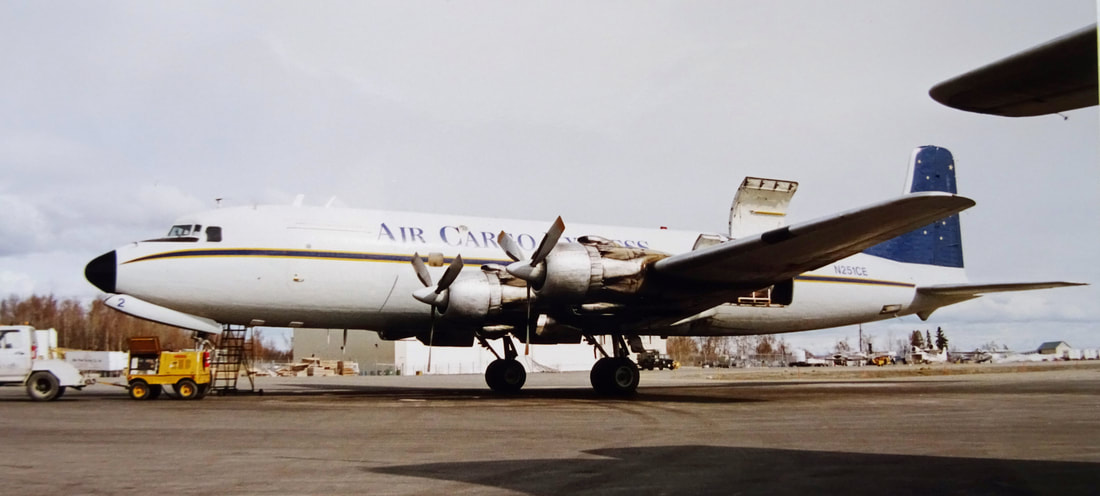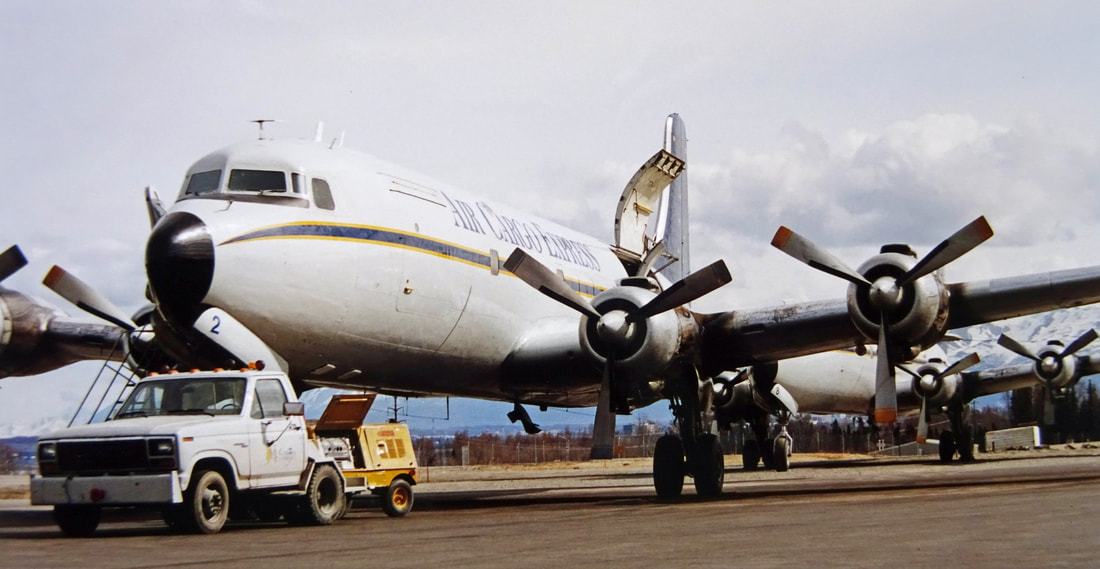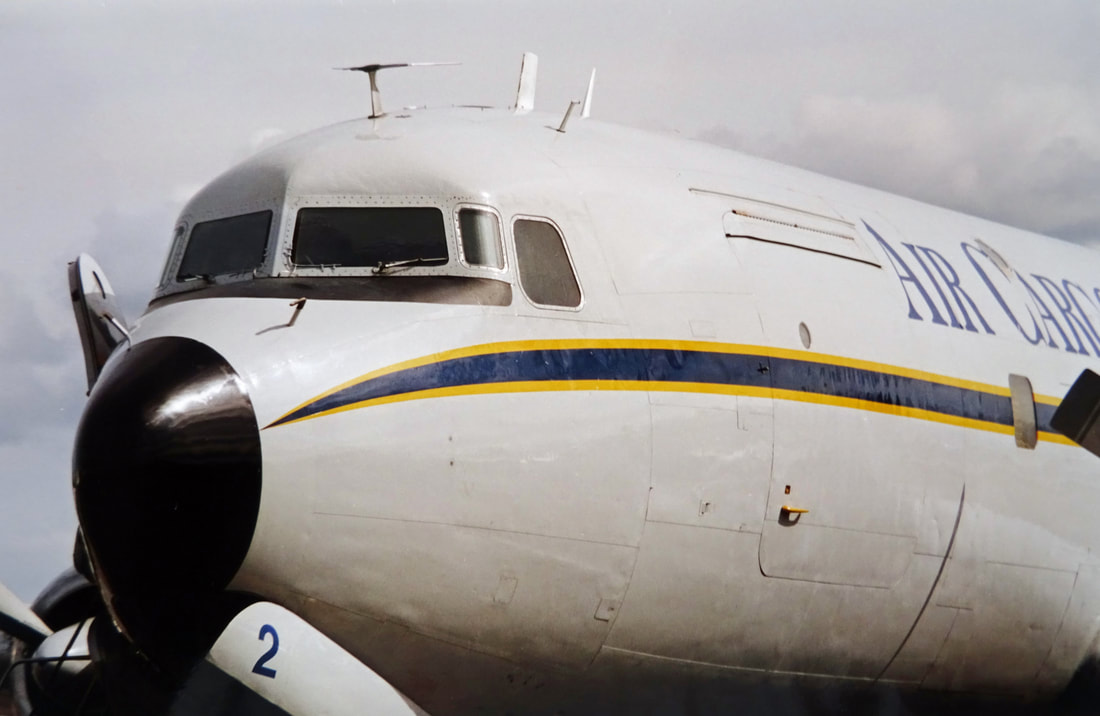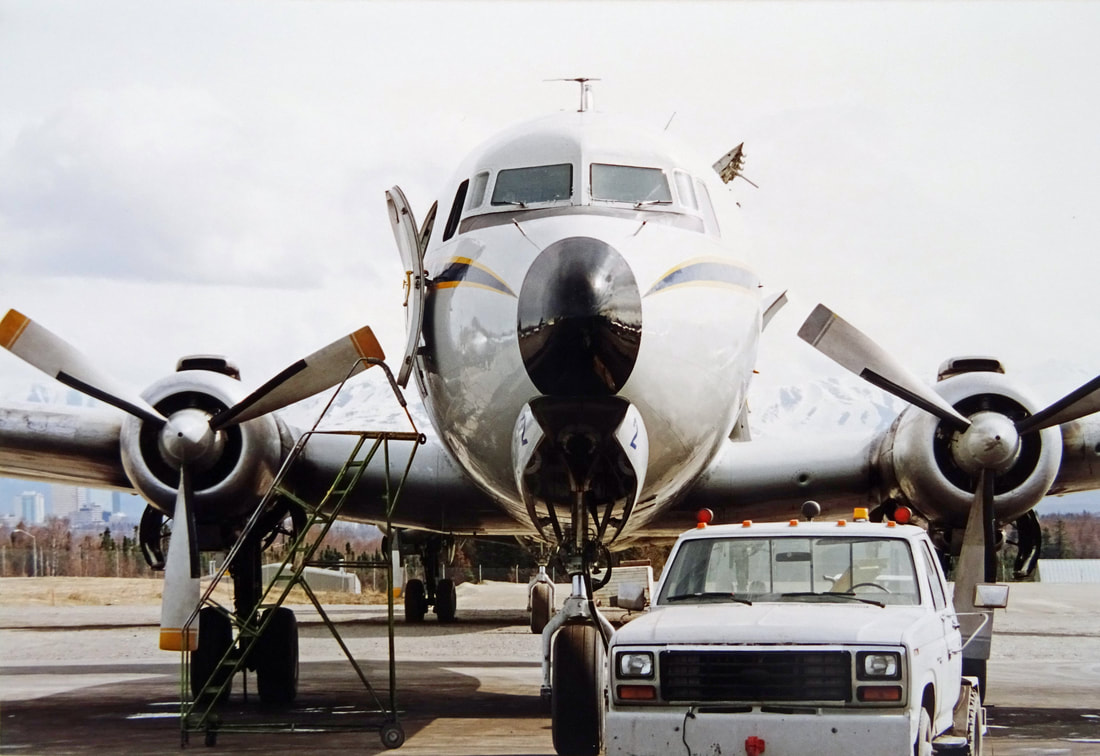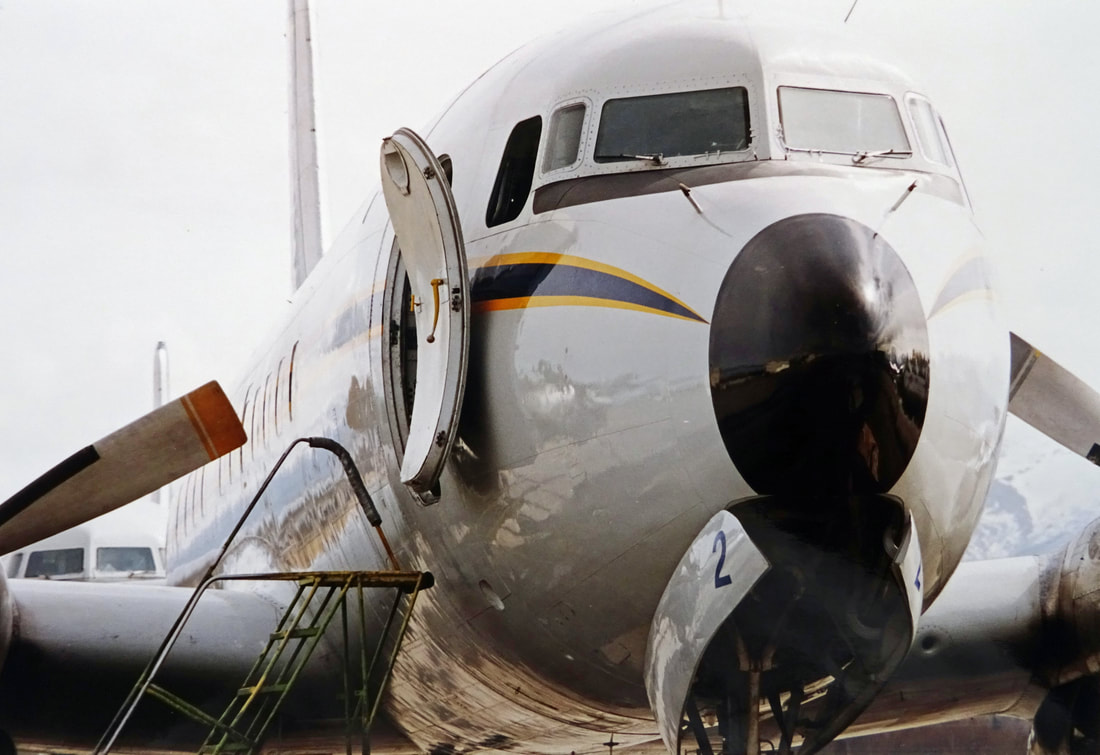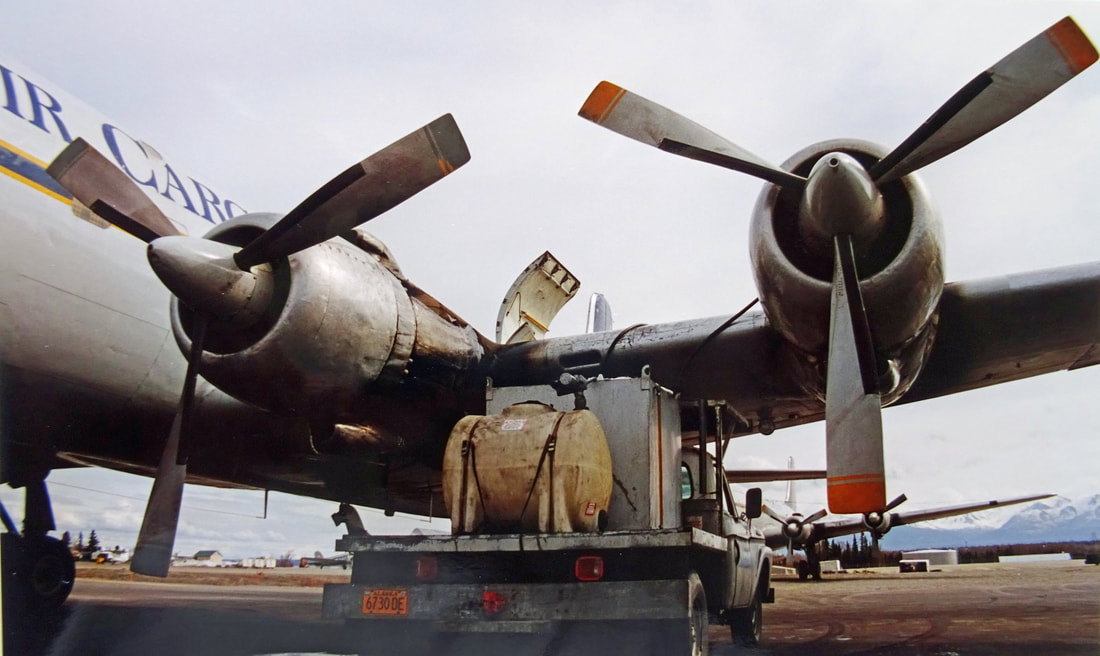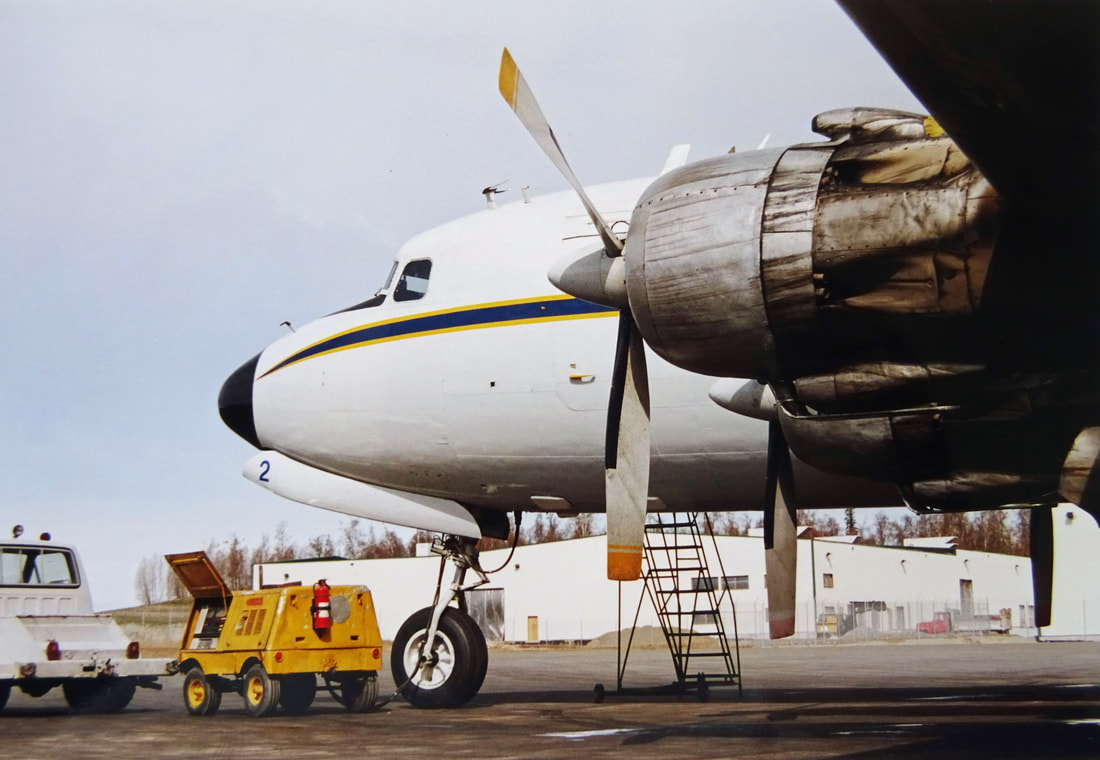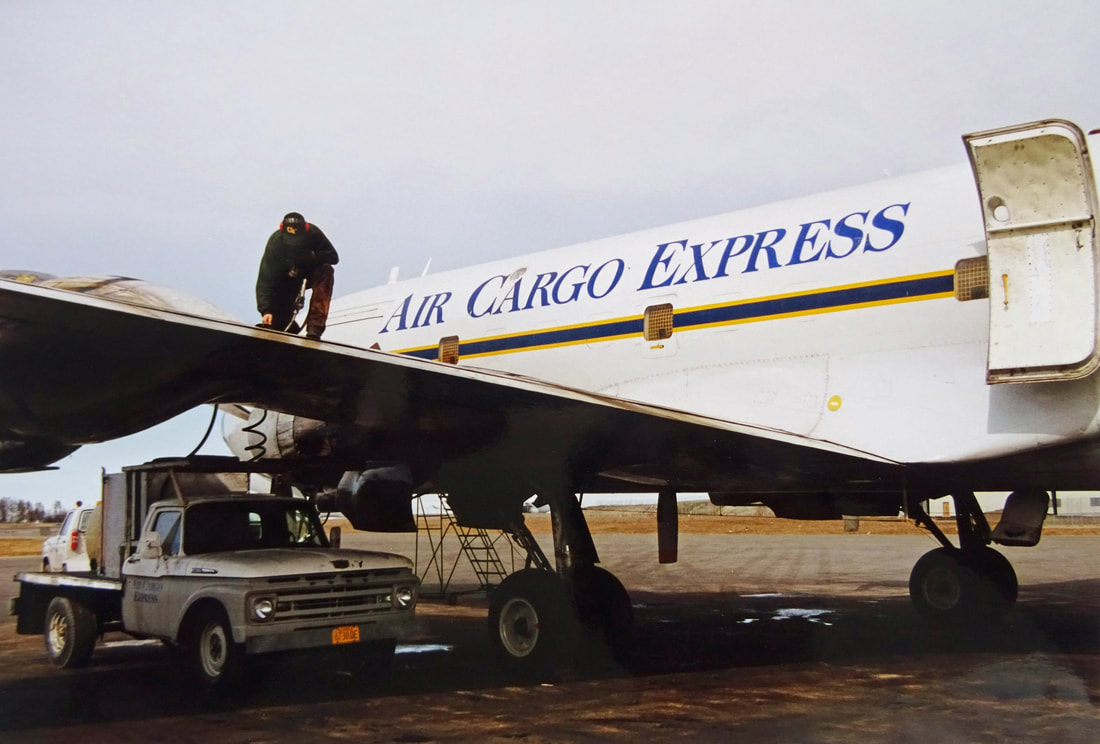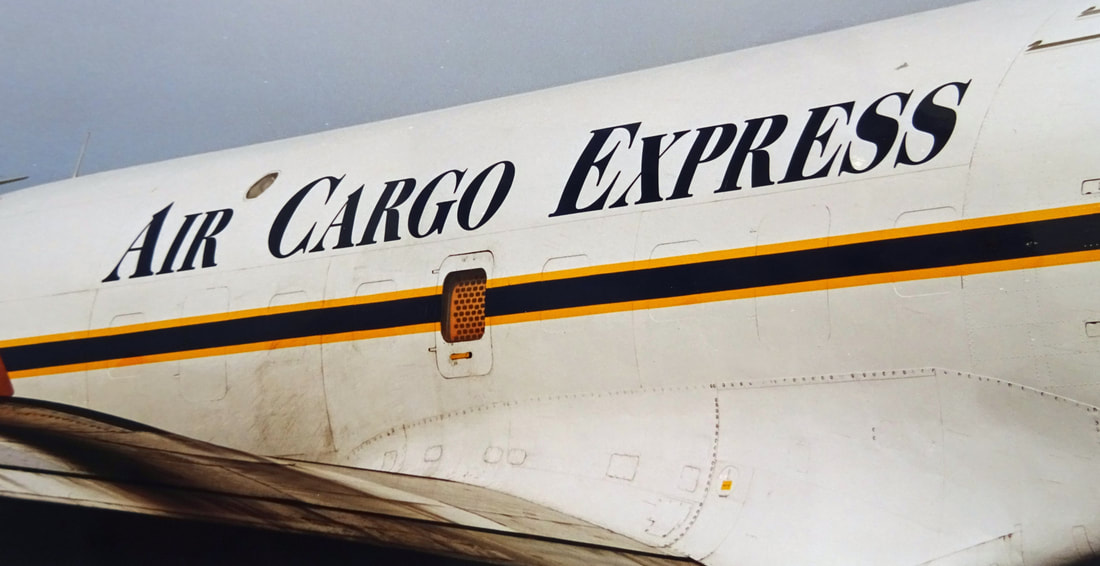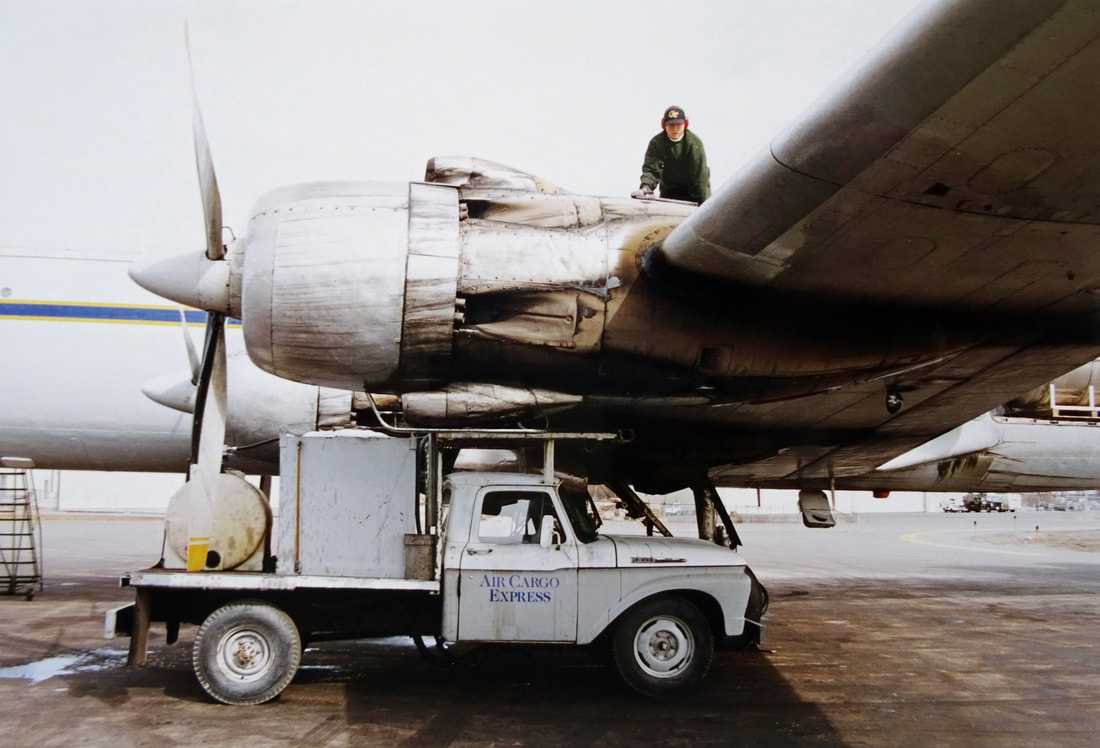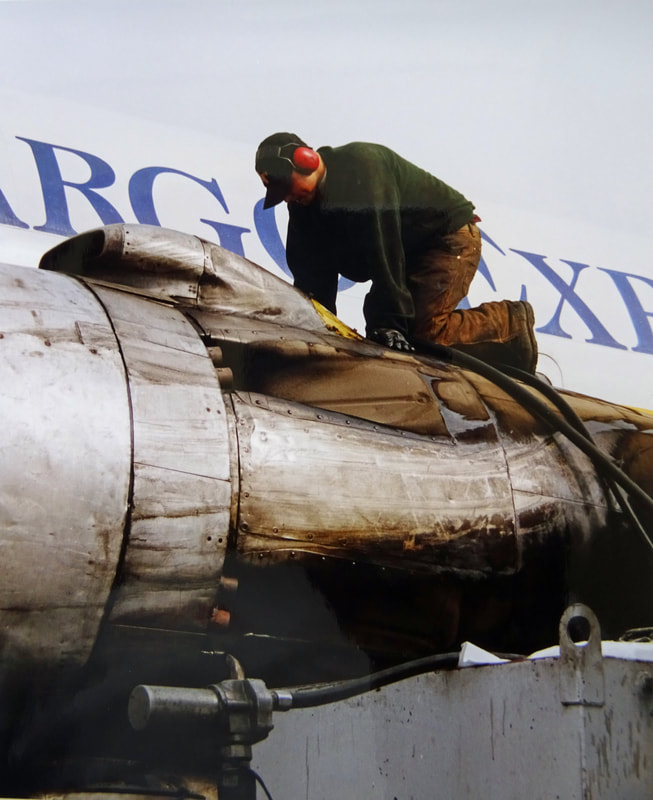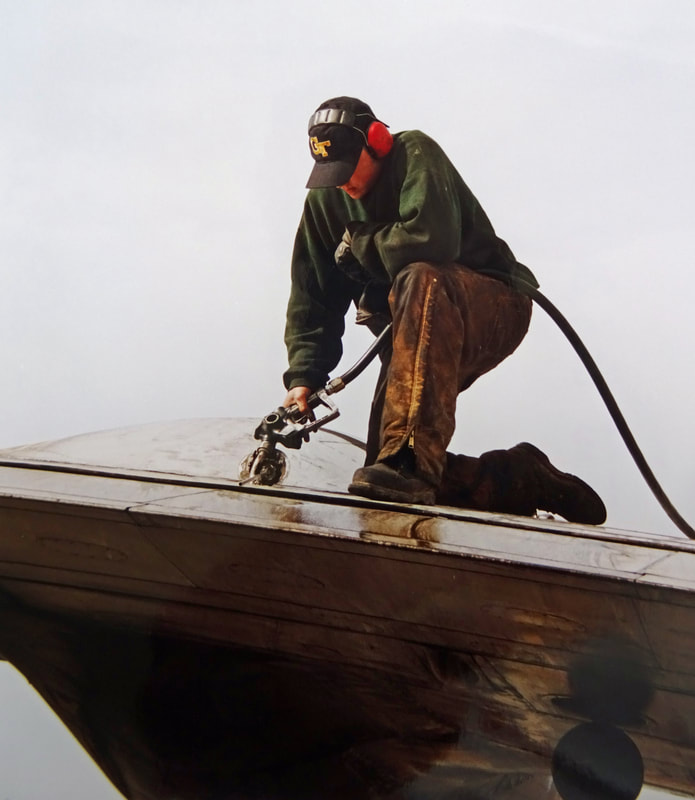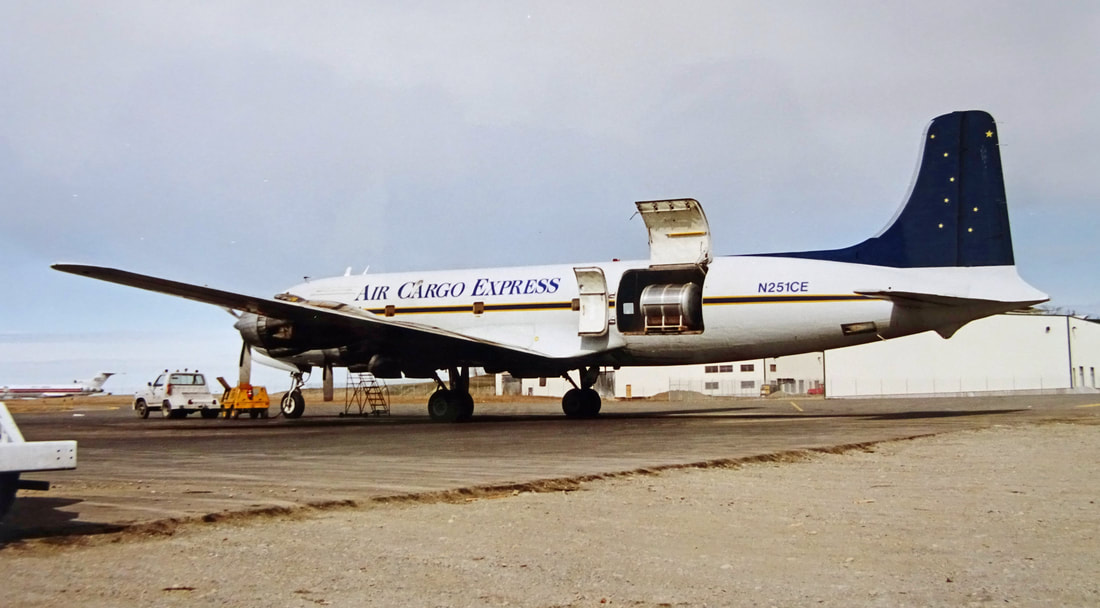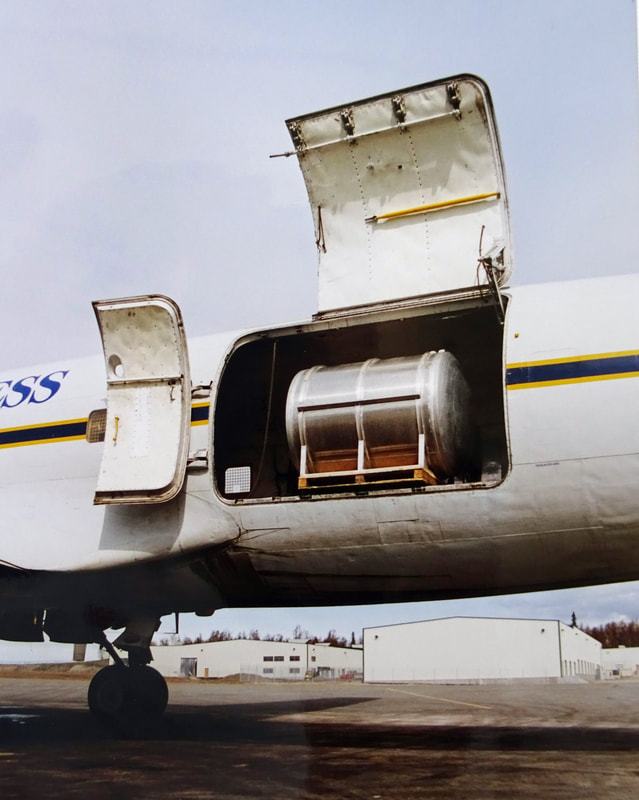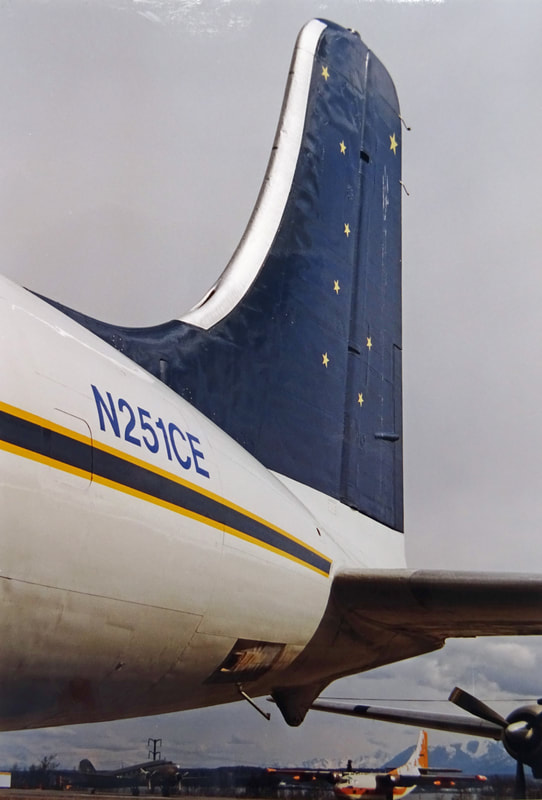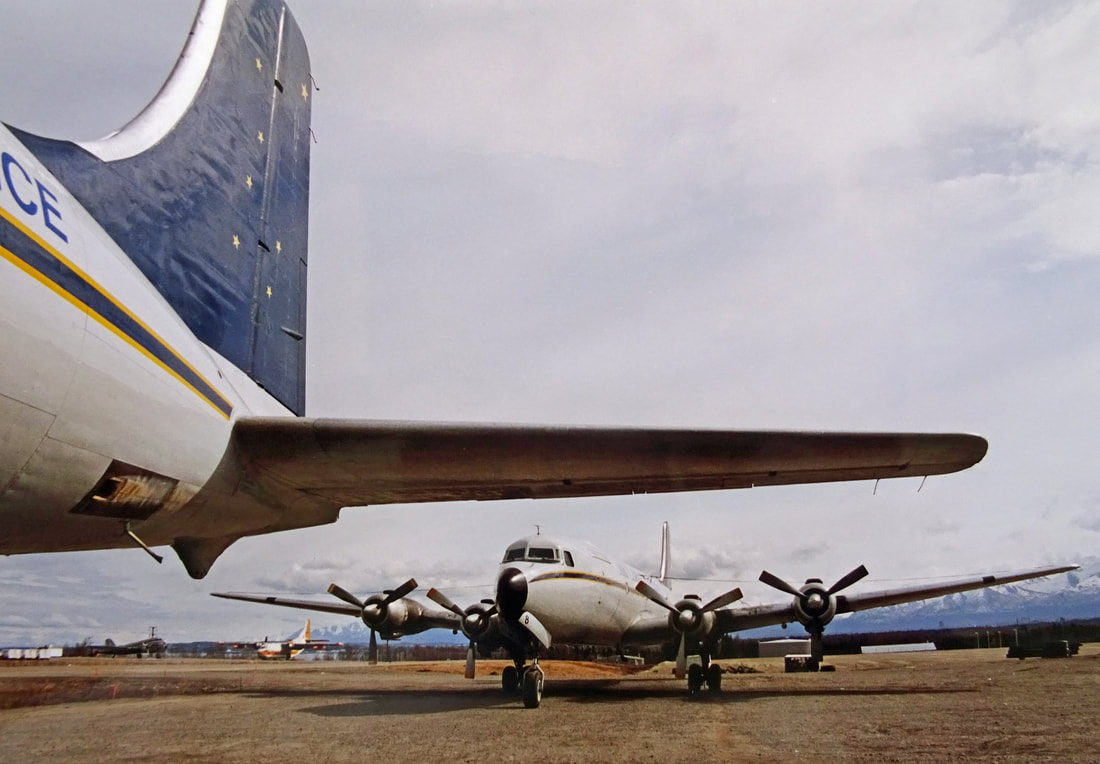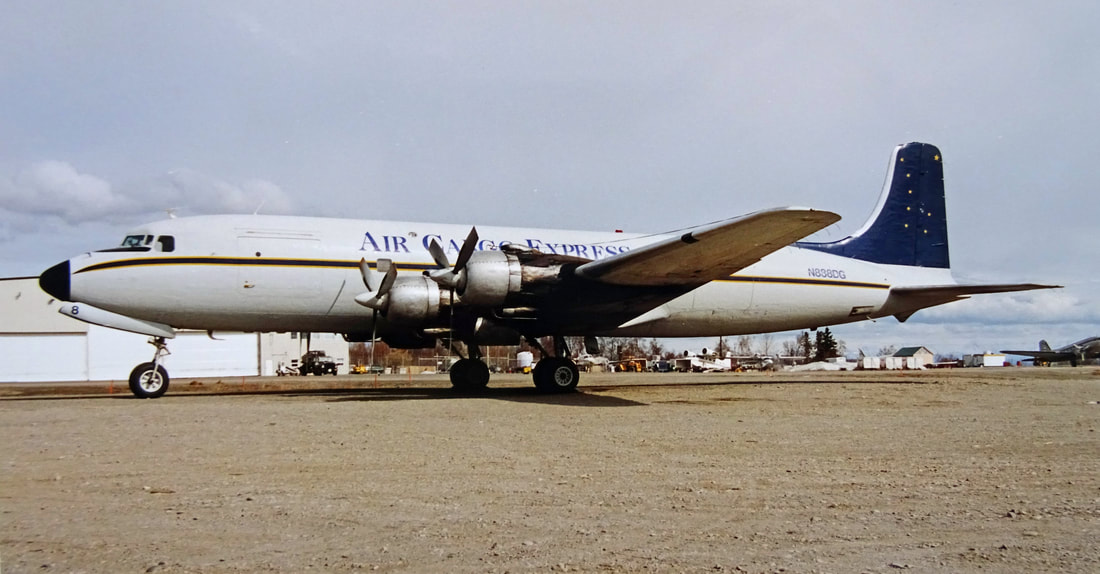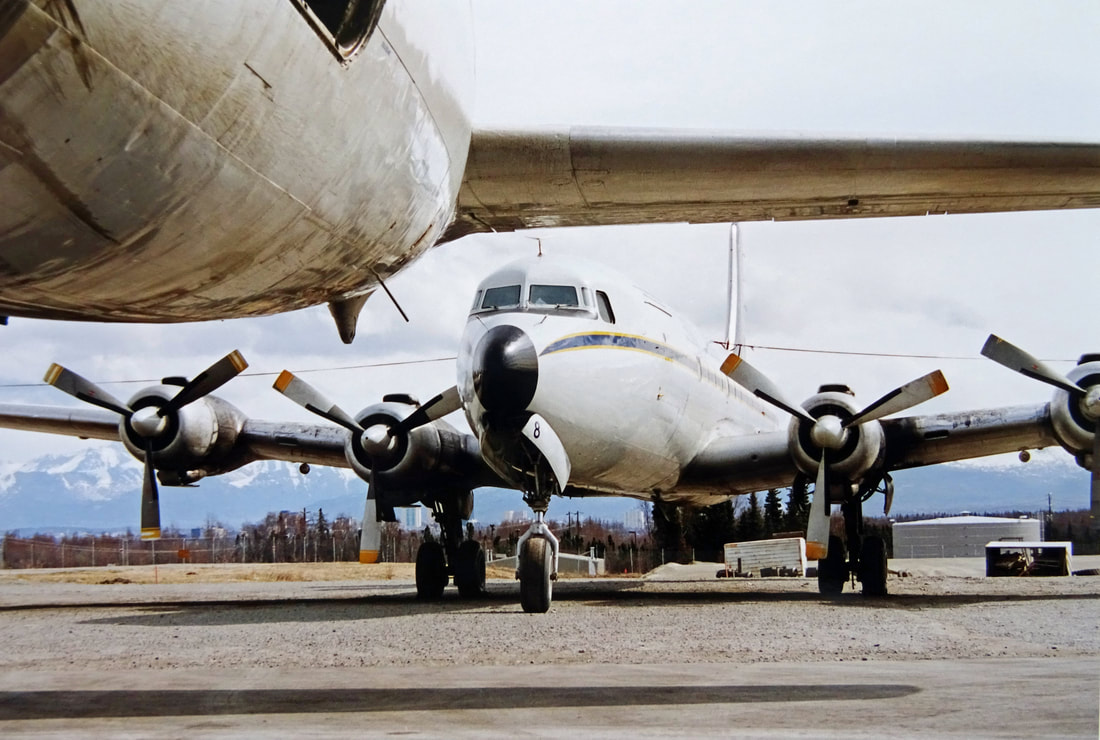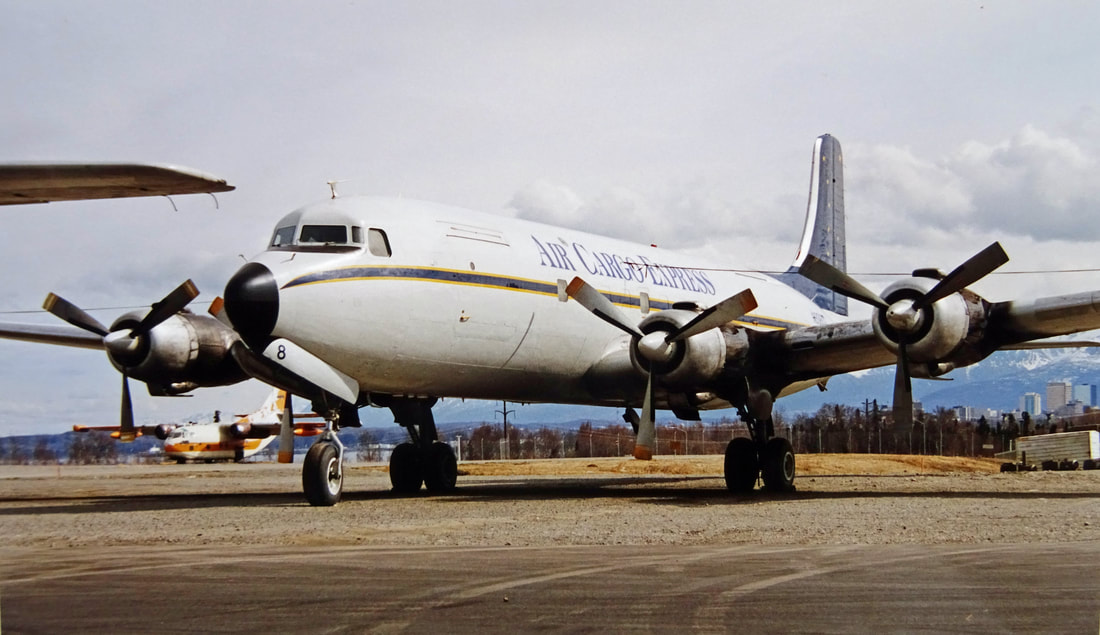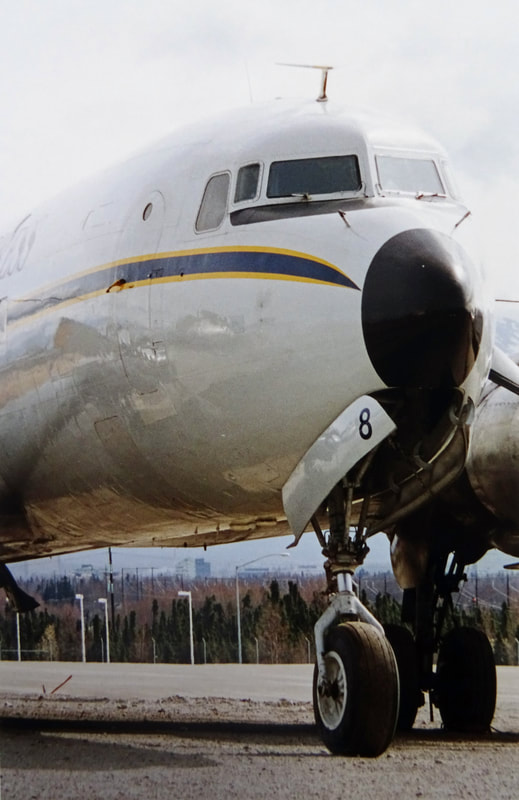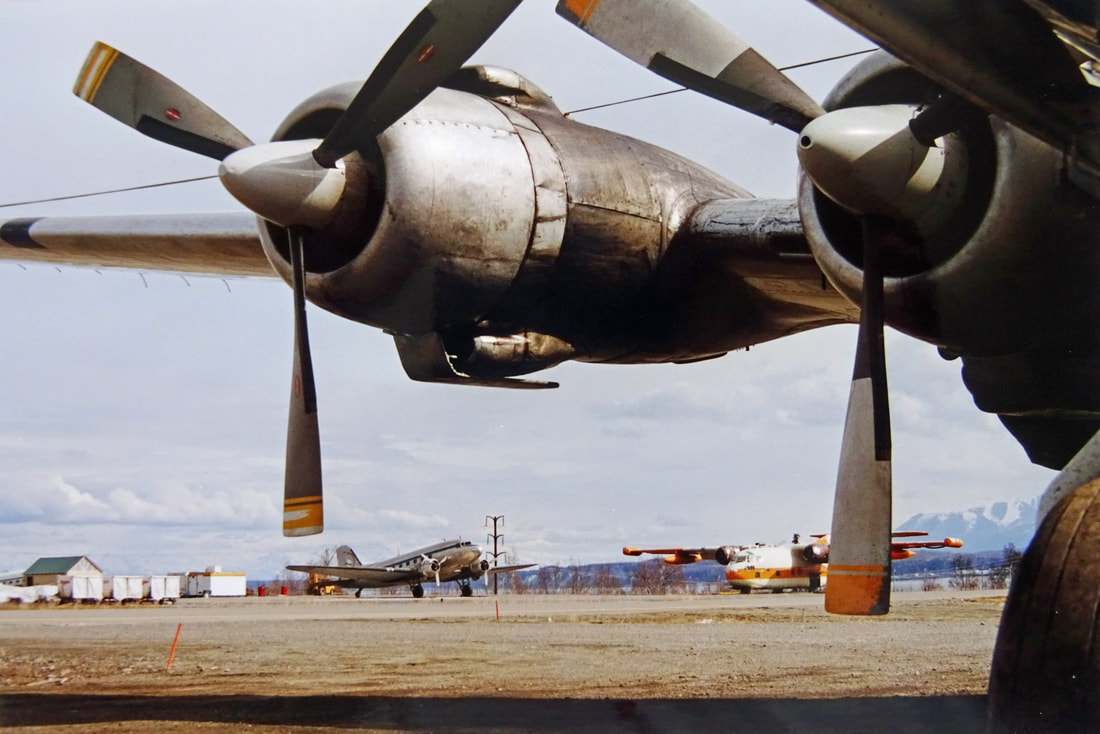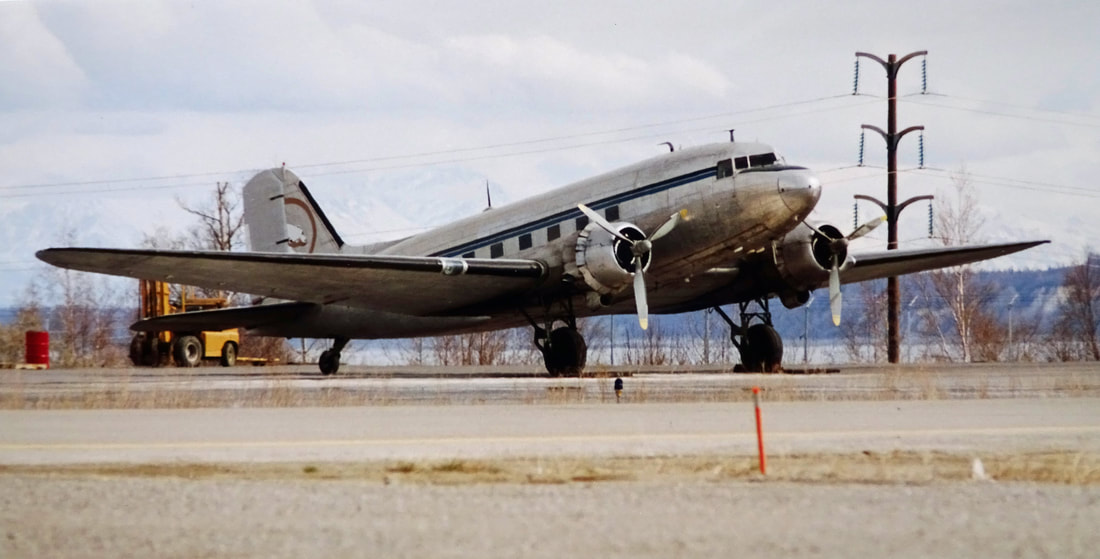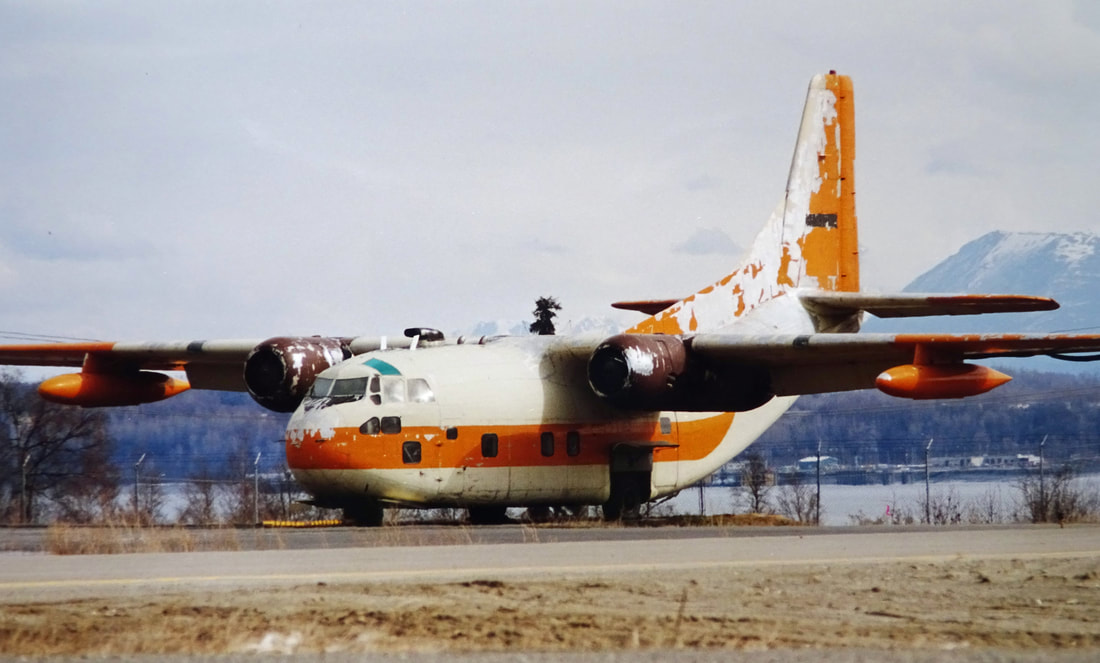Air Cargo Express & Everst Air Fuel
Fairbanks - Alaska - Anchorage
By Jan Koppen
When working for KLM Cargo, one is always surrounded by the modern screaming jets. Once a while, the need for some aviation nostalgia must be fulfilled. Nowadays, the choice is limited. Fortunately, Alaska is a land with still a good number of operational Big Props. In April 2000, I decided to visit this Greatland.
The pics are digital copies of paper photos, so quality low, but what does it matter? It goes about the experience!
The pics are digital copies of paper photos, so quality low, but what does it matter? It goes about the experience!
Everts unique Curtiss Wright of 1929 is based at Fairbanks since 1976.
Everts Air Cargo is an American Part 121 airline based in Fairbanks, Alaska, USA. It operates D.O.D, scheduled and charter airline cargo within Alaska, Canada, Mexico and continental US. Its Maintenance base is Fairbanks International Airport with its major cargo hub at Ted Stevens Anchorage International Airport.
Everts Air Cargo, established as Air Cargo Express, is the sister company of Everts Air Fuel, that specializes in fuel transport throughout the state of Alaska and into Canada.
Since Northern Air Cargo abandoned their regular service with the Douglas DC-6, Everts Air Cargo is the last airline in the USA to operate scheduled flights with a rather large fleet of 60-year-old piston-powered aircraft. The DC-6 is still considered to be a valuable aircraft for operations in the harsh conditions of Alaska, with excellent landing and takeoff performance on gravel runways. The downside is the difficulty to find Avgas and the maintenance labor cost. Everts Air Cargo estimates a ratio of 12 hours of maintenance for every single flying hour. Spare parts could also be a problem but Everts Air Cargo anticipates they will have enough in stock to keep the last DC-6 flying beyond 2020.
Everts Air Cargo, established as Air Cargo Express, is the sister company of Everts Air Fuel, that specializes in fuel transport throughout the state of Alaska and into Canada.
Since Northern Air Cargo abandoned their regular service with the Douglas DC-6, Everts Air Cargo is the last airline in the USA to operate scheduled flights with a rather large fleet of 60-year-old piston-powered aircraft. The DC-6 is still considered to be a valuable aircraft for operations in the harsh conditions of Alaska, with excellent landing and takeoff performance on gravel runways. The downside is the difficulty to find Avgas and the maintenance labor cost. Everts Air Cargo estimates a ratio of 12 hours of maintenance for every single flying hour. Spare parts could also be a problem but Everts Air Cargo anticipates they will have enough in stock to keep the last DC-6 flying beyond 2020.
The Curtiss Wright is powered by the Pratt & Whitney R-985. The same engine of the DHC-2.
Nose riding high, C-46 N54514 as seen here at Fairbanks is awaiting things to come.
N54514 looks to be in superb condition at the Air Cargo Express ramp at Fairbanks..
"Maid in Japan" artwork adorns the nose of Curtiss Commando N54514.
Perhaps the most glamarous of all Air Cargo Express nose art is that sported by C-46 N54514,
which carries a 'Can-Can' style lady named "Maid in Japan".
which carries a 'Can-Can' style lady named "Maid in Japan".
Maid in Japan takes a break between operations.
Mid-day sunshine glints off the polished fuselage of Curtiss Commando N54514.
Splendid Everts Air family portrait.
This bird was originally delivered at the end of the war to the US Army Air Force as "44-78565". In the years following it was operated by Slick Airways, Conner Air Lines, Wien Alaska Airlines, Reindeer Air Service, Kenn Borek Air, Lambair, Ilford Riverton, Northland Air Manitoba, before being acquired by Everst Air Fuel in September 1990.
Everts Air Fuel C-46F N1837M "Hot Stuff" undergoing maintenance on the company ramp on a cold morning.
Engineless and with paint fading, this forlorn Curtiss Commando is seen gleaming on Fairbanks apron on May 01, 2000.
Maintenance is carried out in the open as a matter of routine – hangarage is a luxury some of the Alaskan operators cannot afford or don’t need.
"Hot Stuff" receives mechanical attention in the open.
"Hot Stuff" undergoing maintenance at the Everts ramp.
Nicknamed "Hot Stuff", bare-metal C-46 N1837M operates as a tanker with Everts Air Fuel.
Cleared skin Curtiss Commando N1822M was delivered new to the USAAF as "44-78698".
Crisp spring sunshine glints off the aluminum underside of Everts Air Fuel Curtiss C-46 Commando "Salmon Ella".
"Salmon Ella" is sponsort by "7up".
Resplendent in its, natural metal finish, this broad-shouldered Commando is ready for duty.
A great looking brute, the Pratt & Whitney R-2800.
After retirement from the military, N1651M which was built in 1945, was sold on the civilian market. The airplane had an extensive career with later owners but finally was acquired by Everts Air Fuel in November 1998.
Looks like a museum ramp! - Crystal clear image on a gorgeous day in early May 2000.
Commando N1651M is seen here stored in a quiet corner of the Everts ramp.
N1651M is a very scruffy and weathered C-46.
"Tanker 45" saw service with Alitalia, Air Afrique, Delta Air Transport and Conair before she was bought by Everts for spare parts.
Former Trans Continental DC-6 N615SE was sold to Everts a few years ago.
N615SE provided yeoman service for many charter airlines in Europe.
Geriatric propliner hulks are a familiar sight around Fairbanks airport.
U.S. Navy C-118 N810CS ending her days in the Fairbanks graveyard.
The extensive spares department at the Everts Air Fuel's Fairbanks facility, which is situated in the former Wien Air Alaska hangar.
Being prepared at Fairbanks for her entry into service with Everts, is former Fairbanks Air Service C-46 N7848B.
A busy hangar scene inside the impressive Everts hangar at Fairbanks.
Meticulous maintenance keeps ‘em flying.
Former Trans Continental DC-6BF N6586C has spent many years in store at Willow Run.
DC-6 maintenance, Fairbanks, May 2000.
Starboard wing of the ex USAF C-118 N9148F in front of the stylish former Wien Air Alaska hangar.
Spare Pratt & Whitney R-2800 radial engine in-between two Liftmasters at the Everts ramp at Fairbanks.
A C-118 receives mechanical attention in the open and is in need of a fresh coat of paint!
Built in 1955, VC-118A N9148F is undergoing reconditioning at Everts maintenance.
VC-118 N9148F undergoes some form of maintenance.
N451CE of Air Cargo Express lounging in the sunshine at Fairbanks, waiting for another cargo.
This aircraft left the factory in 1955 for delivery to the U.S. Navy.
On August 01, 2019, Everts Air Cargo Flight 25, a Douglas C-118A Liftmaster, N451CE, met her untimely end when she was substantially damaged when it struck a berm and damaged the landing gear while inbound to land in Candle, Alaska. There were no injures to the three crew members onboard.
According to the captain, after overflying AK75 they entered the traffic pattern to land on runway 20. He stated that the approach was steeper than normal due to terrain; however, the sight picture indicated touchdown near the threshold of the 3,880 ft runway. A bump was felt near the threshold during the landing but was not extreme. The airplane's propellers were then put into reverse and the airplane veered to the right. The flight engineer applied asymmetric reverse, in an effort, to correct for the right turning tendency and the airplane tracked straight for about 2,000 ft. before it veered sharply to the right, exited the runway and spun 180. The airplane sustained substantial damage to the fuselage. An inspection of the threshold of runway 20 revealed several 4 ft tall piles of rocks and dirt.
According to the captain, after overflying AK75 they entered the traffic pattern to land on runway 20. He stated that the approach was steeper than normal due to terrain; however, the sight picture indicated touchdown near the threshold of the 3,880 ft runway. A bump was felt near the threshold during the landing but was not extreme. The airplane's propellers were then put into reverse and the airplane veered to the right. The flight engineer applied asymmetric reverse, in an effort, to correct for the right turning tendency and the airplane tracked straight for about 2,000 ft. before it veered sharply to the right, exited the runway and spun 180. The airplane sustained substantial damage to the fuselage. An inspection of the threshold of runway 20 revealed several 4 ft tall piles of rocks and dirt.
Everst Air Fuel DC-6A N451CE minutes before she fired-up her R-2800 radials for an one hour testflight.
C-118 N451CE looks to be in superb condition.
Billboard titles.
Let me stick my head into the cockpit for a quick look.
The front office of N451CE, but can a photograph communicate the feel of this wonderful machine?
The classic lines of the Big ‘Dougs' are so evident in this full quarter frontal.
May 01, 2000 was a rather overcast day at Fairbanks airport.
Air Cargo Express DC-6A N351CE is still wearing her former Everts cheatline. Fairbanks, May 02, 2000.
Those massive R-2800's take a break between operations.
Mid-day sunshine glints off the aluminum cowling of this Air Cargo Express DC-6.
An ACE mechanic tops-up the engine oil level of the massive no.2 Pratt & Whitney engine.
In preparation of her early morning departure up north to Point Barrow and Deadhorse, mechanics tops-up N351CE in the late afternoon of May 01, 2000.
The Pratt & Whitney R-2800 is a Big engine!
The propeller has lift on one side and drag at the other. At the tip "induced drag" is created, which means that lift and drag meet and balance out. This create tip vortices, which are accountable for most noise. When compared, rounded tips create less induced drag than square tips and thus less noise.
Adding oil to number 4.
This stunning photograph help capture the essence of the lost age of the big propliners.
Fatigue and corrosion problems are constant enemies of classic propliners.
The inner-port engine of this DC-6 comes under scrutiny during a turnround check.
The flight crew office of ACE N351CE.
Room with a view!
Even in 2000 the number of active DC-6's were rapidly dwindling.
The flowing lines of the hull add grace to a superbly executed design.
One-time fire-bomber with Macavia, DC-6B N555SQ is sitting pretty at the Everst ramp on a crisp day in early May 2000.
In the year 2000 an healthy number of DC-6's were in airline service and the majority flew in Alaska.
DC-6BF N555SQ fires-up her Pratt & Whitney R-2800 radial engines in classic style.
N555SQ under power at the company's Fairbanks ramp.
Everts Air Fuel propliner graveyard.
Next to Fairbanks Airways, Curtiss N4860V flew for Alaskan Interior Airways.
Soft spring light warms this classic propliner at the Fairbanks.
CF-NAU/N801FA once flew for operators like Nordair and Fairbanks Airways.
These old C-46's were used for spares to keep Everts Air Fuels Curtiss Commando fleet in the air. Featured is an ex Japan Defence Force C-46.
The low angled light of the April afternoon, highlights the jet booster pod of Fairchild C-119 Flying Boxcar, N8504Z.
|
N8504Z is a long-term resident of Everts Air Cargo ramp at Fairbanks.
It is not hard to imagine why this strange aircraft is called the Flying Boxcar once you see one in real life. This one rests peacefully at Everts. On the roof you can see the Jet pod modification. A Westinghouse J34-WE-36 jet engine for improvement of short-start capability. |
Convair C-131 N9767Y gleaming in the sun on a weekday, at the end of April 2000.
This Convair C-131F had been in store at AMARC during the 80's.
"Samaritan 005" was build in 1955.
DC-6, N666SQ/47, stands illuminated under a rain laden sky.
The DC-6 has flaps with the size of barndoors!
N666SQ has been in service with Macavia, T&G Aviation, Sis-Q and United Airlines, before she was withdrawn from use and set aside in this Fairbanks graveyard.
Macavia's Tanker 51 (N999SQ) has been a former Swissair Airlines flagship.
DC-6A N12347 once wore the uniform of Northwest Orient Airlines.
Former Securite Civile DC-6B, Tanker 62 (N4390X), ending her days at Fairbanks airport, stripped off her precious Pratt & Whitneys and various other components.
DC-6BF N28CA was photographed at Palmer, Alaska, in April 2000. The next year she was ferried to Fairbanks to be used for spares by Everts.
Another propliner at Fairbanks was this Grumman Tracker C1-A, registrated N27PH and owned by James P. Haggland.
N59314 of Frontier Flying Service was delivered to the USAAF in January 1944 and transferred to RAF Montreal as KG354 the next month. It made the crossing to the UK in March where it served with 512 and 437 squadrons. On June 17th 1946 it was registered to the Canadian Government, which transferred it to the Royal Canadian Air Force later that year. In the mid 70's she was struck off strengt and stored at Saskatoon. It entered the Canadian Civil Aviation Register as C-GABE, but only to be sold to Basler Flight Services in May 1978 and reregistered as N59314. Frontier Flying Service bought it that very same year and it was registered to J.L. Dodson (Trustee) in Fairbanks, Alaska. In 1982 it was registered to J. Hajdukovich of Fairbanks and leased back to Frontier. Its career with Frontier was thus concluded by the end of 2000 and found a new start with Abbe Air Cargo at Palmer, Alaska.
Everts Air Cargo major cargo hub is at Ted Stevens Anchorage International Airport, which I paid a visit before and after my visit to Fairbanks.
The Air Cargo Express ramp at ANC.
Some seriously fascinating stuff there.
Blades with rectangular tips are more efficient because they have more blade area. This is why, the rectangular blade tips or rectangular blades are more noisy. Round or oval blade tips have less blade area and less air is affected by the blade. The effect of air passing through the blade, if more air passes, will produce more air effect and consequently more noise. If less air passes, there's less air effect and less noise is produced.
Crystal clear image on a gorgeous day in April 2000.
Unfortunately, the hallmarks captured so well by the lens, also spelled the doom of these geriatric propliners.
Loading of Bethel bound cargo aboard the ACE DC-6A N151 at Anchorage in April 2000.
Loading-up Air Cargo Express DC-6 to the gills at Anchorage airport at April 28, 2000.
A ground power unit pumps energy into a DC-6, as it sits on the ramp at Anchorage, Alaska.
Thé office.
Apron scene at Air Cargo Express, Anchorage base, depicting three of the airline's DC-6's.
Magical view from the starboard entrance-door, showing the powerful Pratt & Whitneys.
The starboard wing of N151 form a fitting frame for two Douglas C-133 Cargomasters
and two Fairchild C-119 Flying Boxcars, lined-up at Anchorage in 2000.
and two Fairchild C-119 Flying Boxcars, lined-up at Anchorage in 2000.
The two Douglas C-133 Cargomasters were N133AB and N199AB.
C-133's Cargomasters were outsized cargo-lifters.
Nose-on view during engine start.
DC-6 N151 running-up her engines at Anchorage on April 29, 2000, prior to departing on a cargo flight to Bethel.
This picture stands out, mesmerizing top action.
After six years of operations with Cathay Pacific she was sold to Braathens S.A.F.E. During the 70's she worked for Delta Air Transport of Antwerp, Belgium. After several years with DAT she was exported to Conair of Canada. The aircraft was fitted with a strengthened floor and freight doors. The cabin window were also blanked-off. With Conair she operated for 20 years as a fire bomber for Conair. In April 20004 she was sold to Air Cargo Express. The '6' was ferried to Norway in June 2020 in full Braathens S.A.F.E. colors. The aviaition museum of Sola became the new owner.
N251CE sitting pretty under a timorous Alaskan sunshine in April 2000.
Freight doors open, a pristine N251CE has an aura of understated efficiency.
ACE had an immaculate fleet of Douglas DC-6's.
American star from yesteryear seen here resting under a gorgeous spring sun.
Face-to-face before start-up.
N251CE at Anchorage being loaded and serviced prior to her scheduled cargo flight to the interior of Alaska.
This aircraft left the factory in 1954 for delivery to the USAAF. In May '65 she has been transferred from the USAF to the U.S. Navy.
Carefully checking the old lady over, at Anchorage on April 29, 2000.
This frame has been built in 1954 for the USAAF. After retirement from the military, she was sold on the civilian market. During the last month of 1985 she saw service with Everts Air Fuel / Air Cargo Express.
Another very efficient turn-round for this Air Cargo Express C-118A.
Number 2 being serviced.
Air Cargo Express hard working C-118A, N251CE, is seen here topped up with oil and gasoline at Anchorage.
Everts Air Fuel's cargo airline subsidiary Air Cargo Express had adopted this attractive livery in the late 90's, as sported by Douglas C-118A N251CE.
Air Cargo Express Douglas DC-6A N888DG showing-off her impressive freight doors during loading.
'CE' stands for Clifford Everts.
An Air Cargo Express DC-6A at rest on a peaceful Anchorage ramp on April 29, 2000.
When her military career was over, her civilian life started as N888DG and she worked in Alaska for outfits like Pacific Alaska, Yakutat Seafoods, Northern Pacific Seafood Transport, Universal Airlines, before being part of the Air Cargo Express fleet in 1996.
Douglas dominated the market for four-engined transports, building at total of 300.
N888DG with the Chugach mountains and the sky-line of Anchorage in the background.
Found this piece of history on April 29, 2000.
In the background are the smaller, more colorful cargo operators, such as; Majestic Air Cargo, run by Mr. and Mrs. Pond, on less than a shoestring budget. Tragically they both died in this DC-3, during a crash in January 2001.
Originally this DC—3 has been manufactured in 1945 at the Oklahoma City plant as a C-47A-30-DK. When her military career was over, her civilian life started and during the years she passed through a succession of owners of which Southcentral Air was the last one.
DC-3 N19454, owned by Southcentral Air but reportedly operating on a flight for Majestic Air Cargo, departed Unalaska Island for a cargo flight to Anchorage on January 23, 2001. The plane was carrying 2,350 pounds of fresh cod milt, or cod sperm, from Trident Seafoods. Somewhere between 8 pm and 11 pm a fisherman spotted the wreckage of the plane at the 1,500 foot level on Table Top Mountain near Eider Point, AK. Weather was poor in the area with heavy snowfall.
Parked in a remote corner of Anchorage airport, I found this mauled C-123J of the Alaska Aviation Heritage Museum, with her registration N4390E erased.
- The End -
